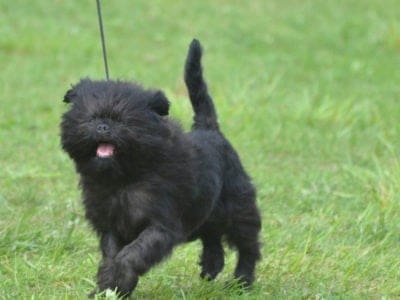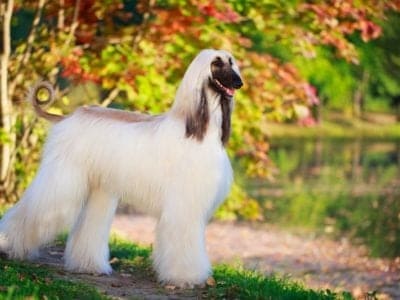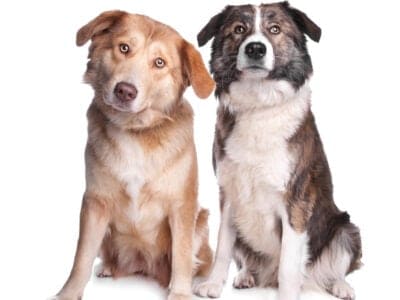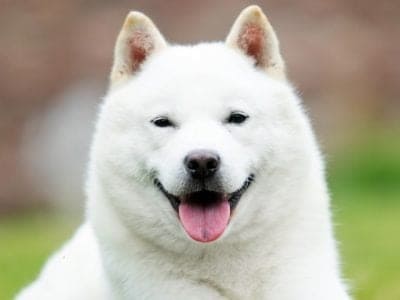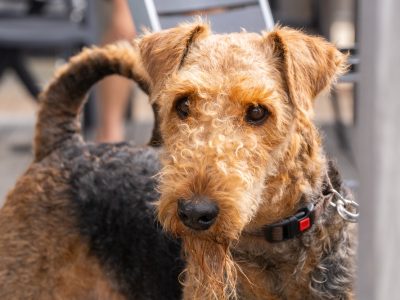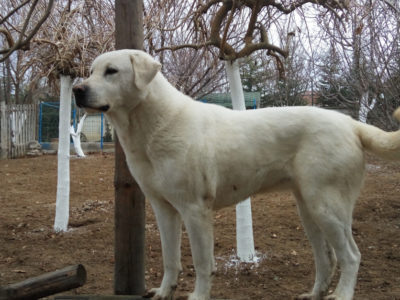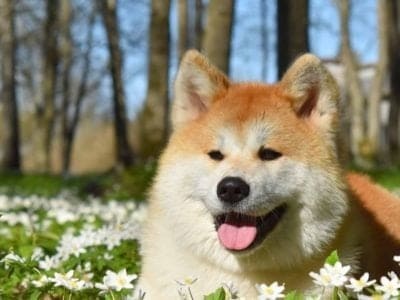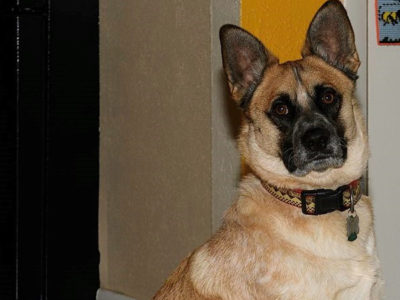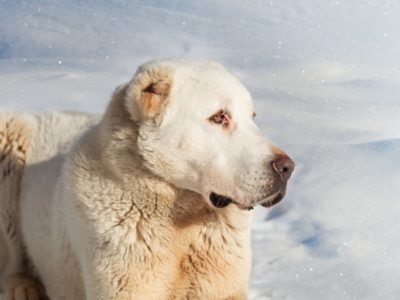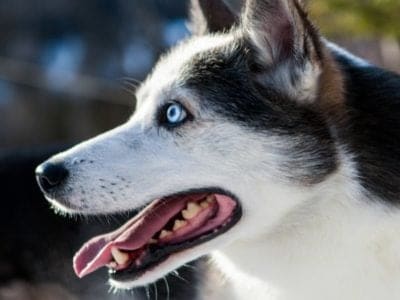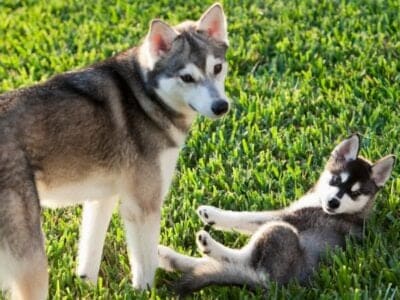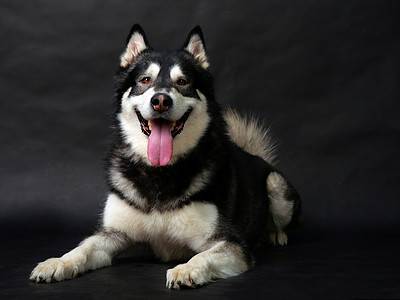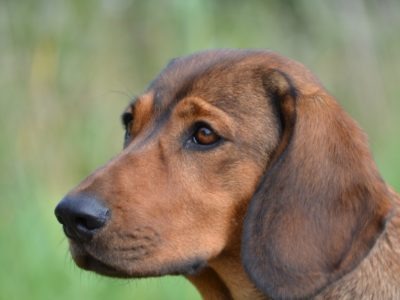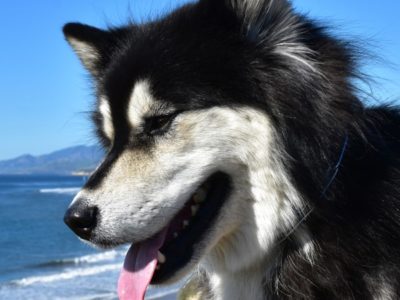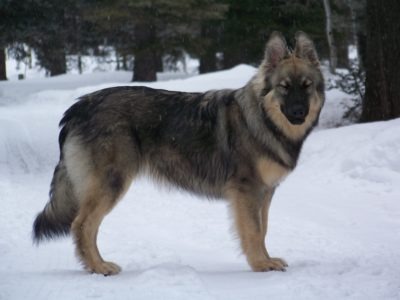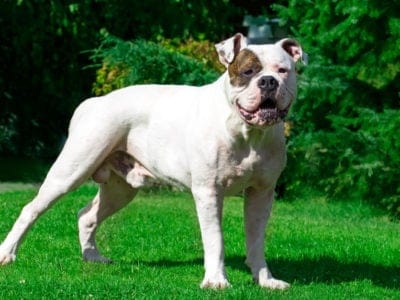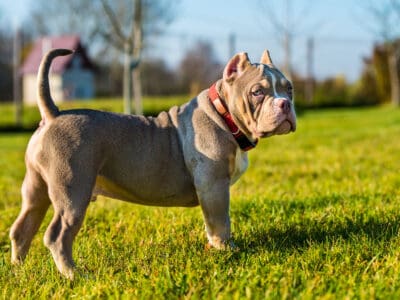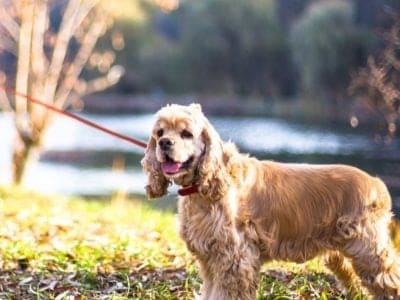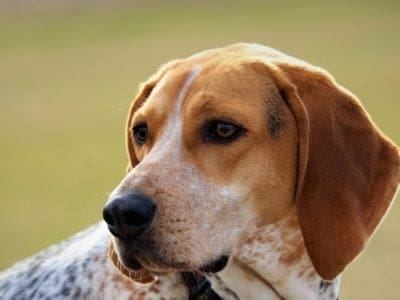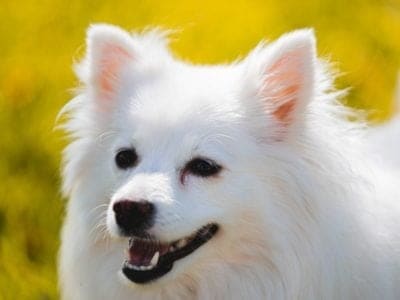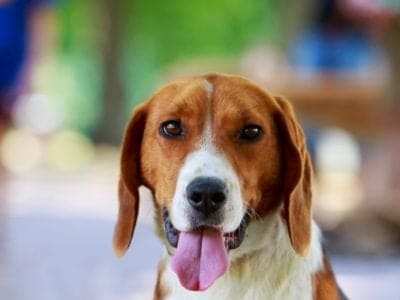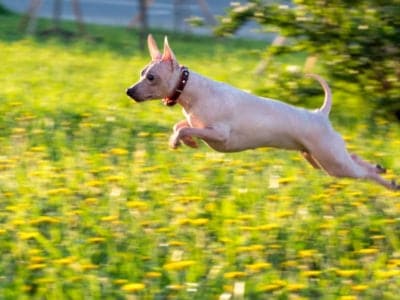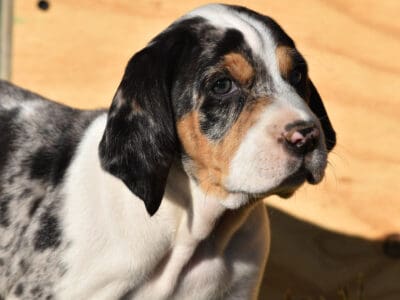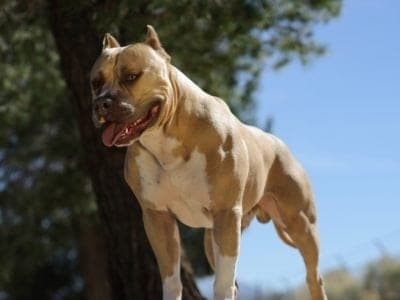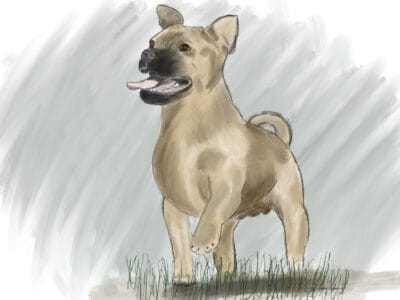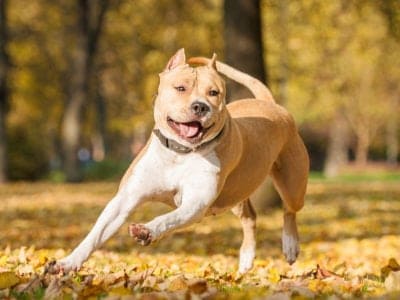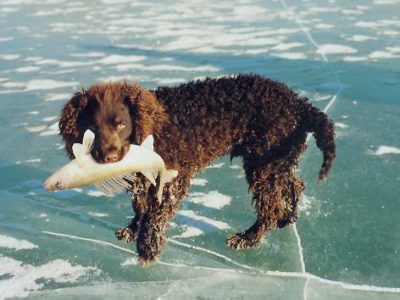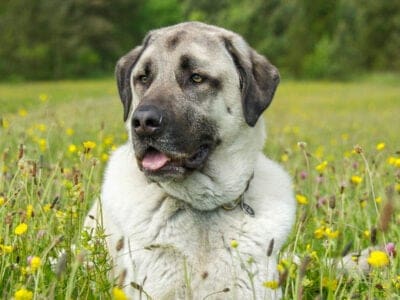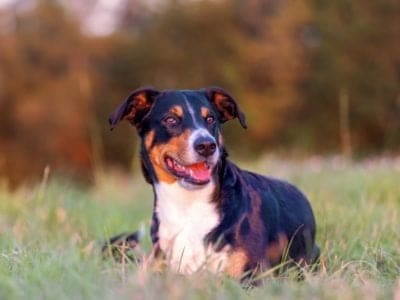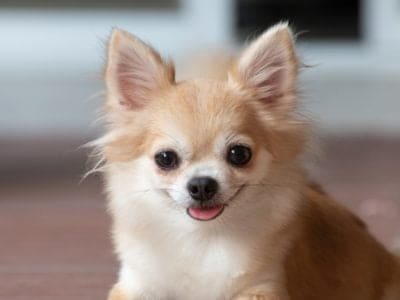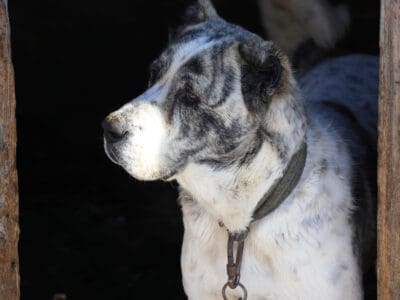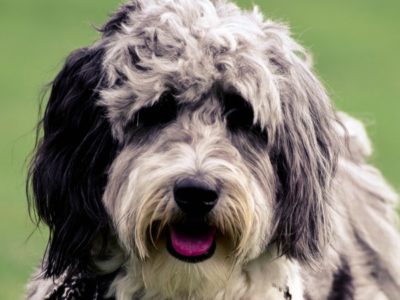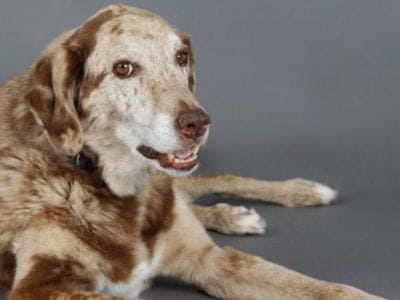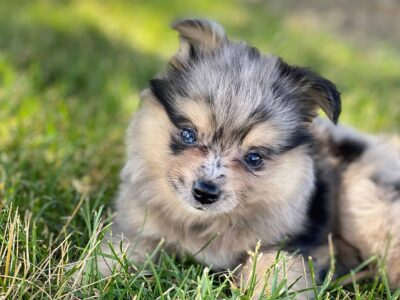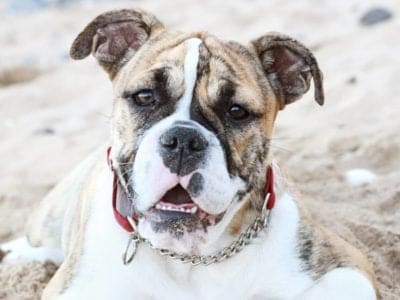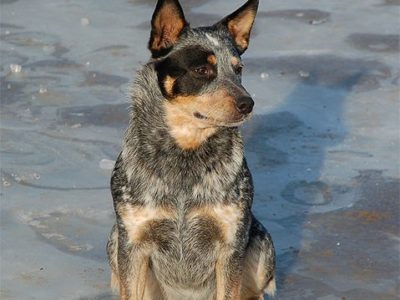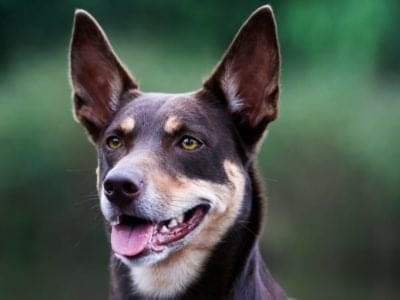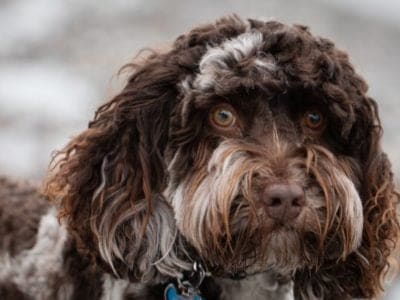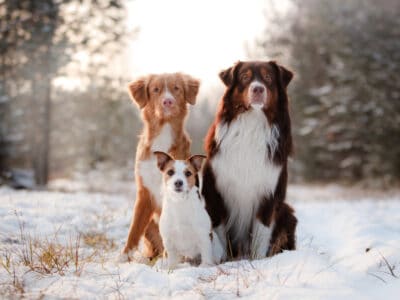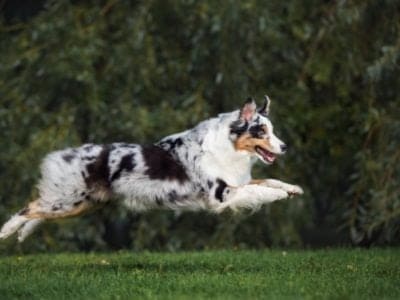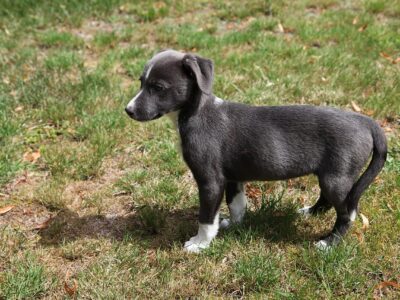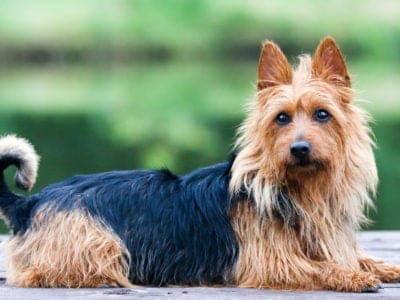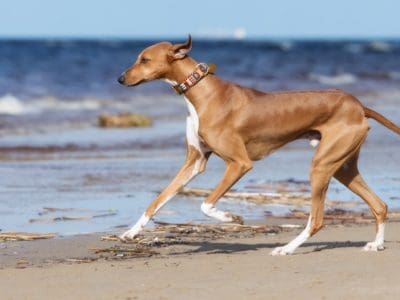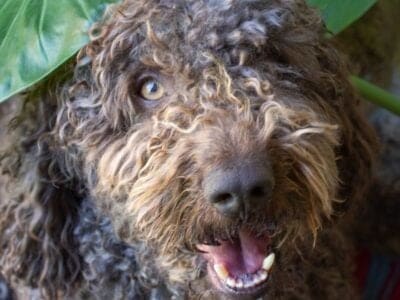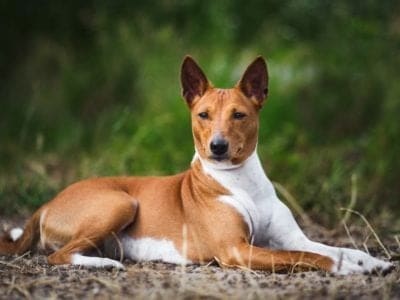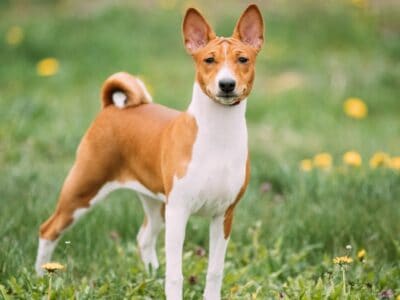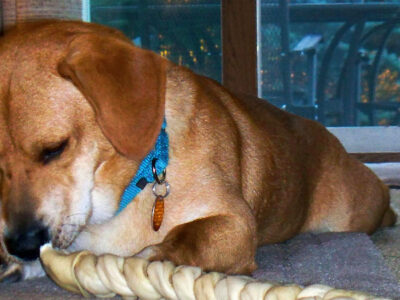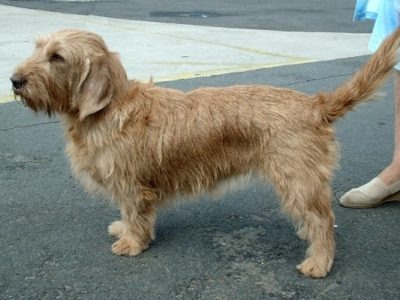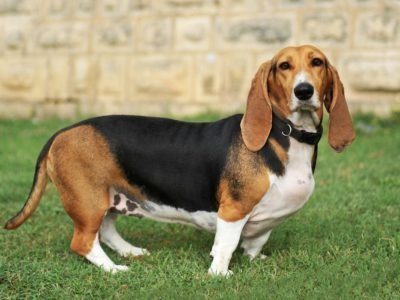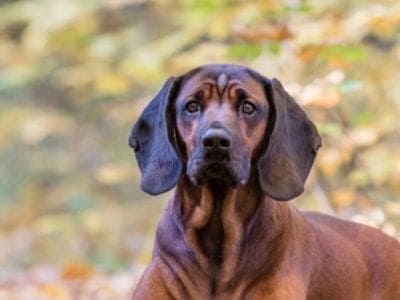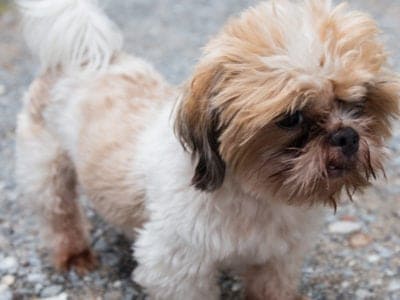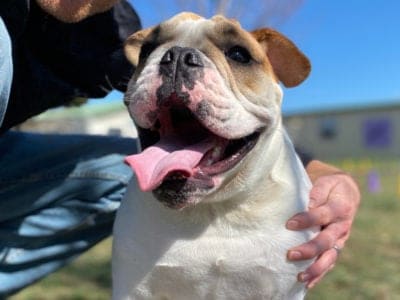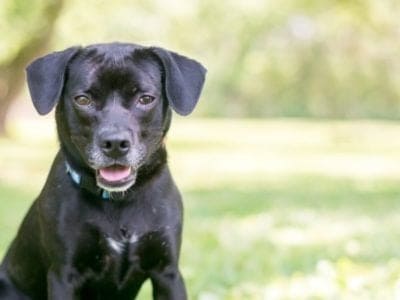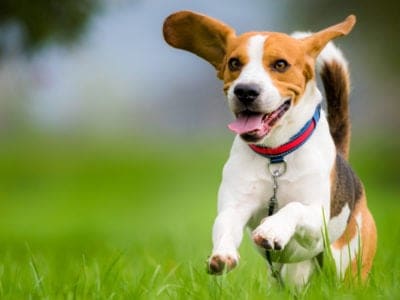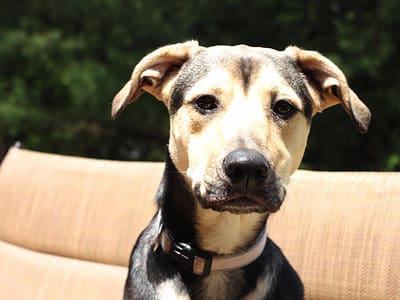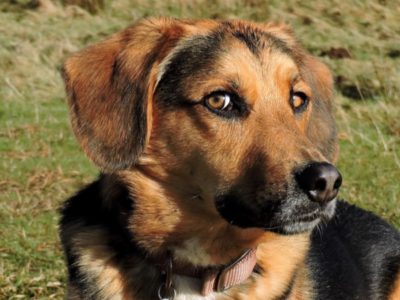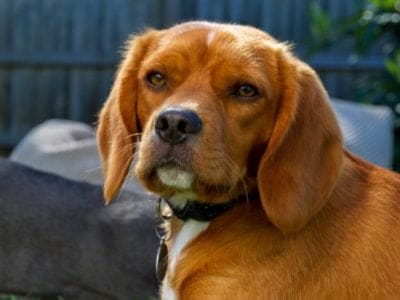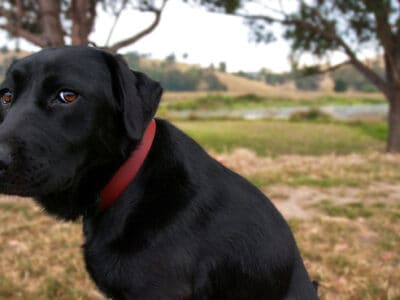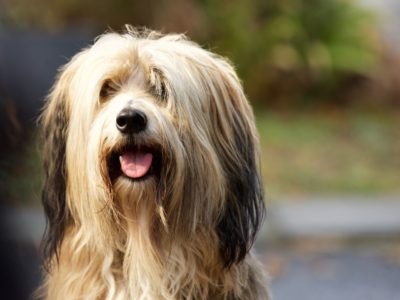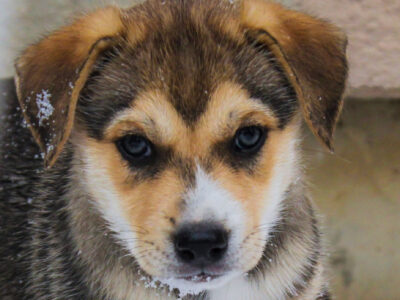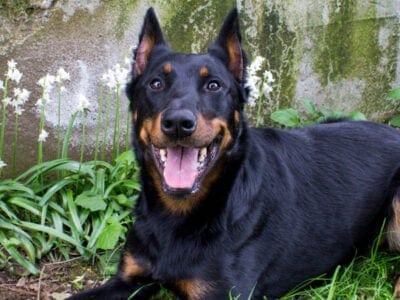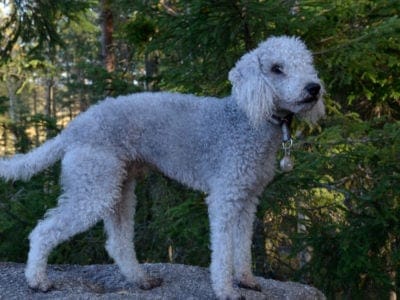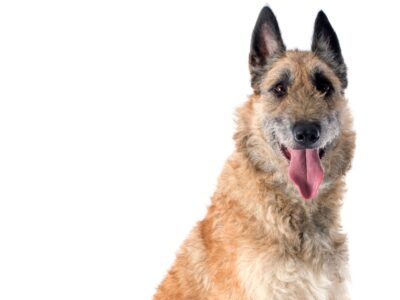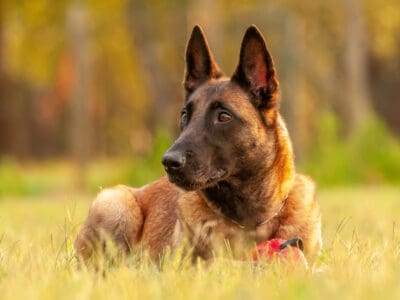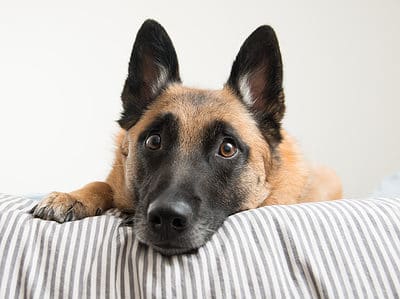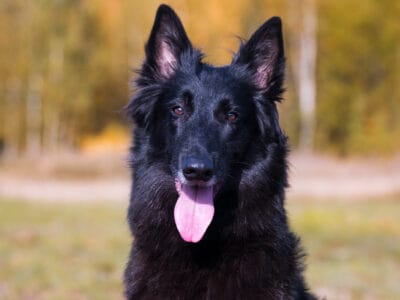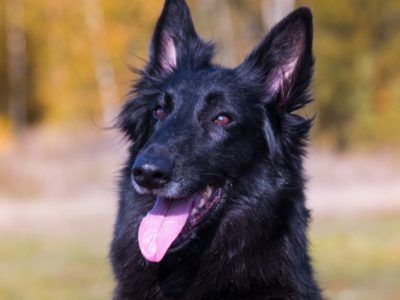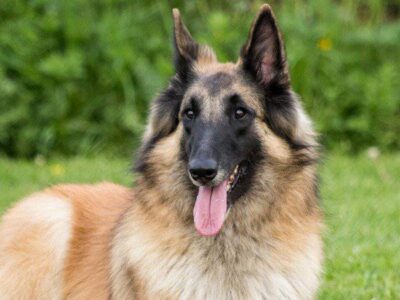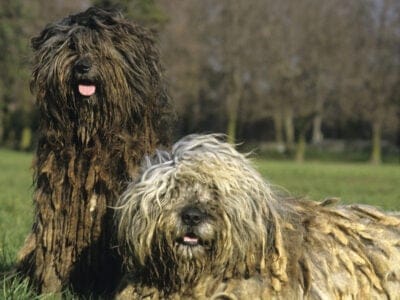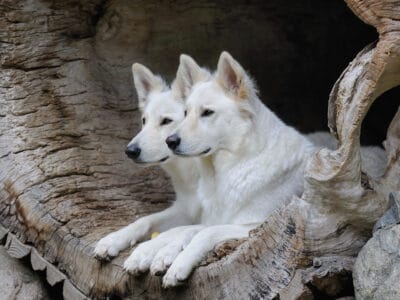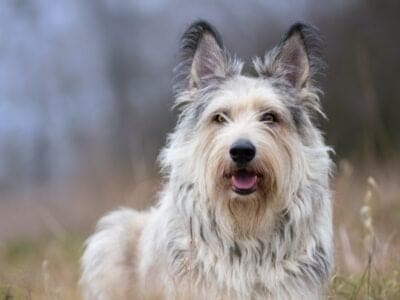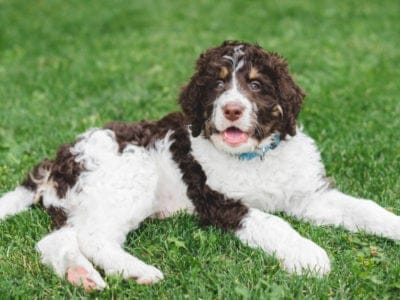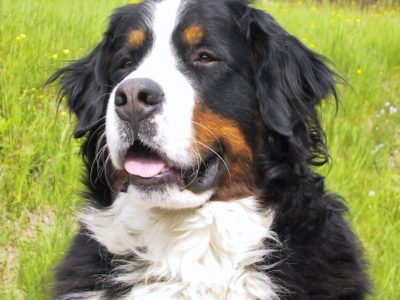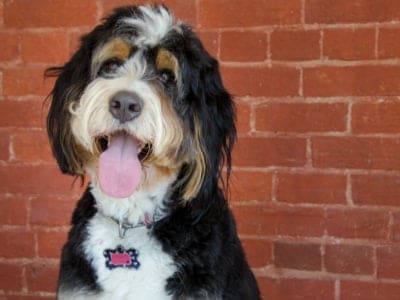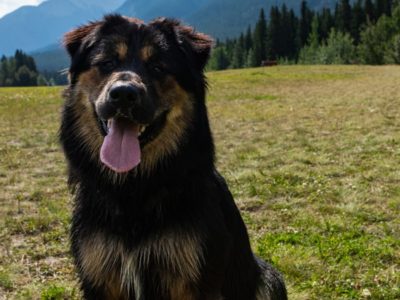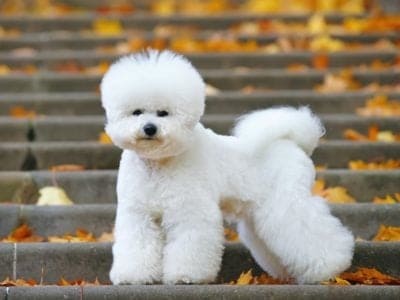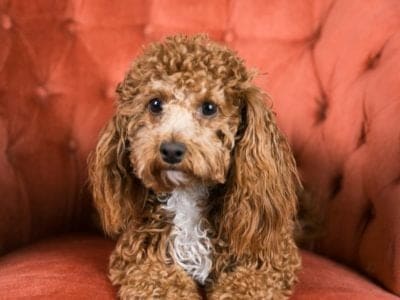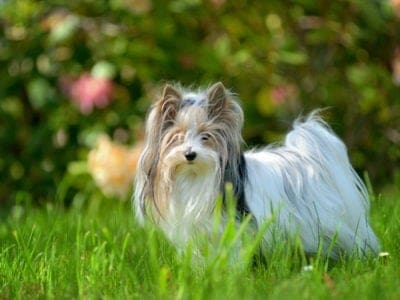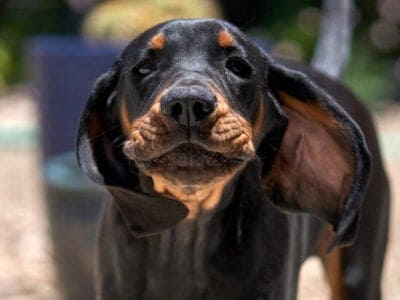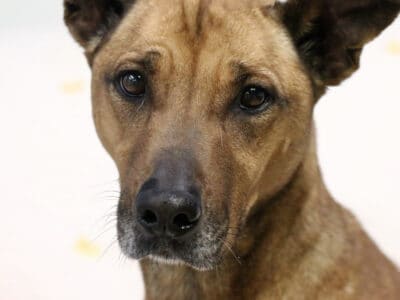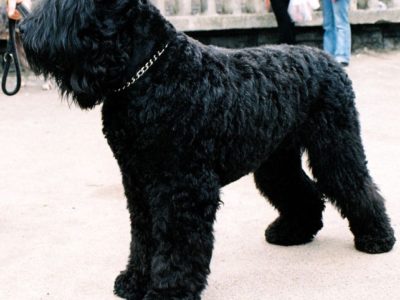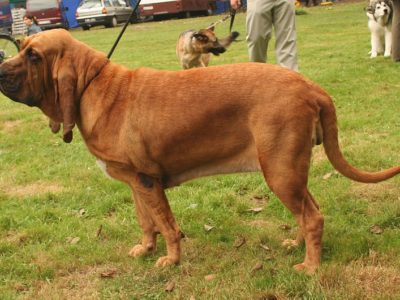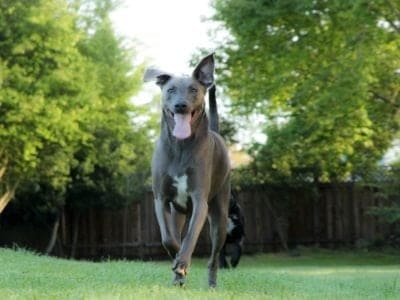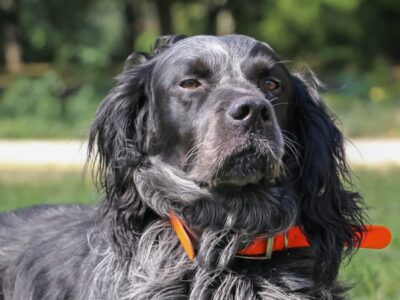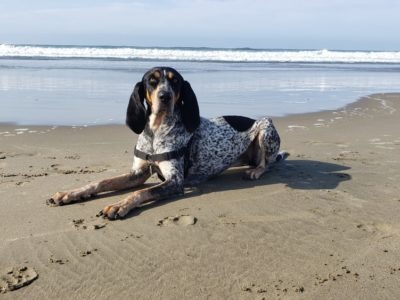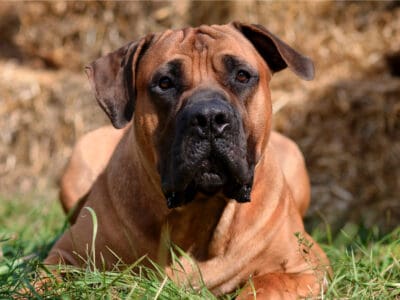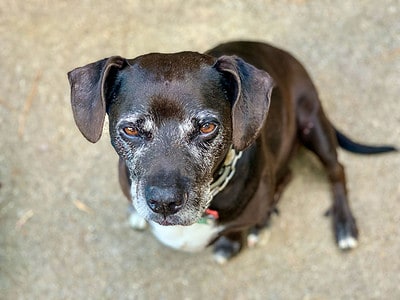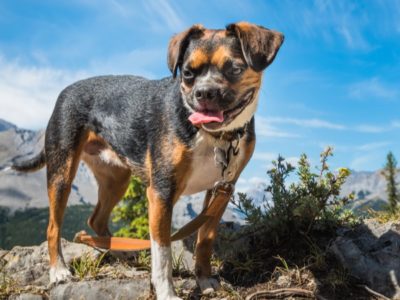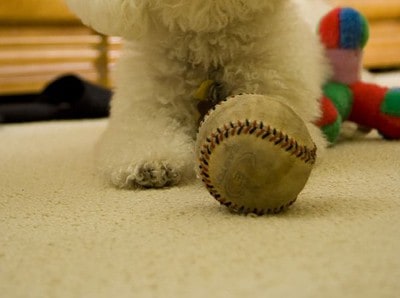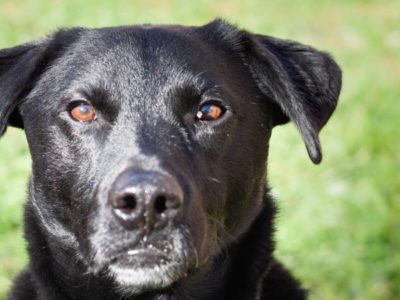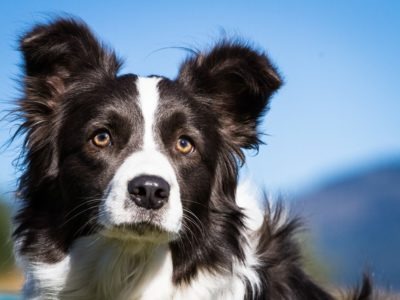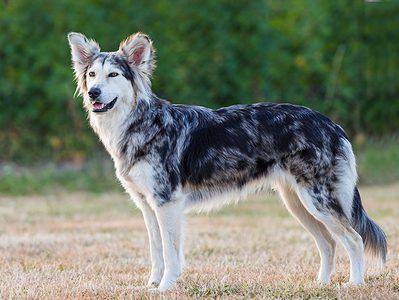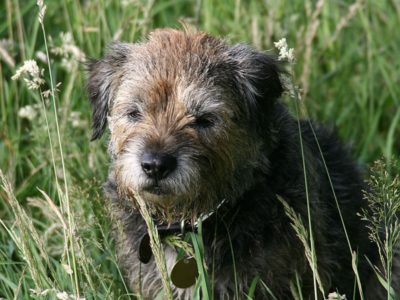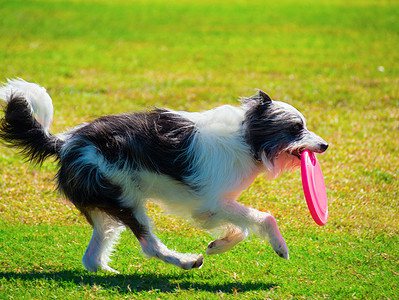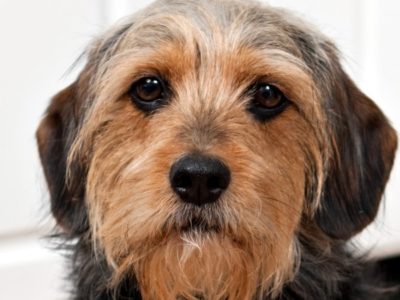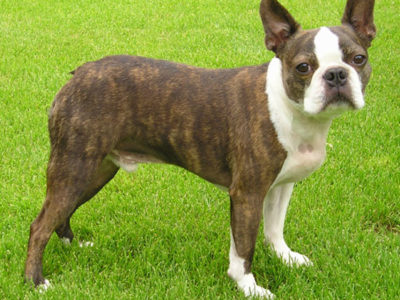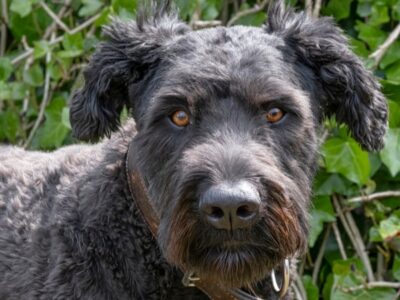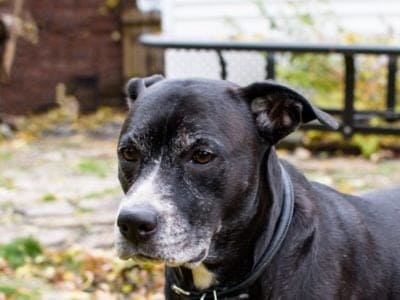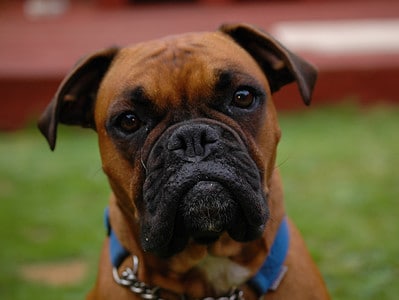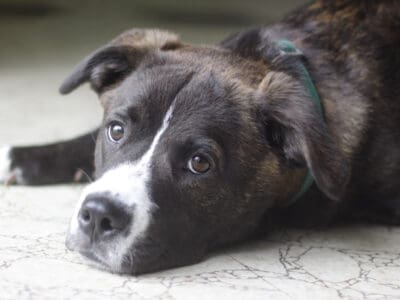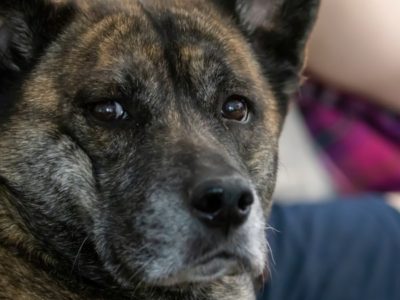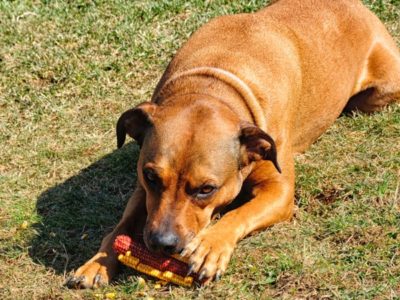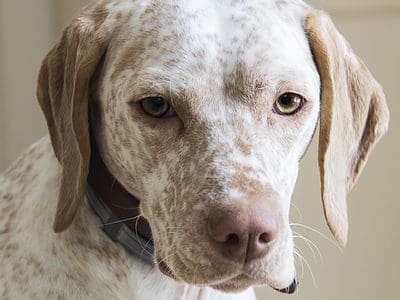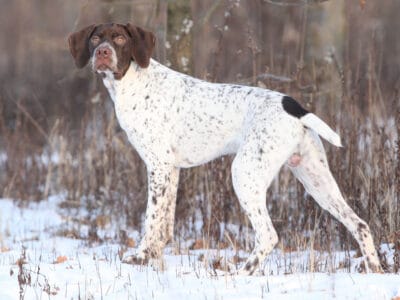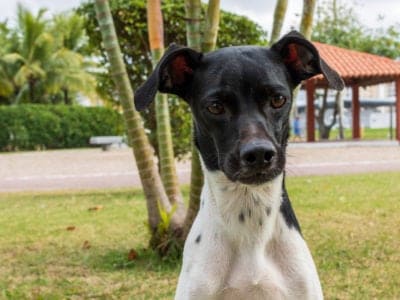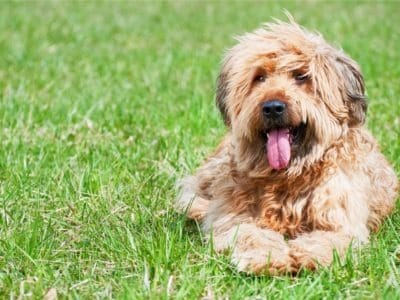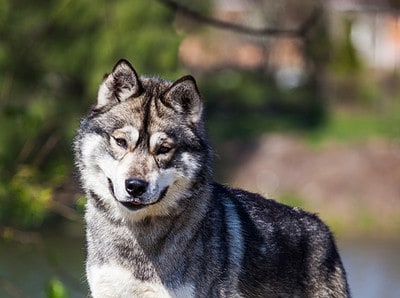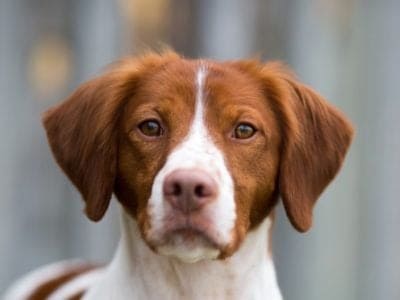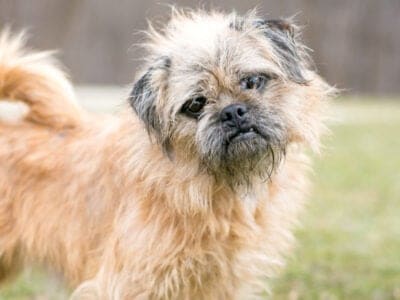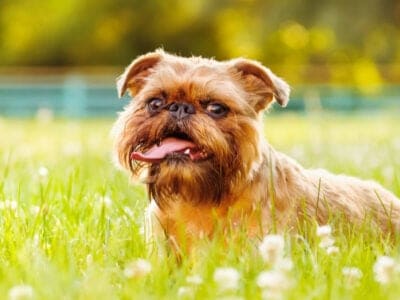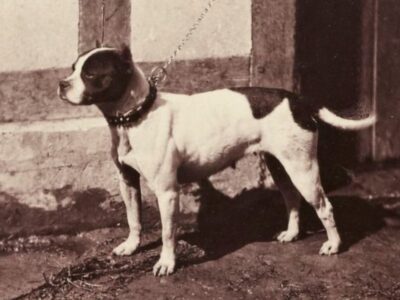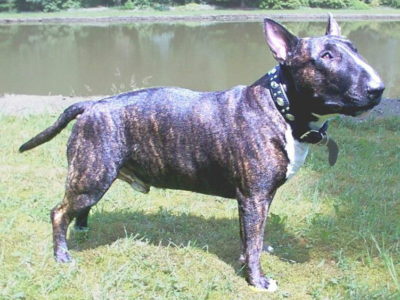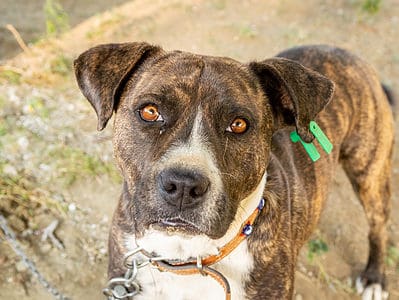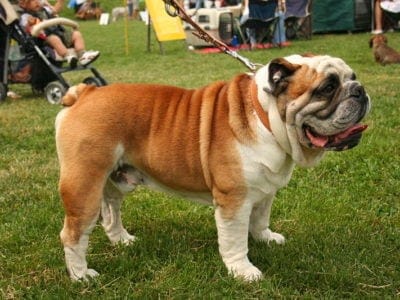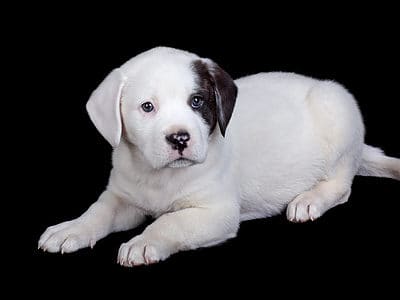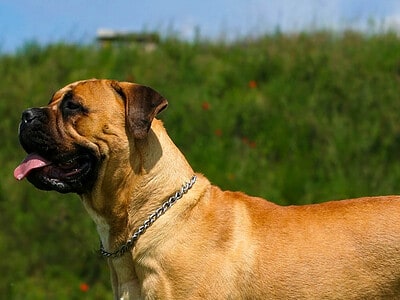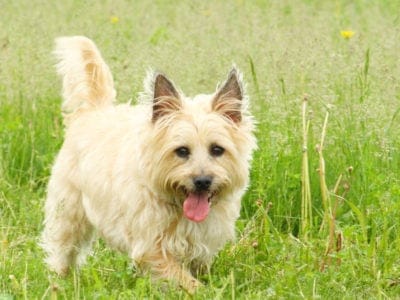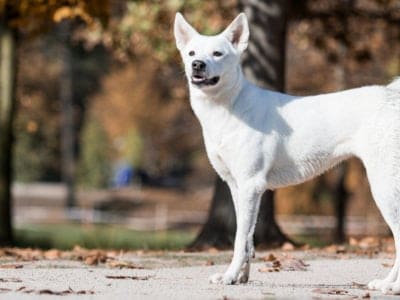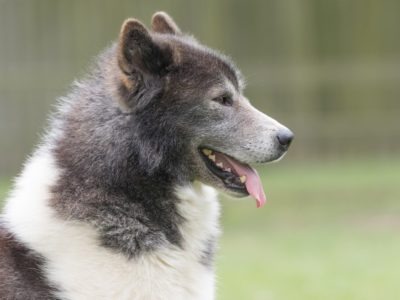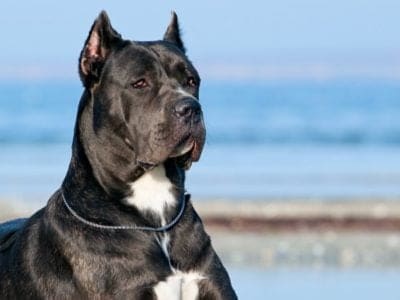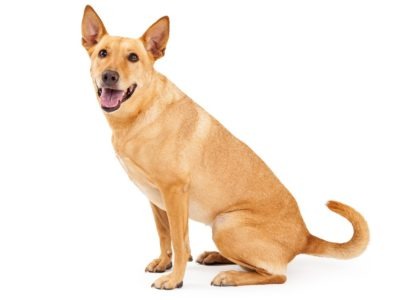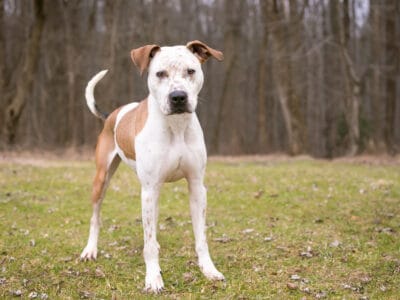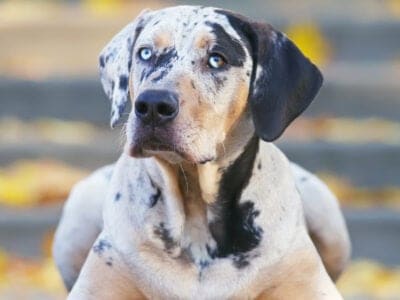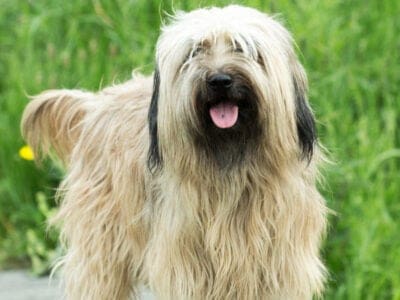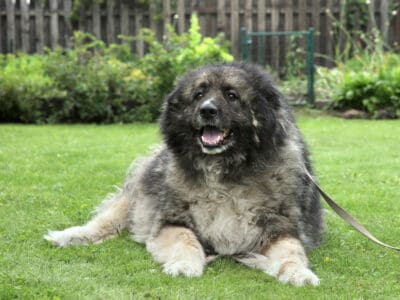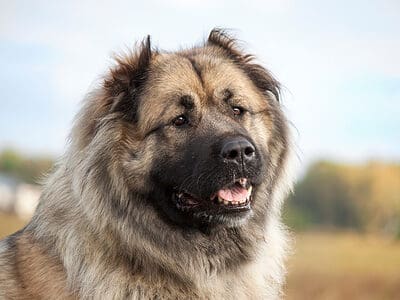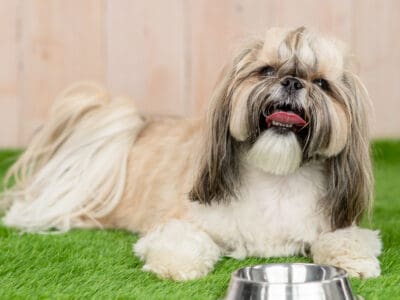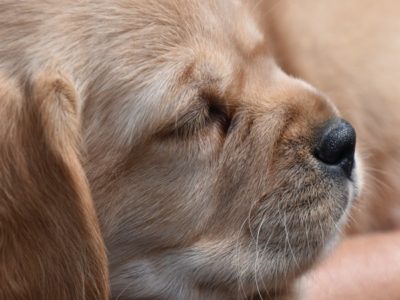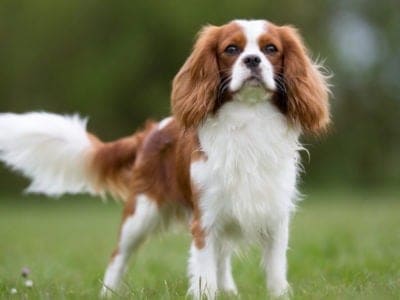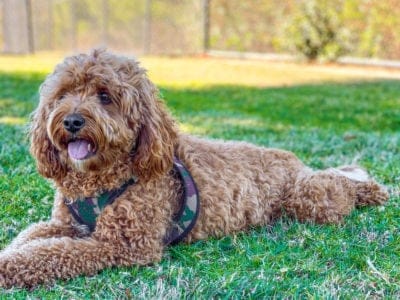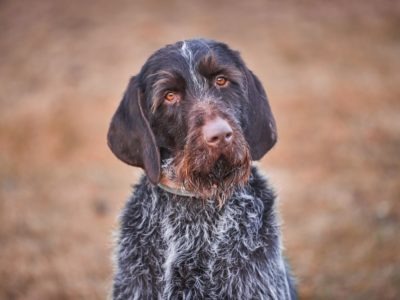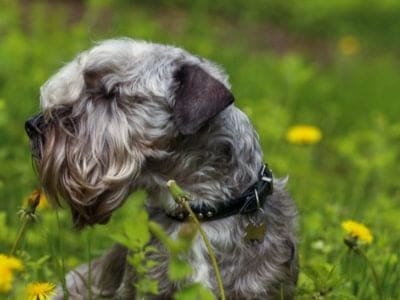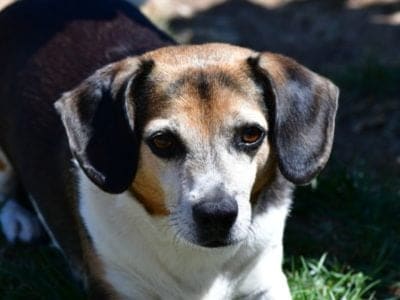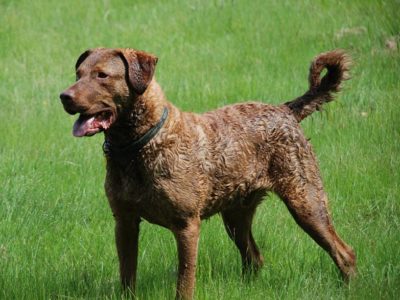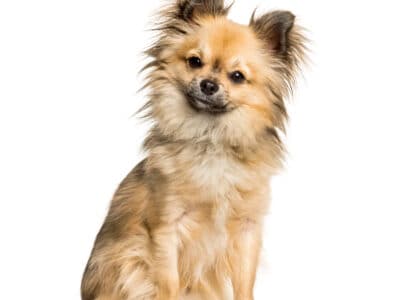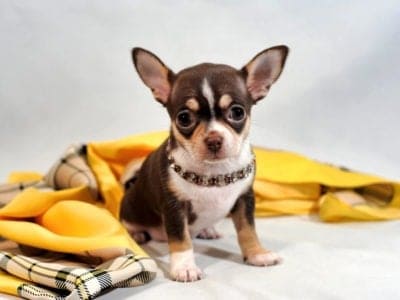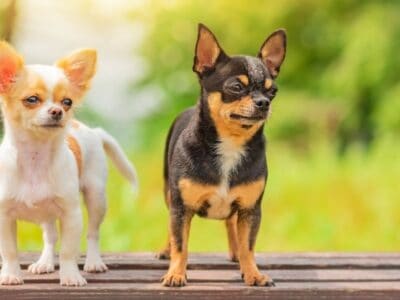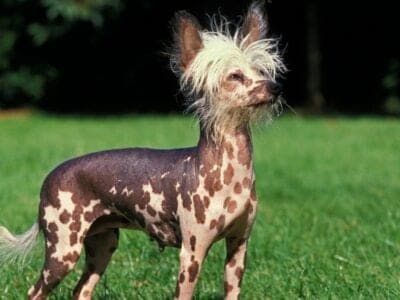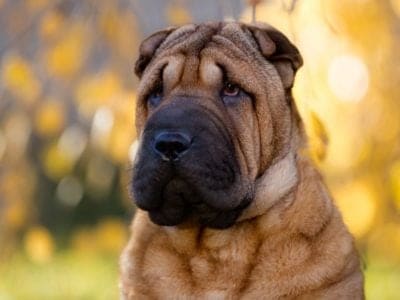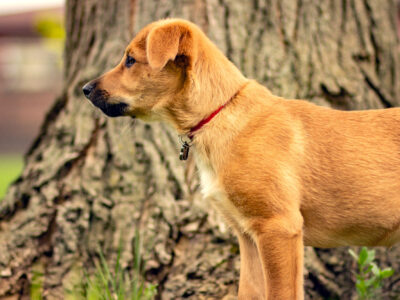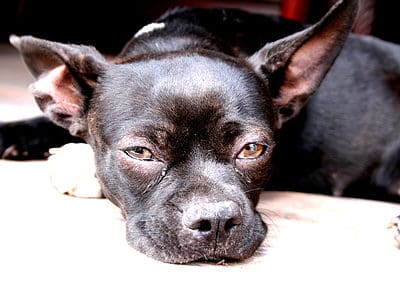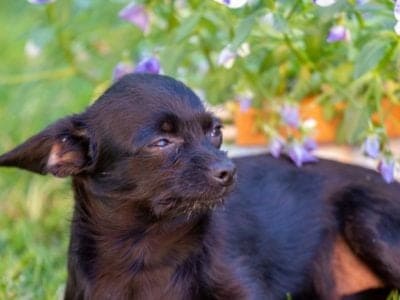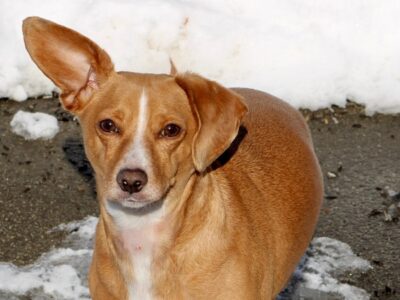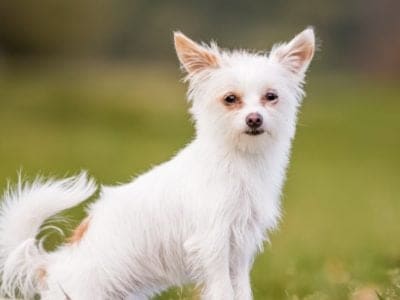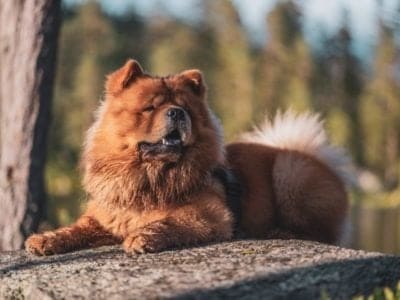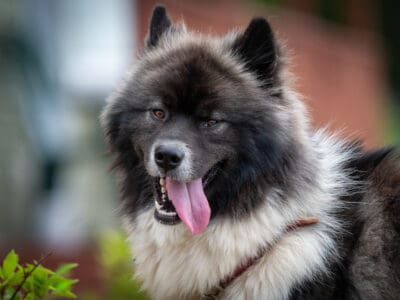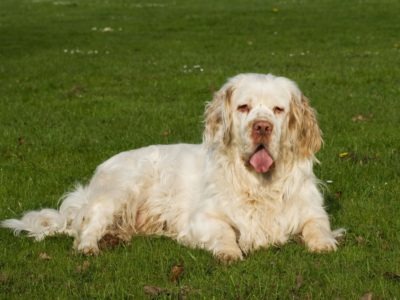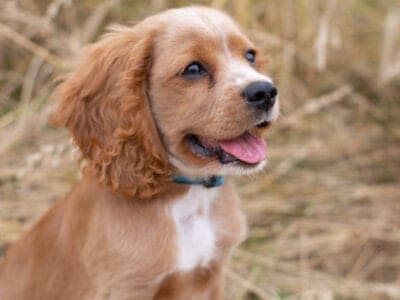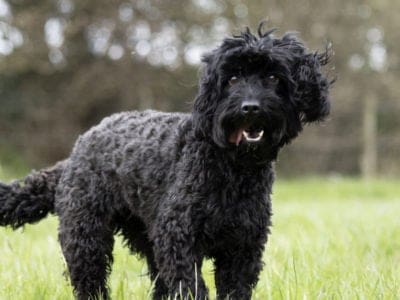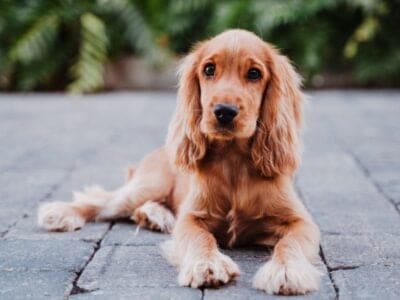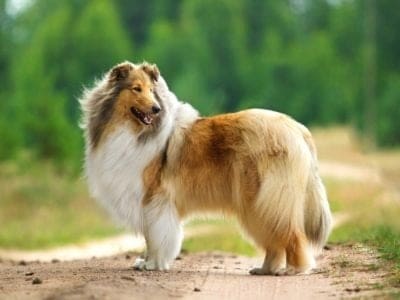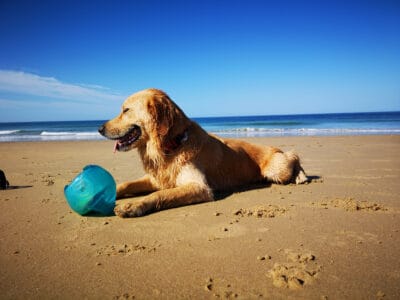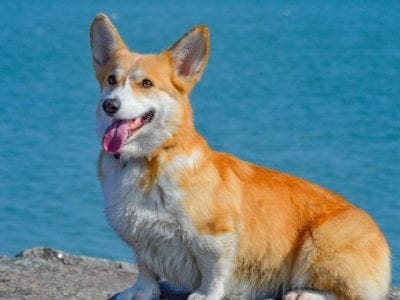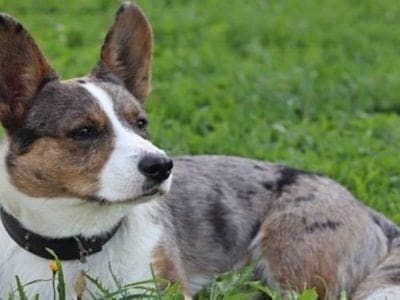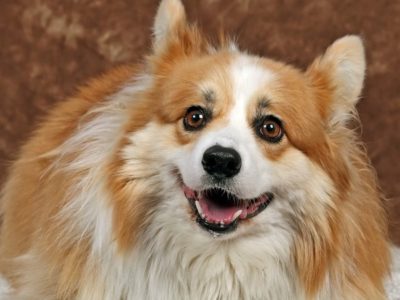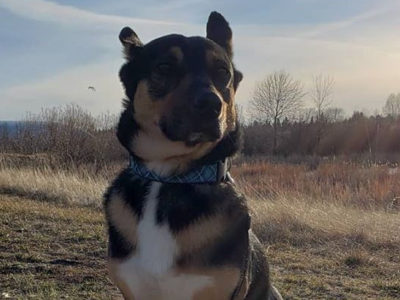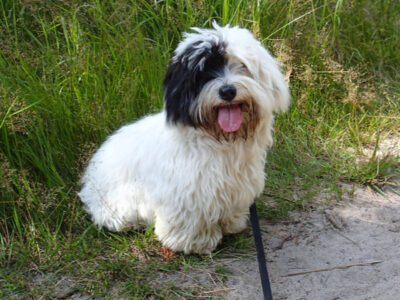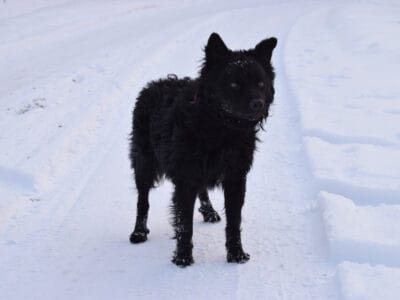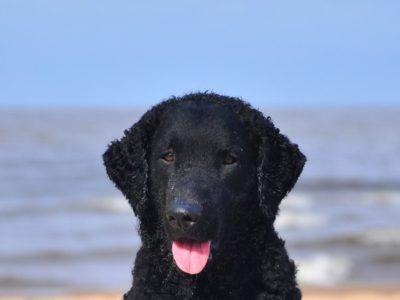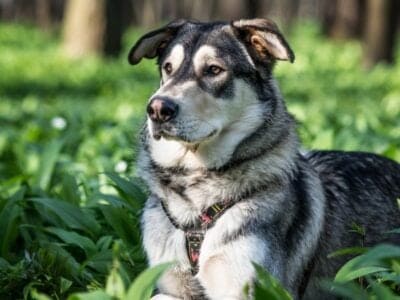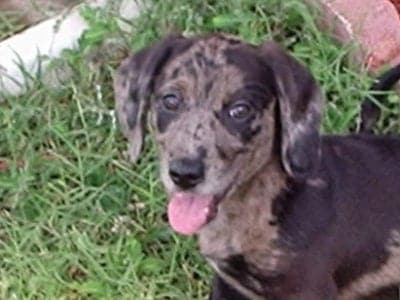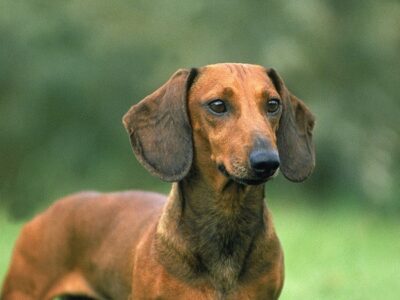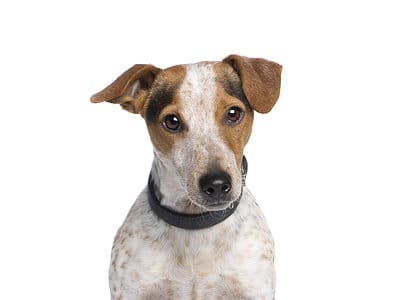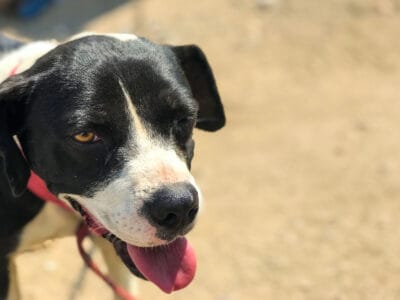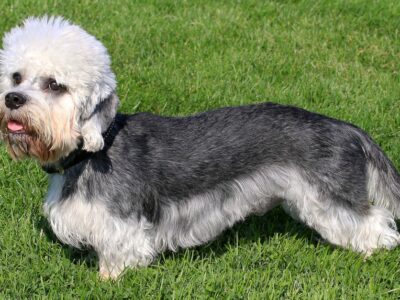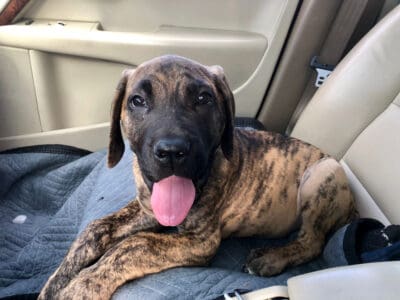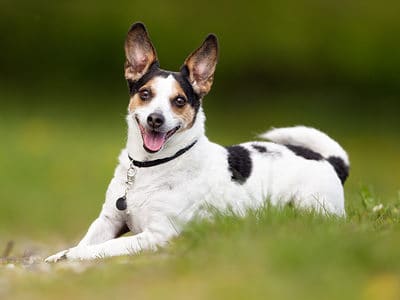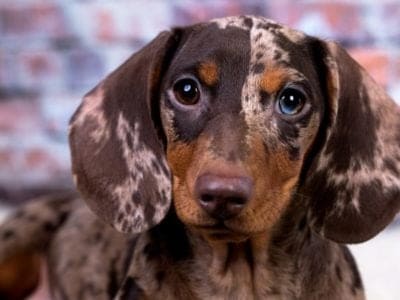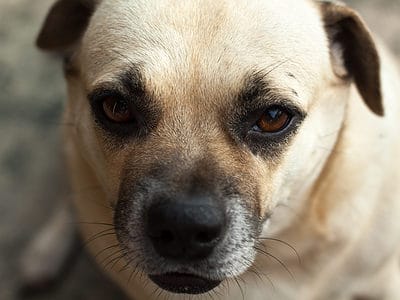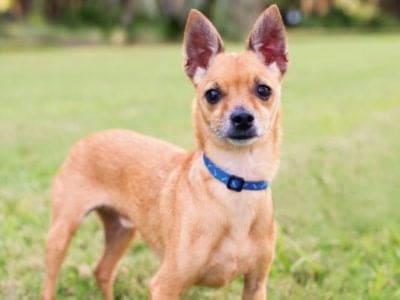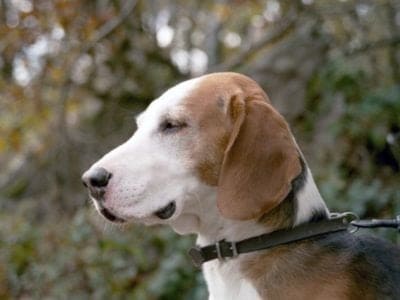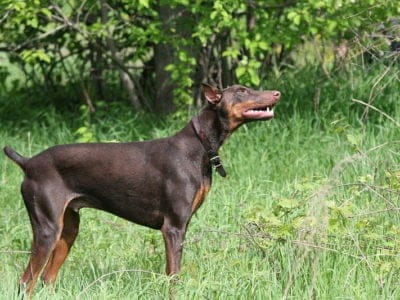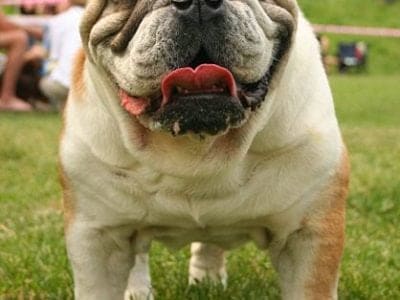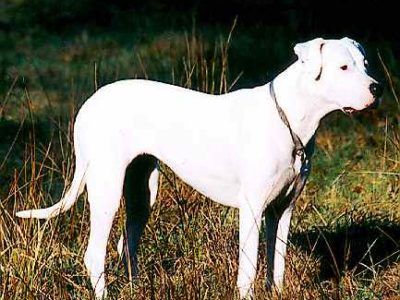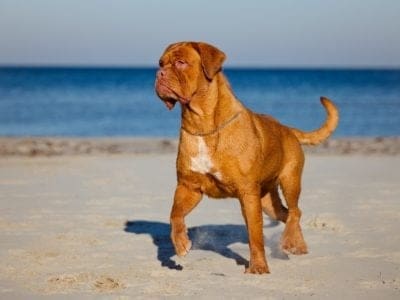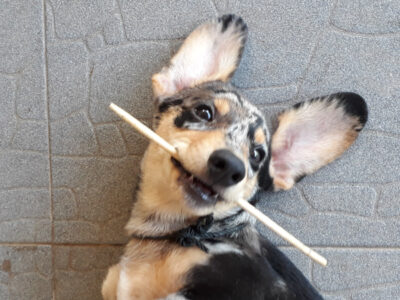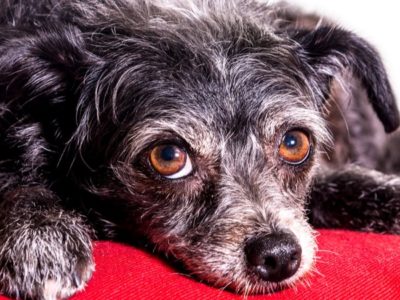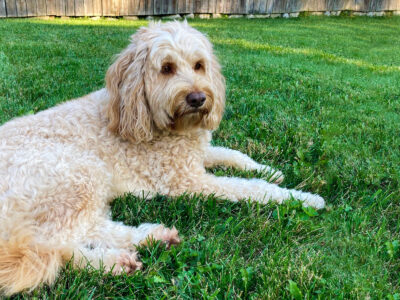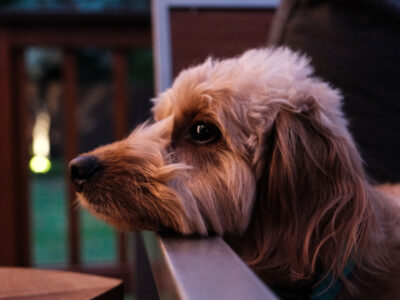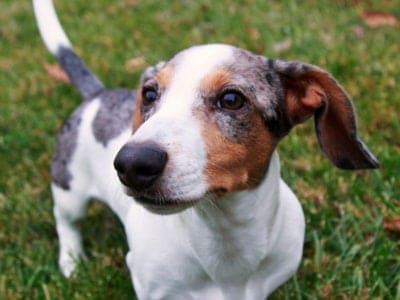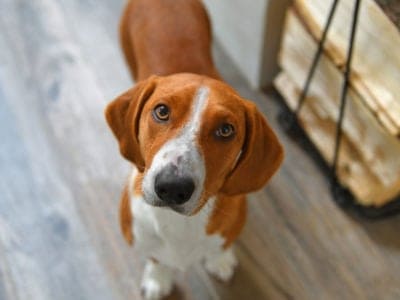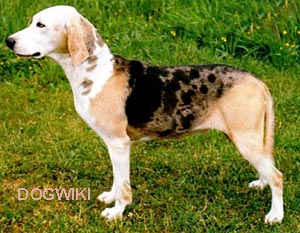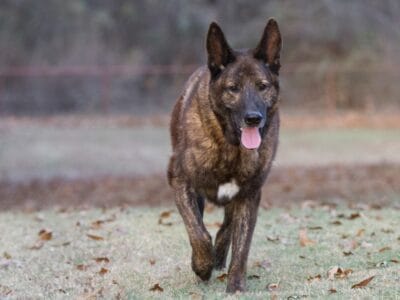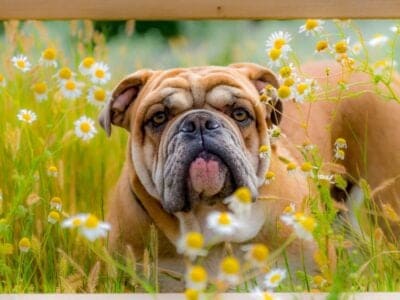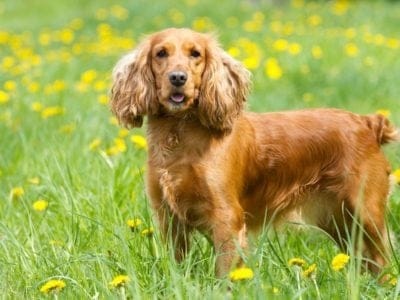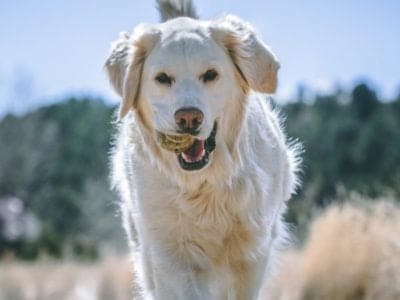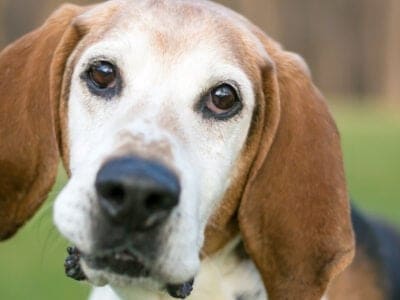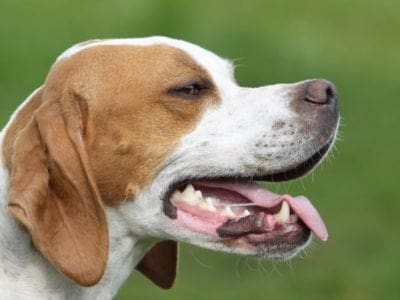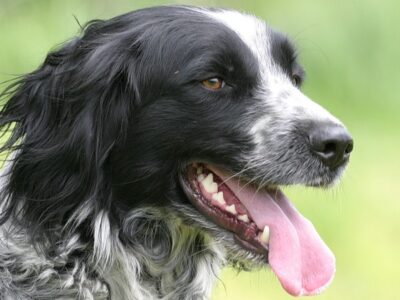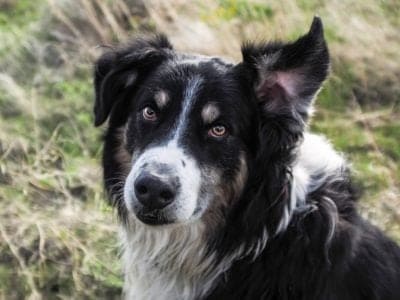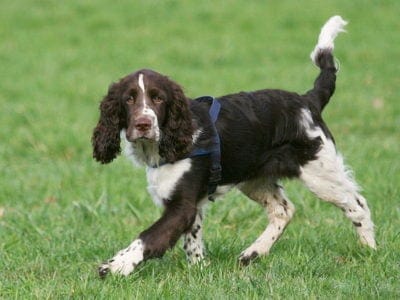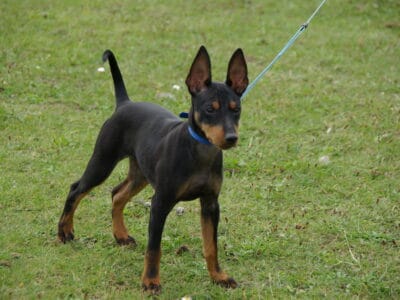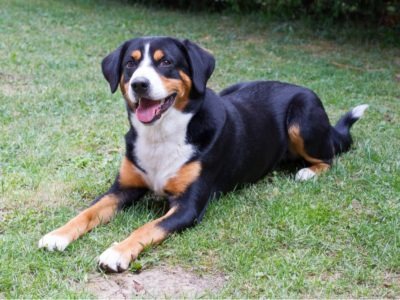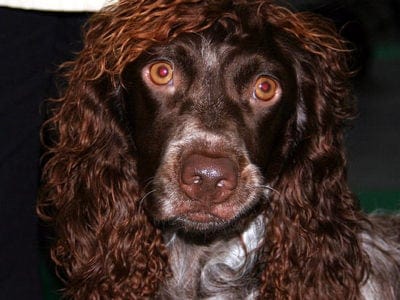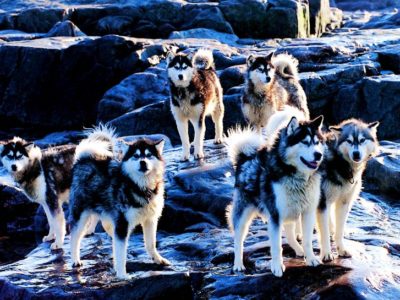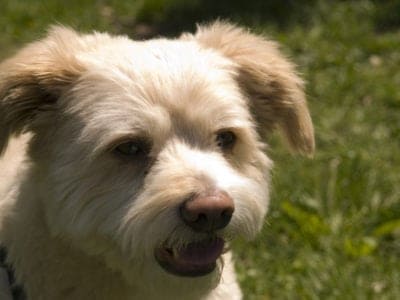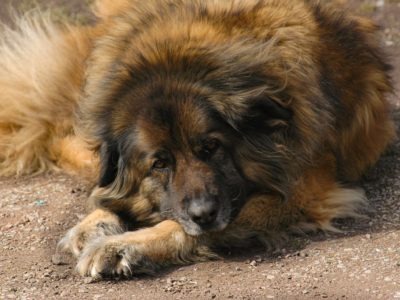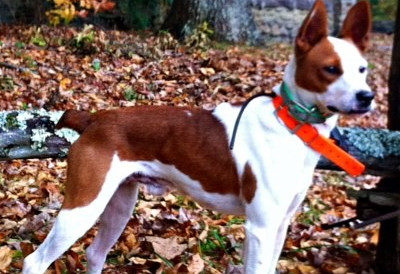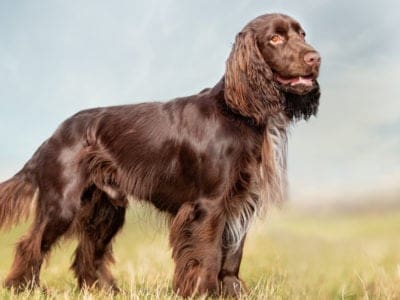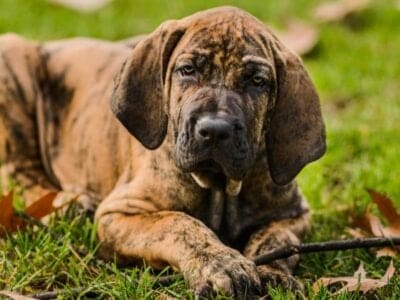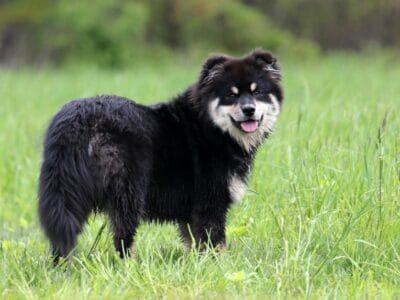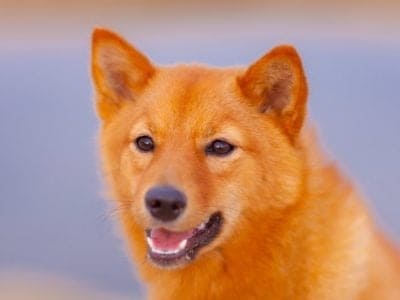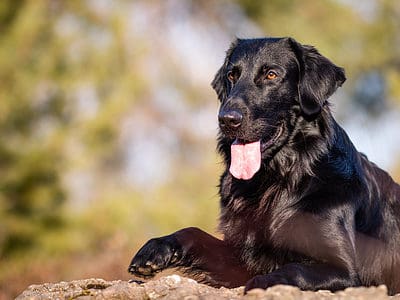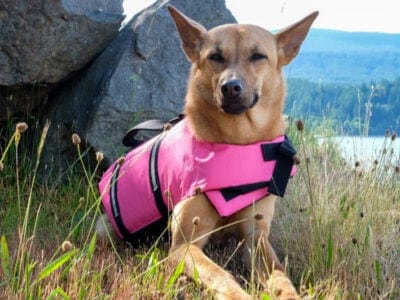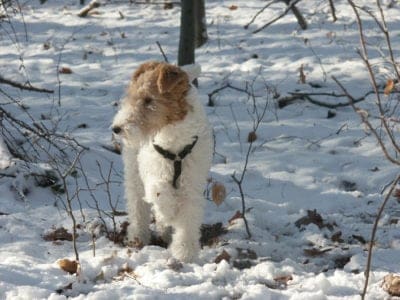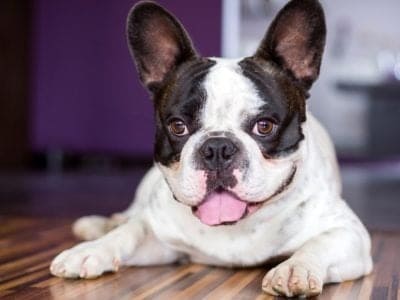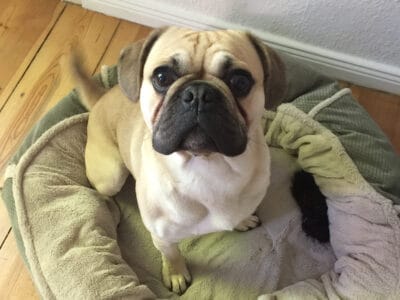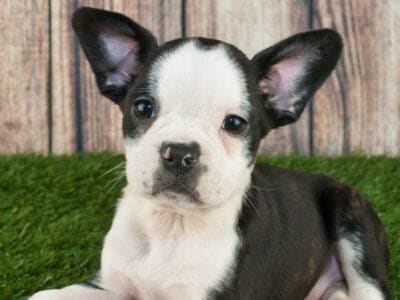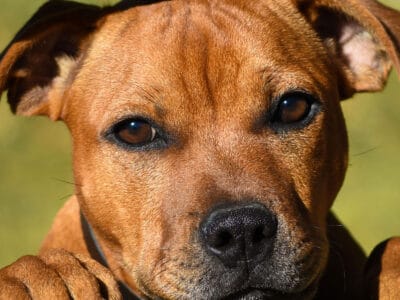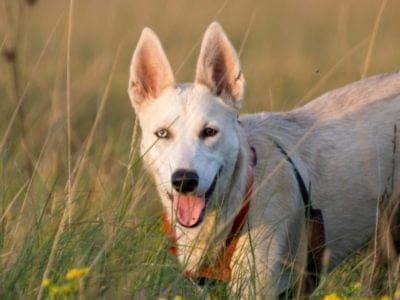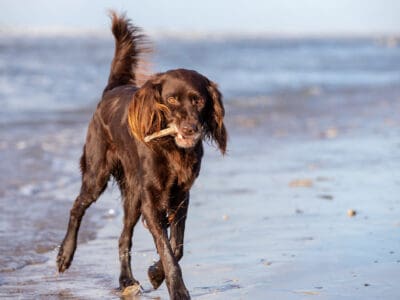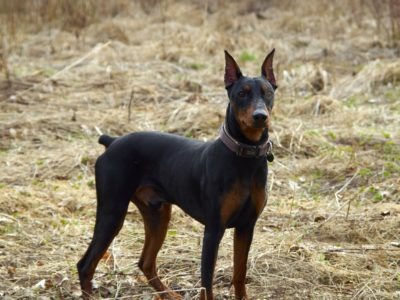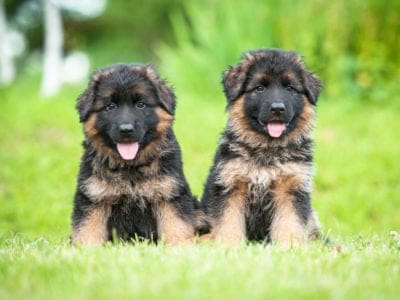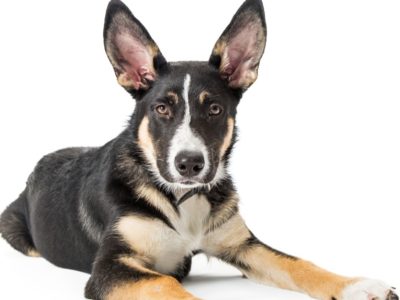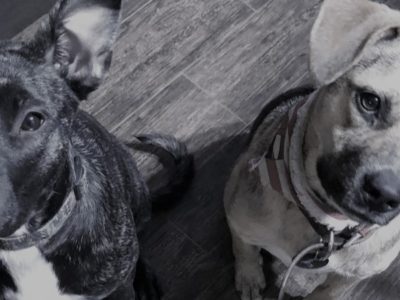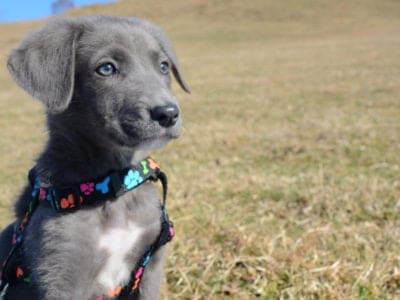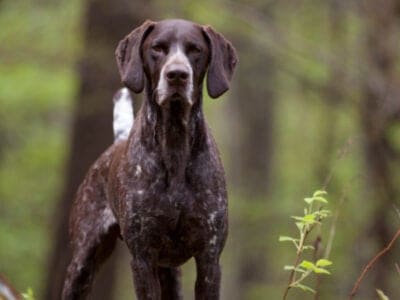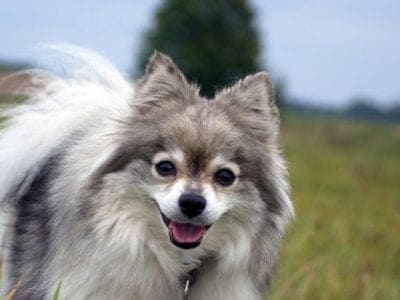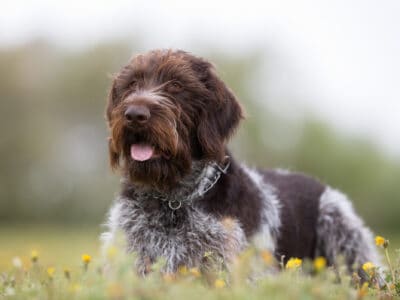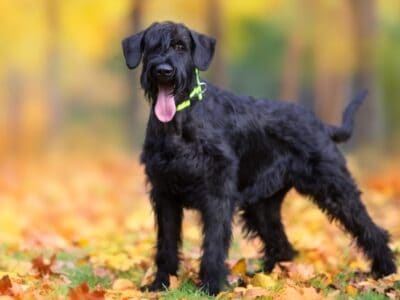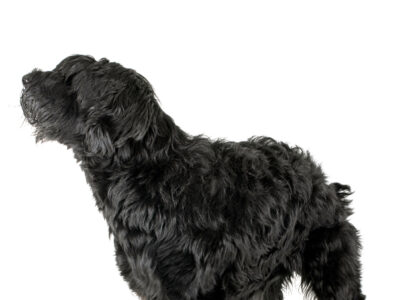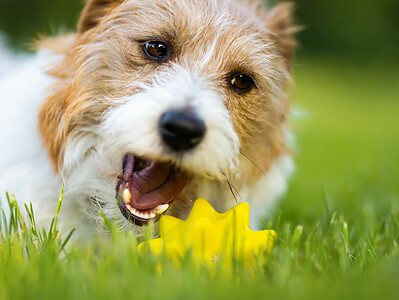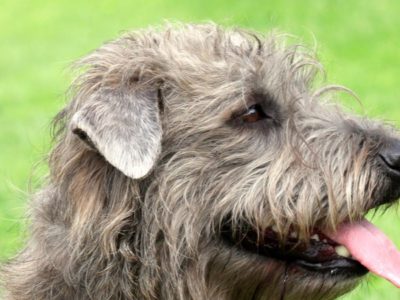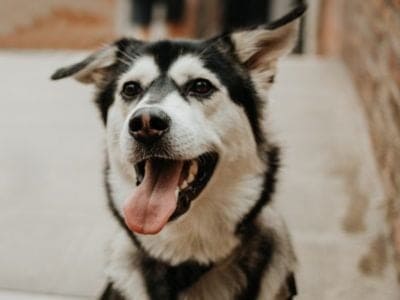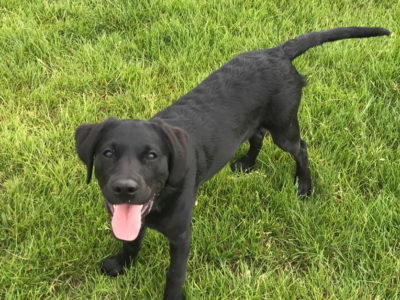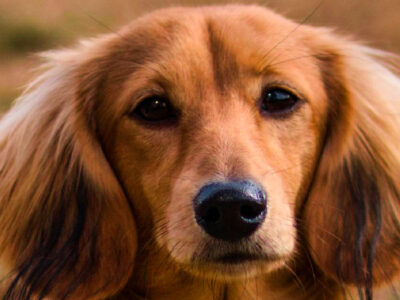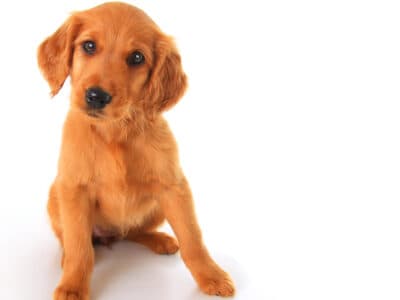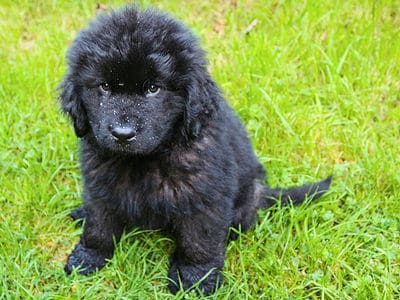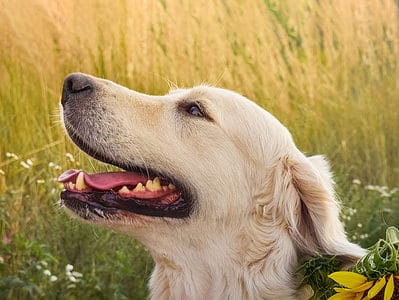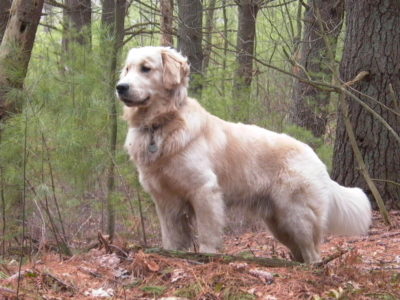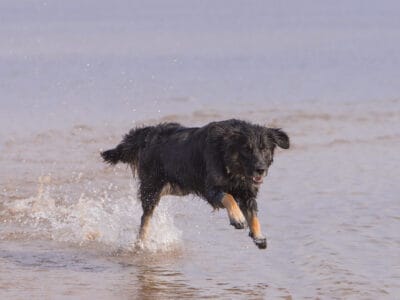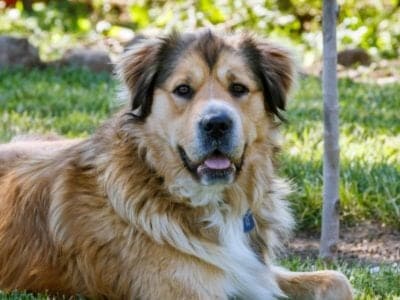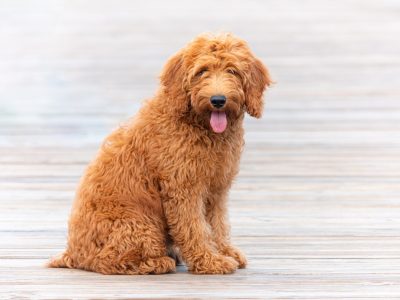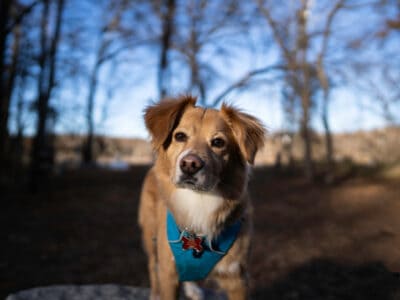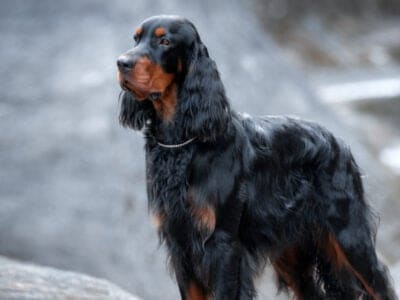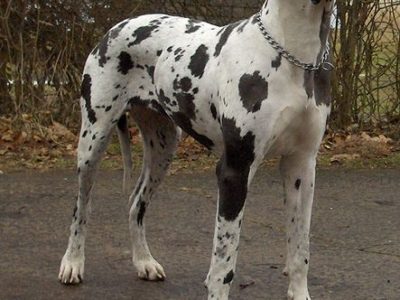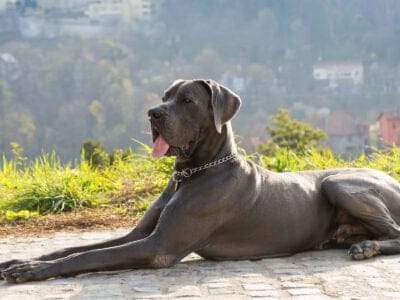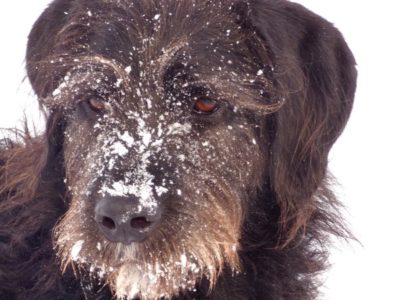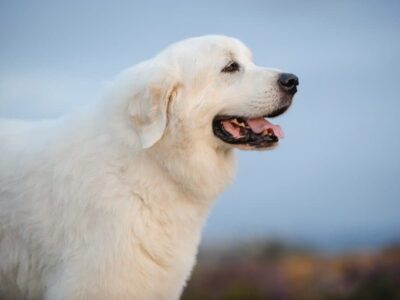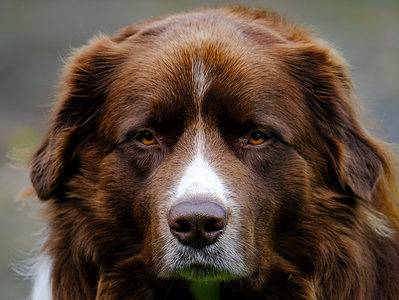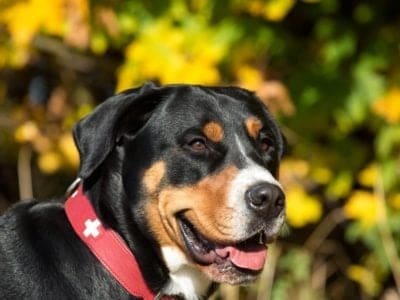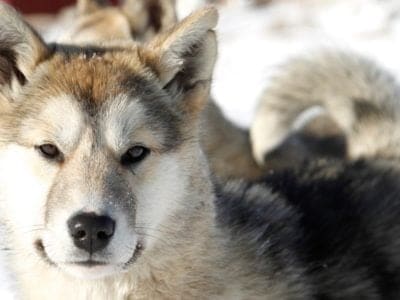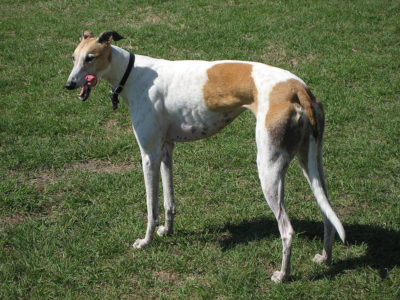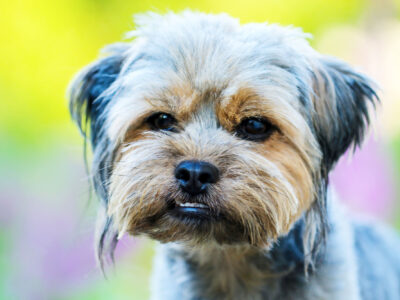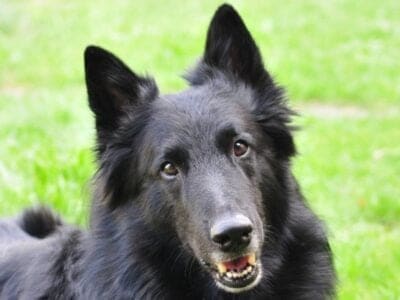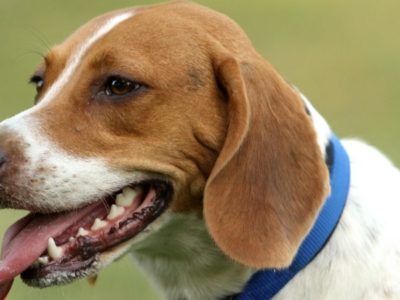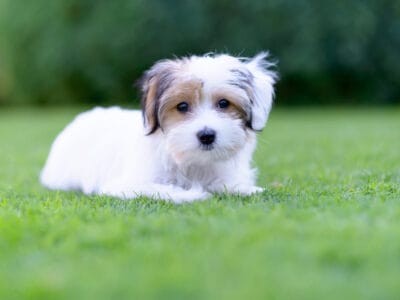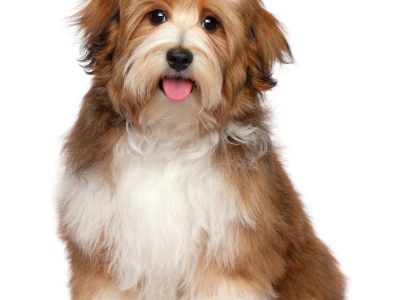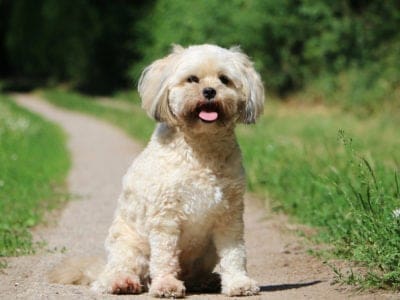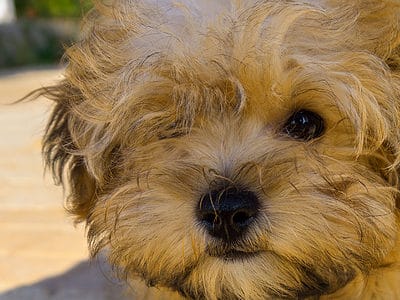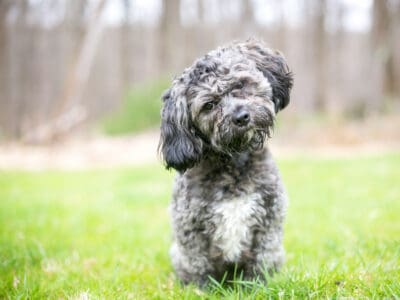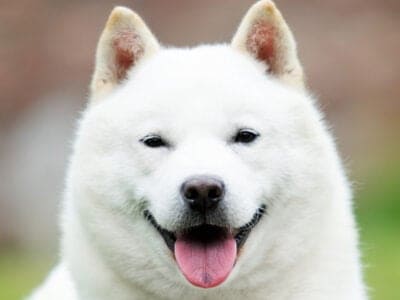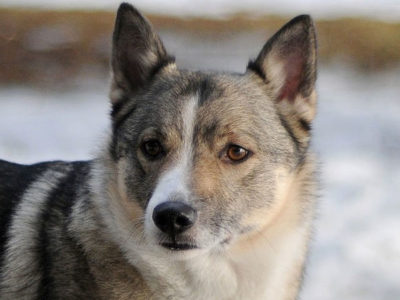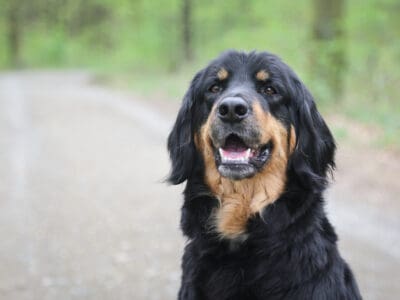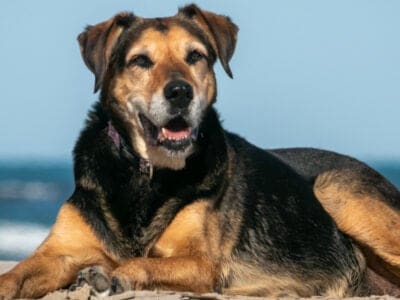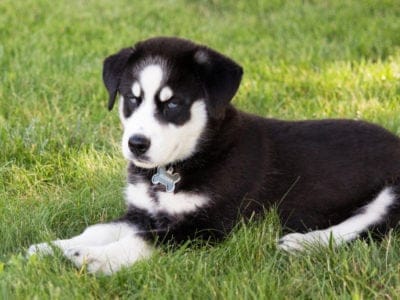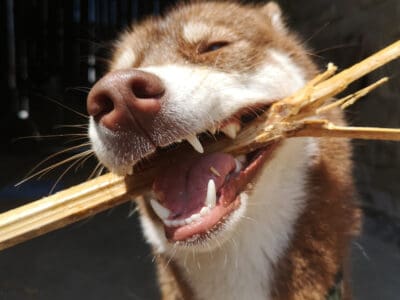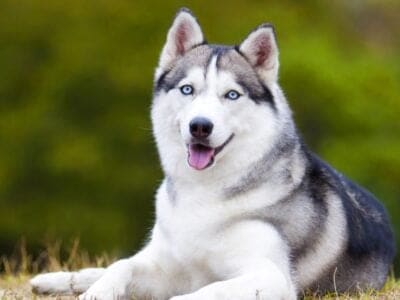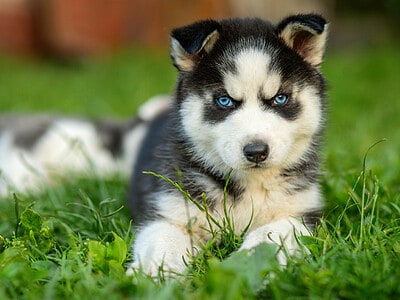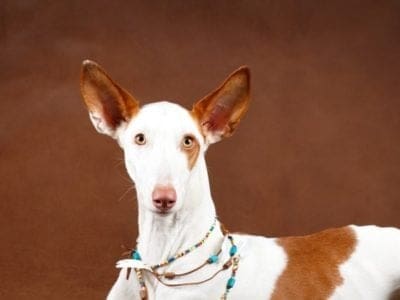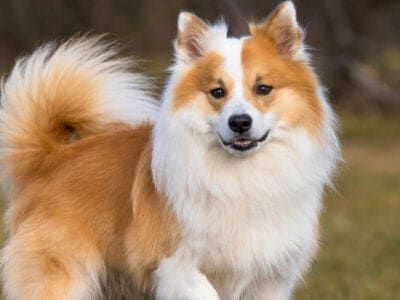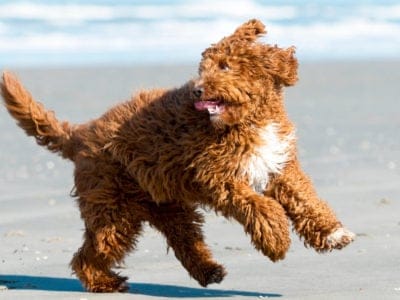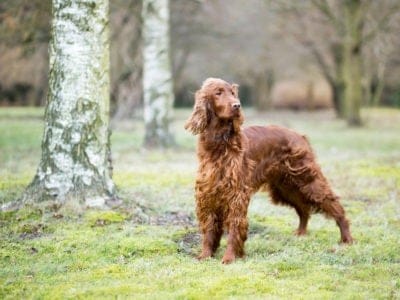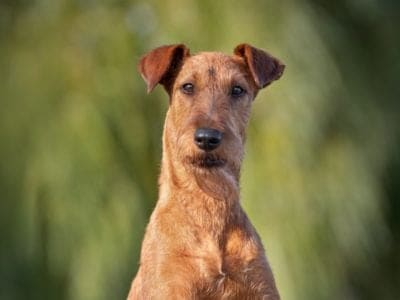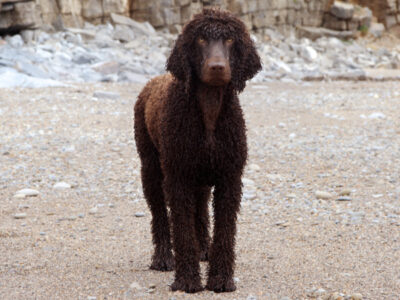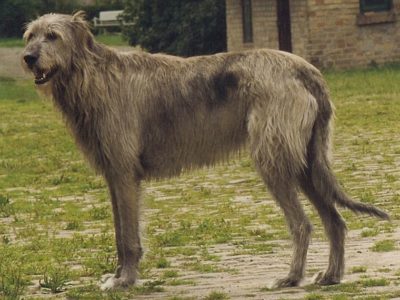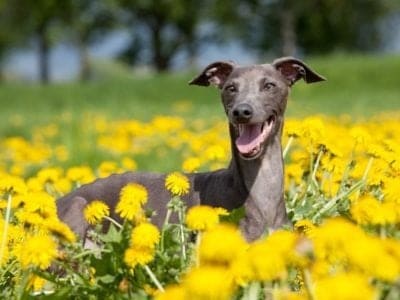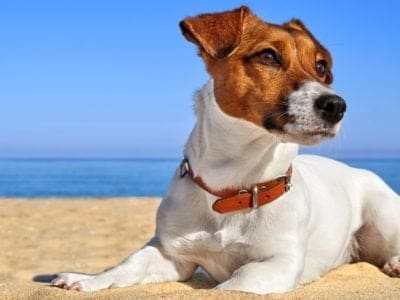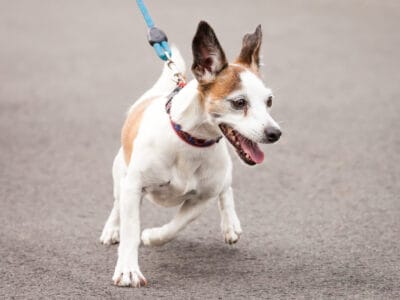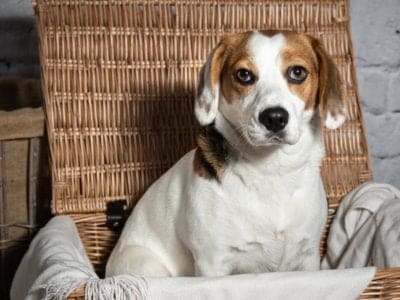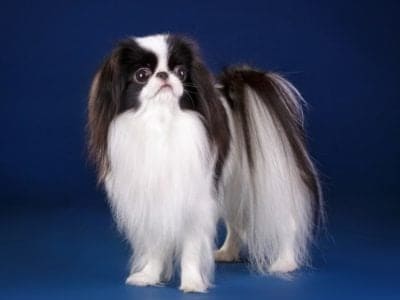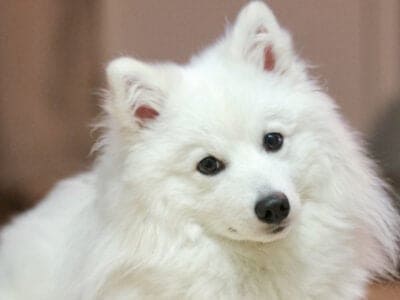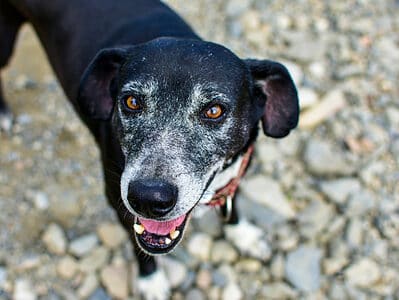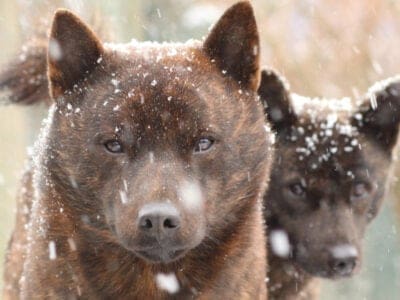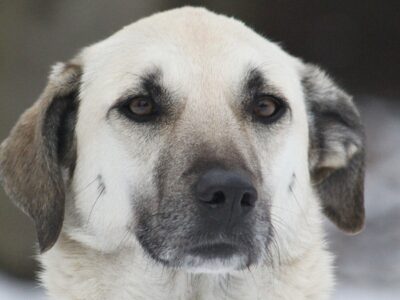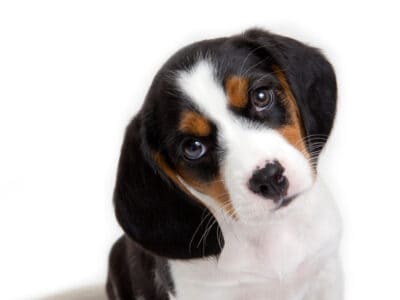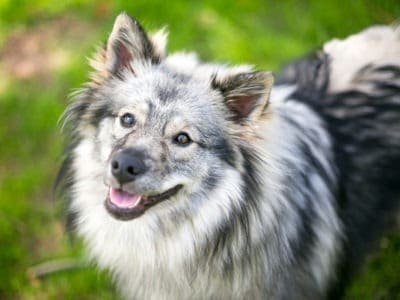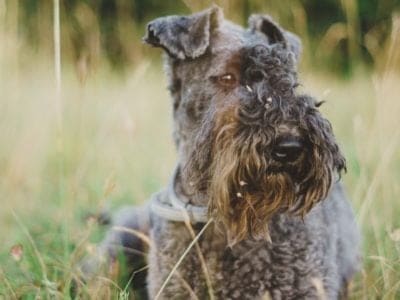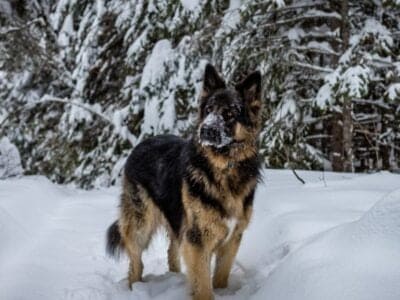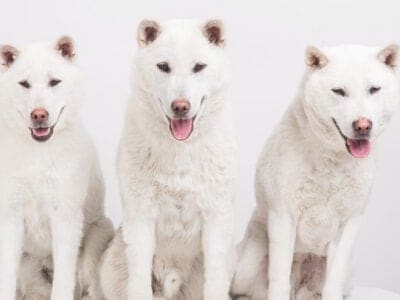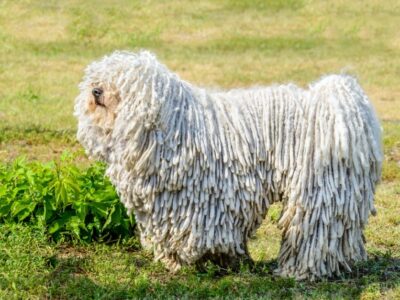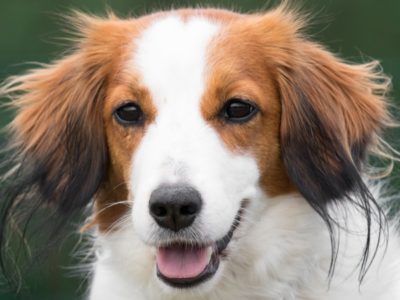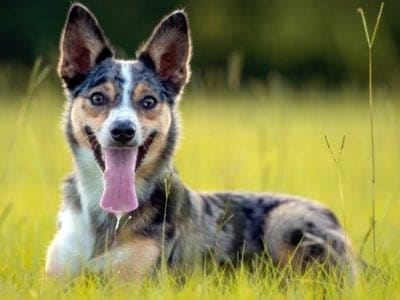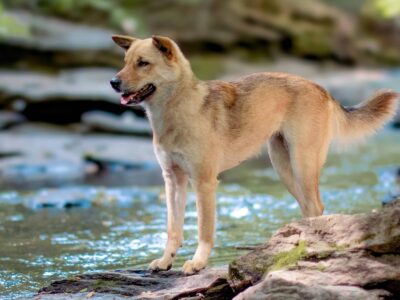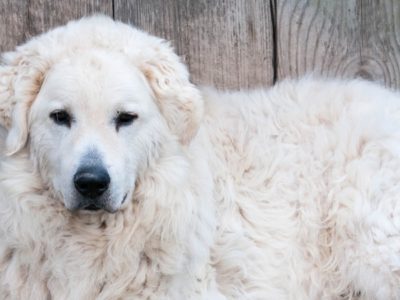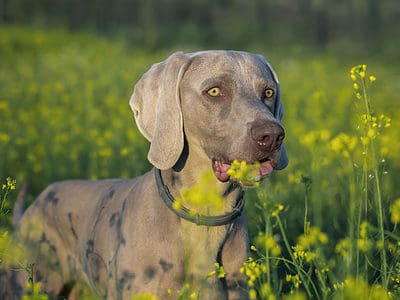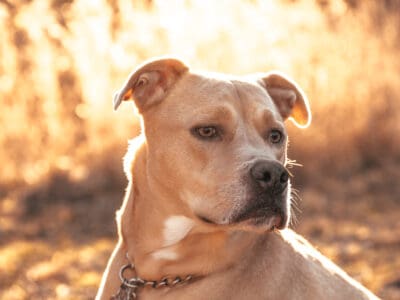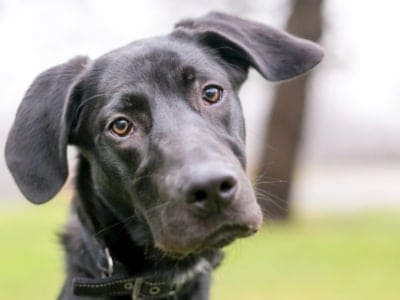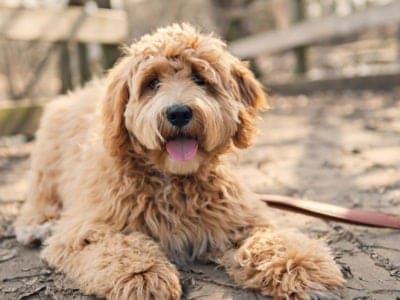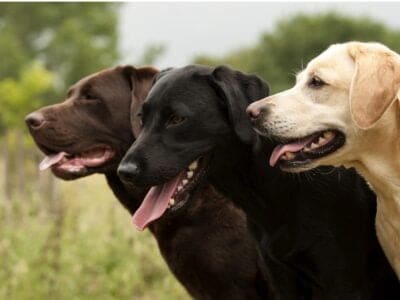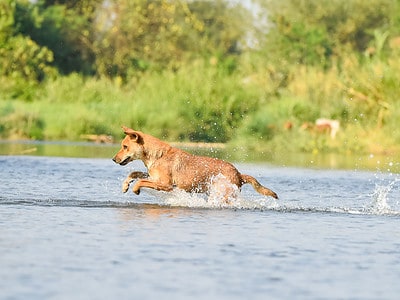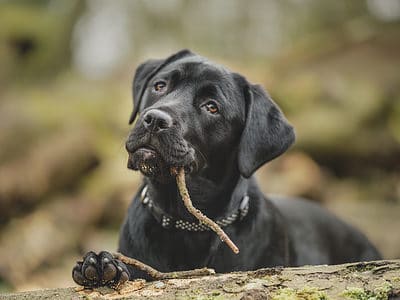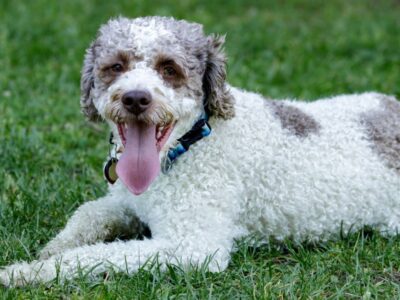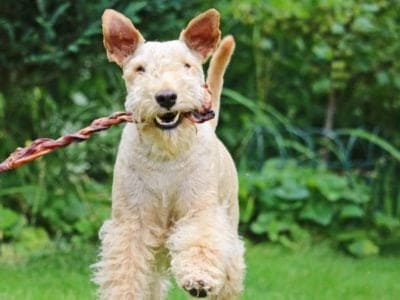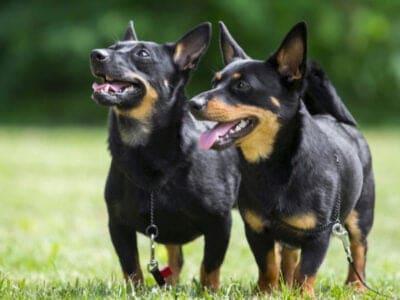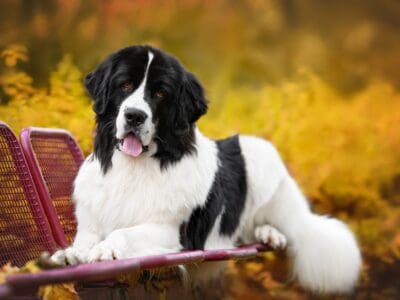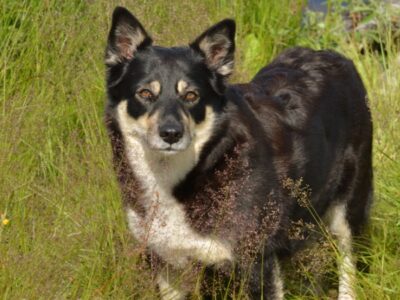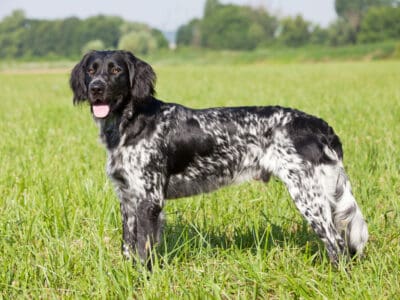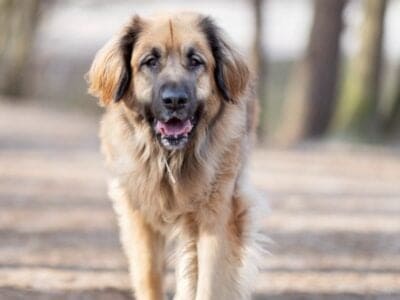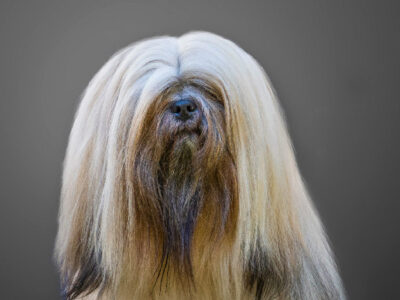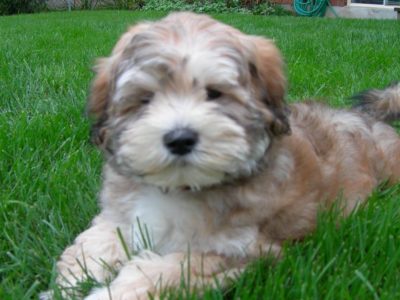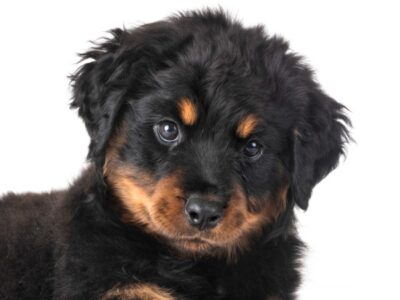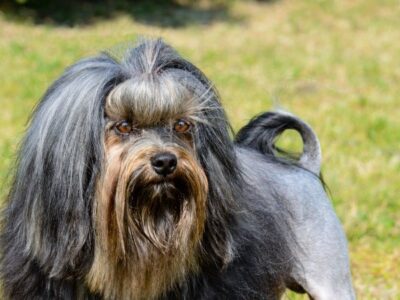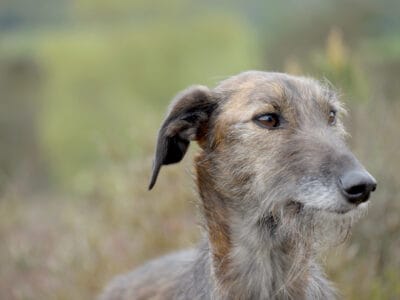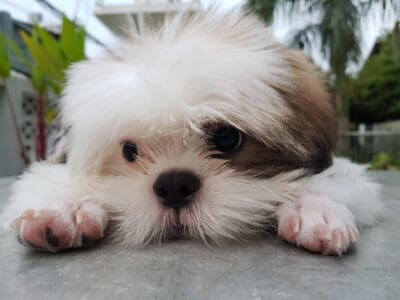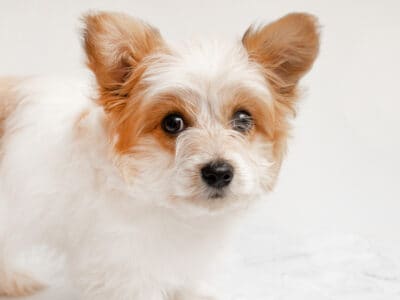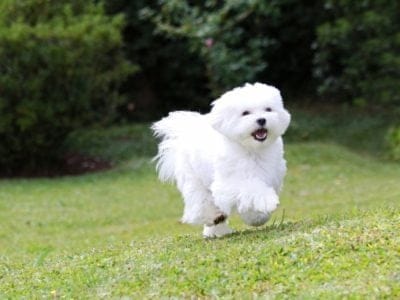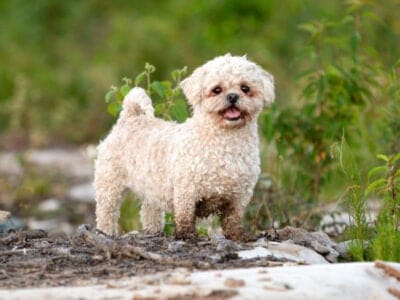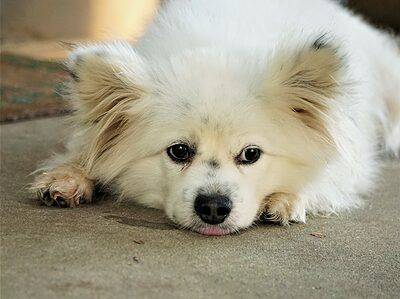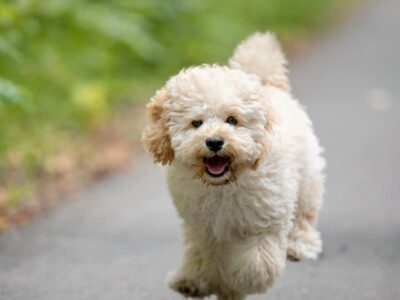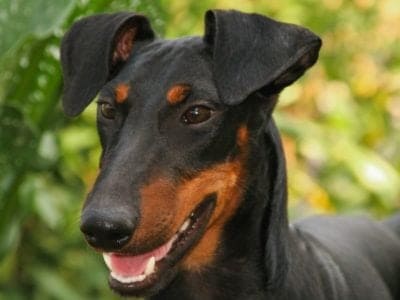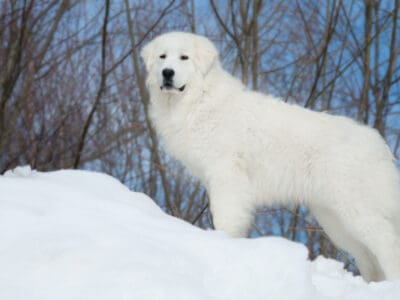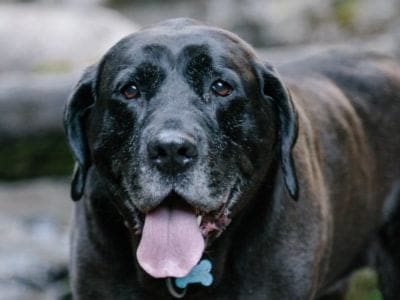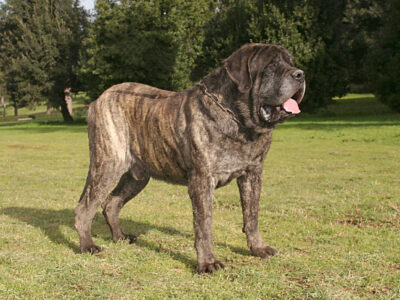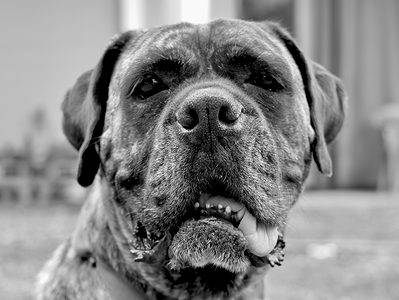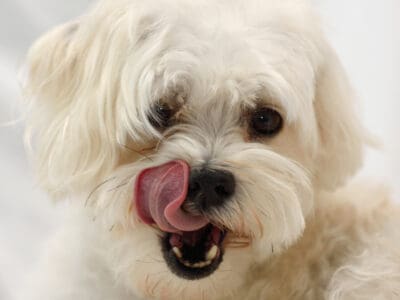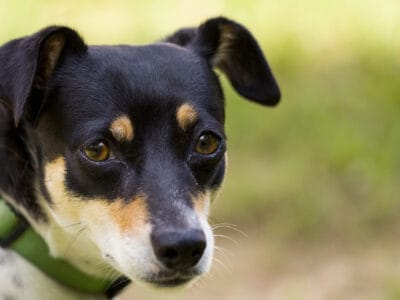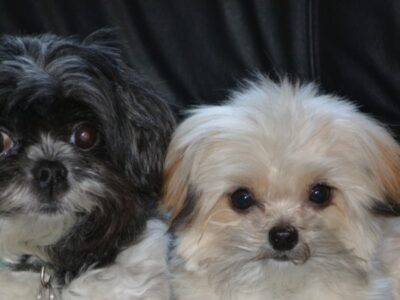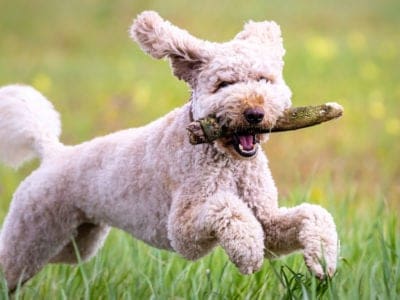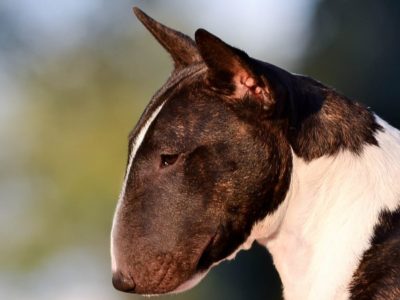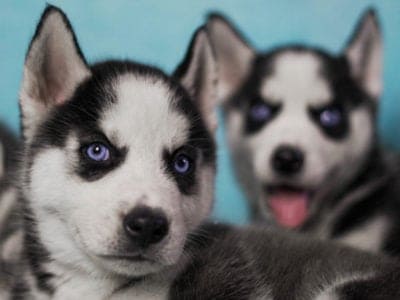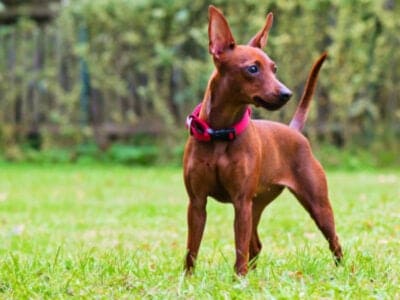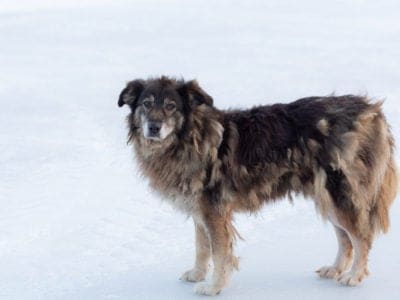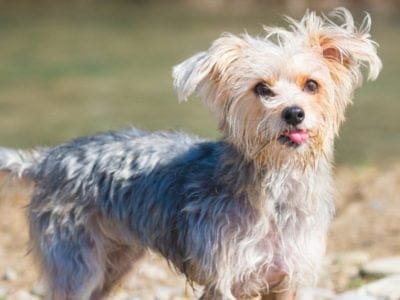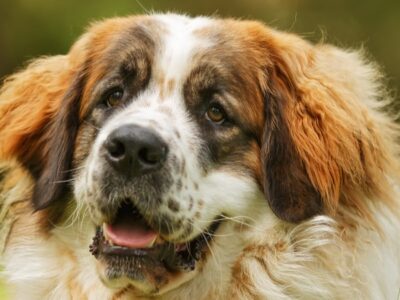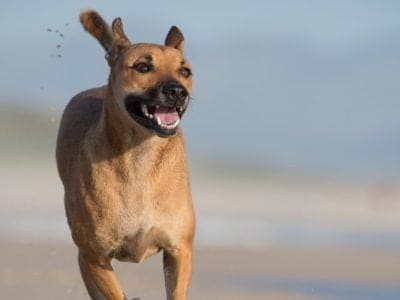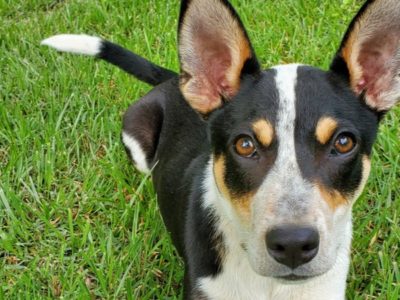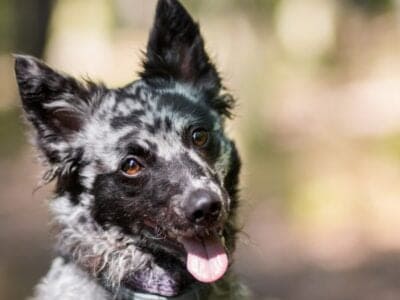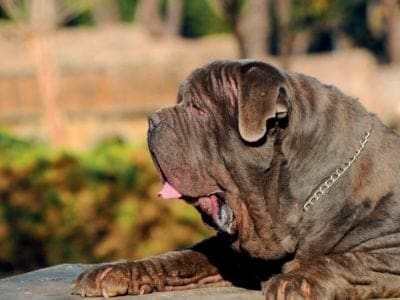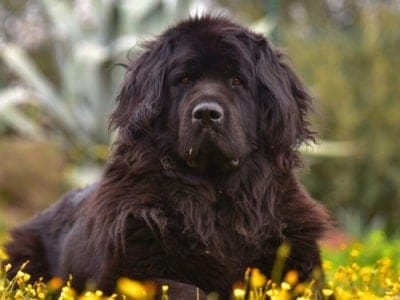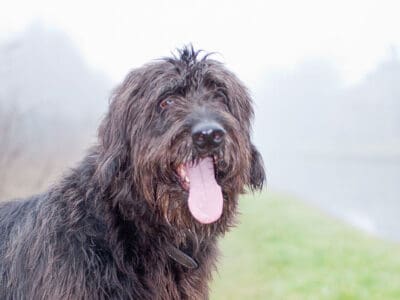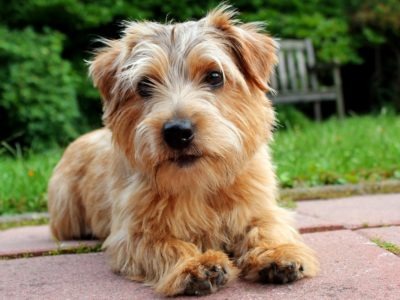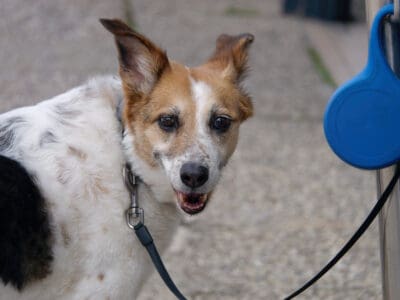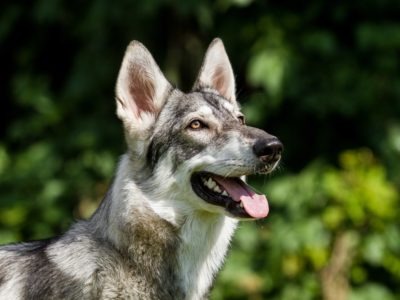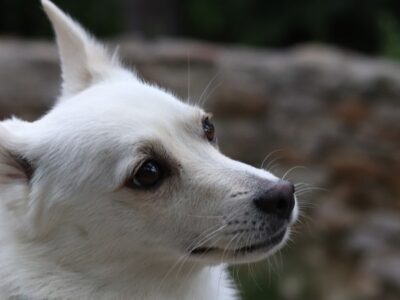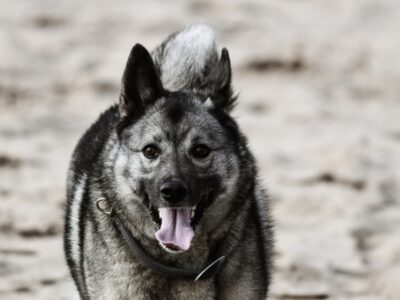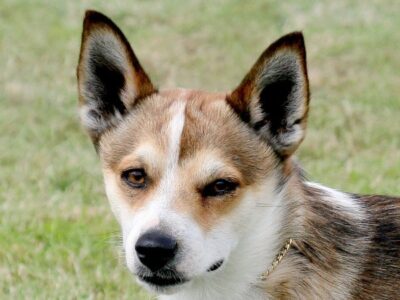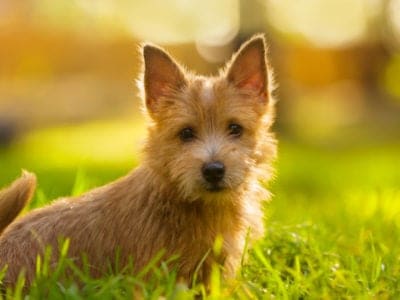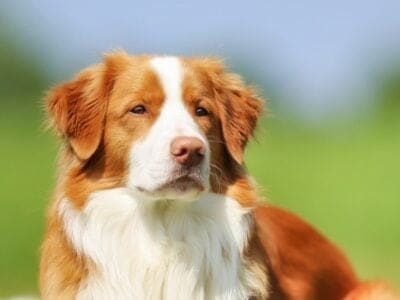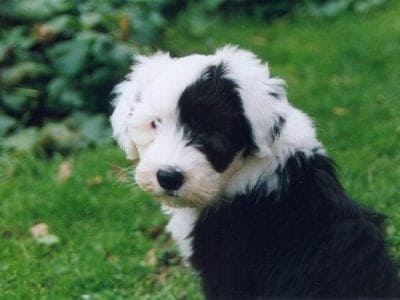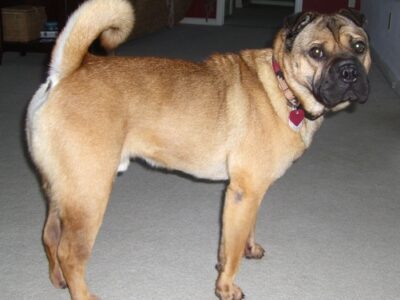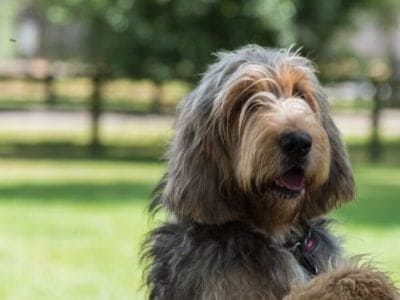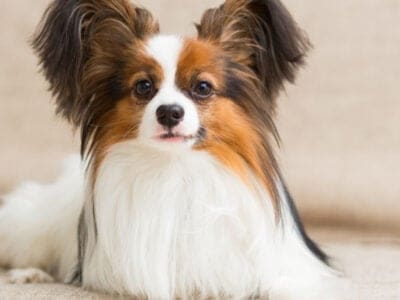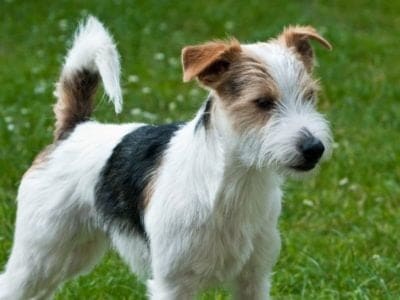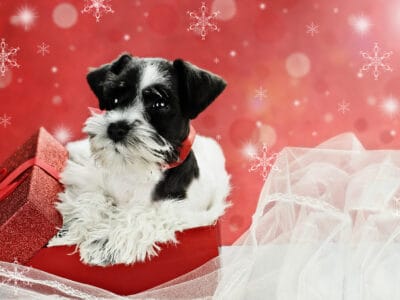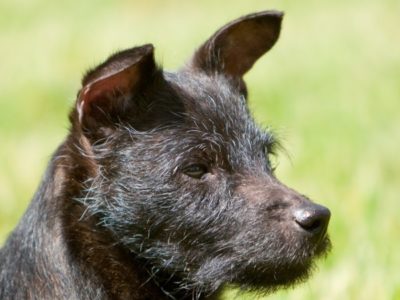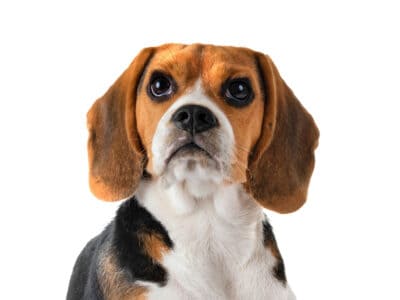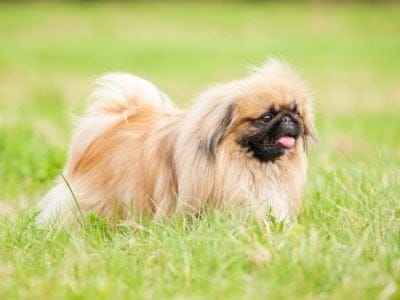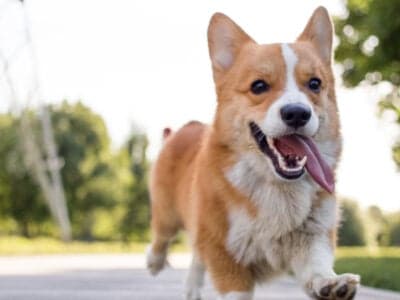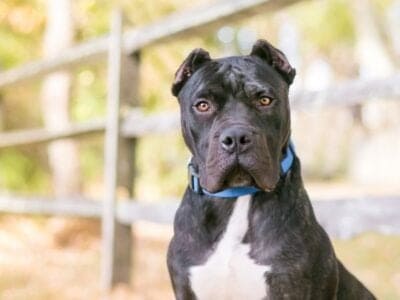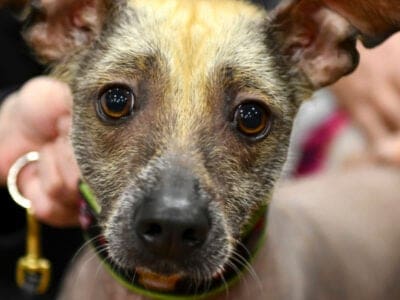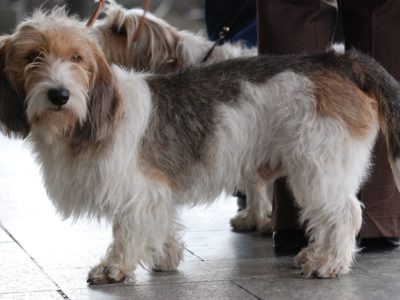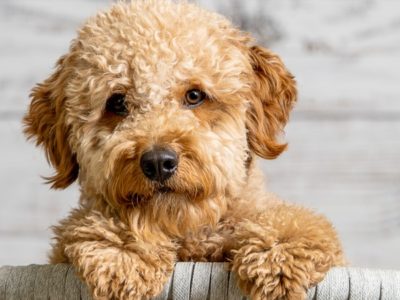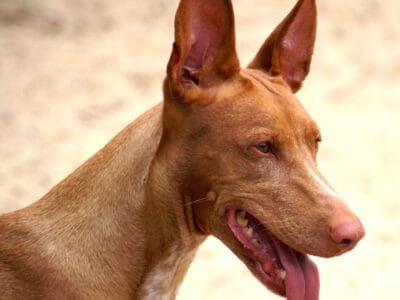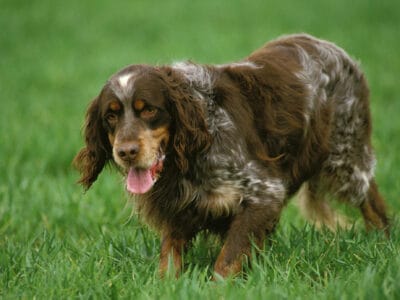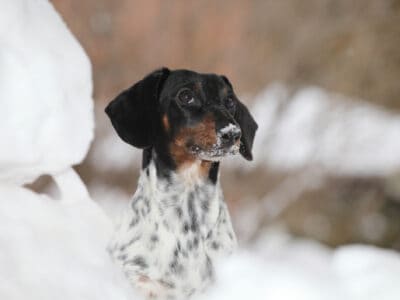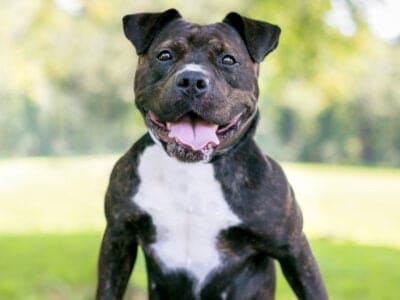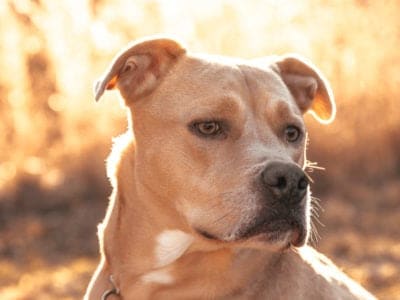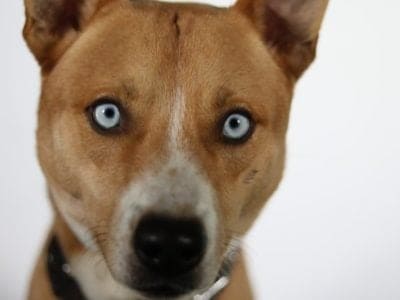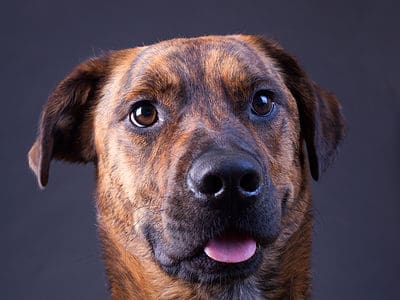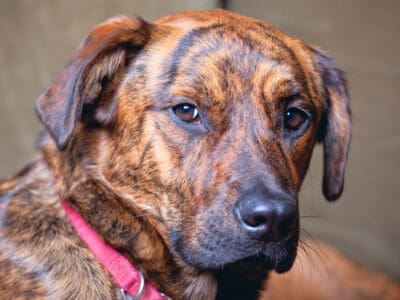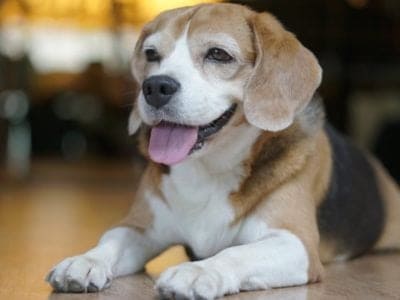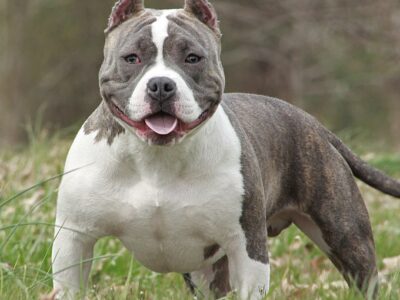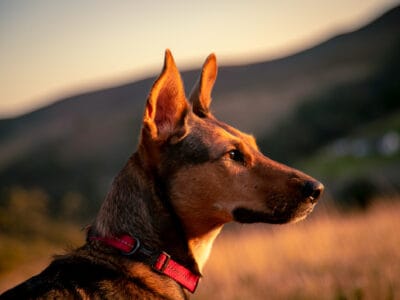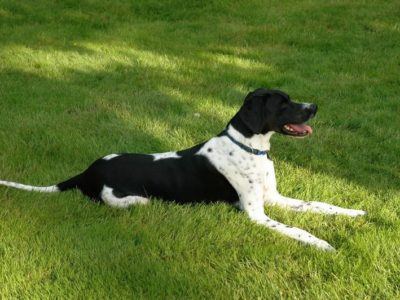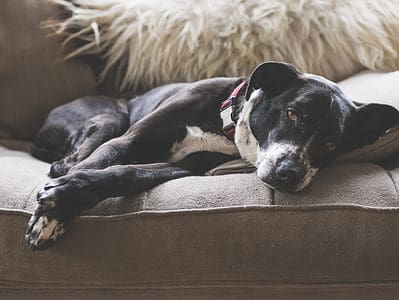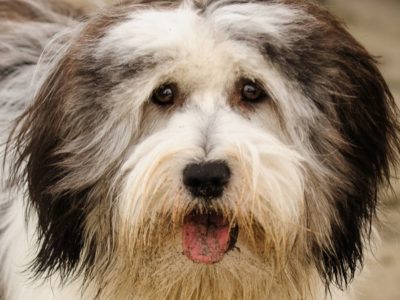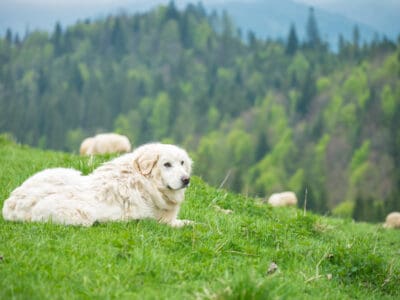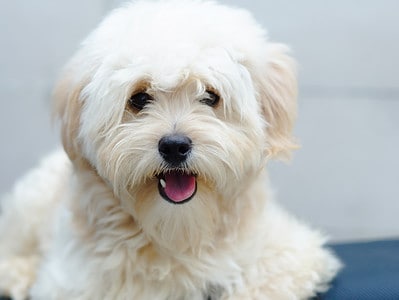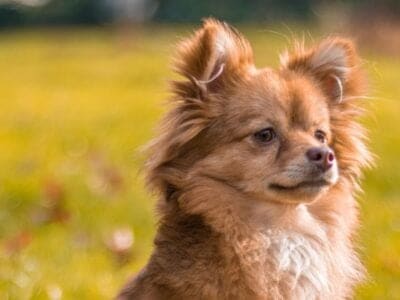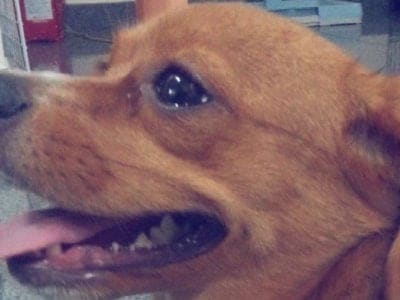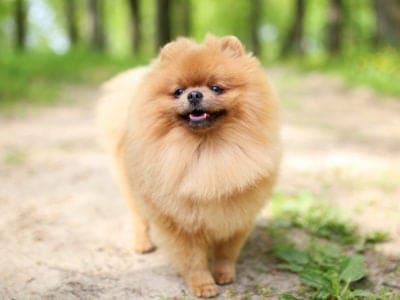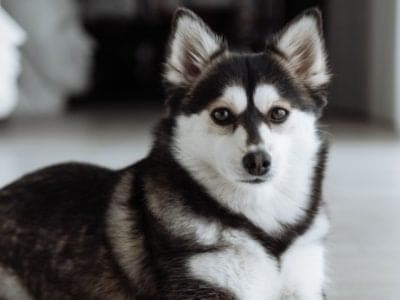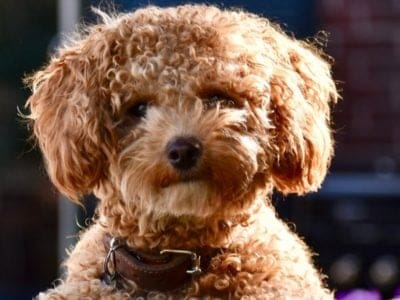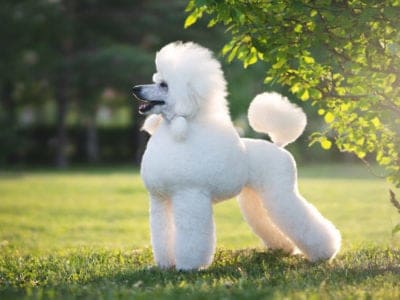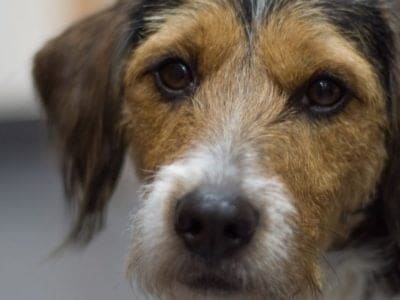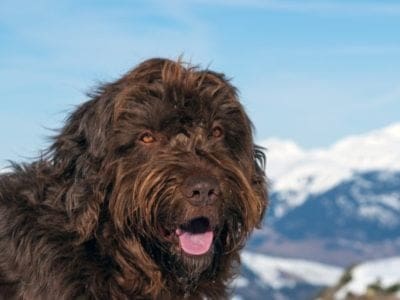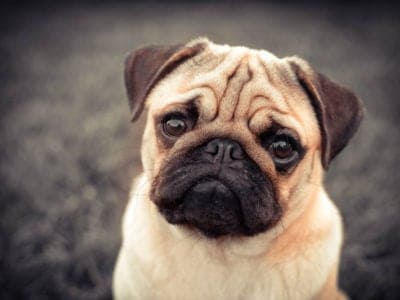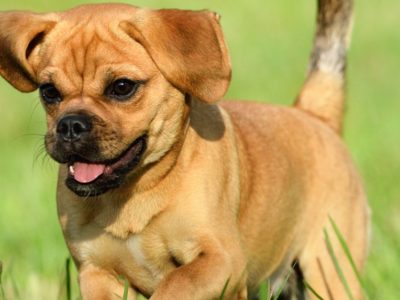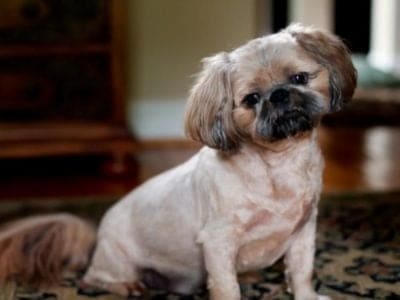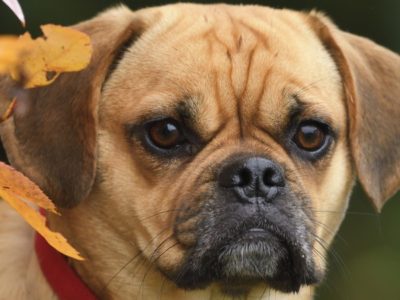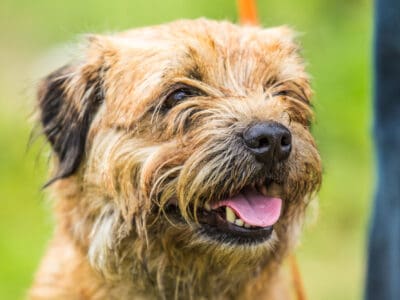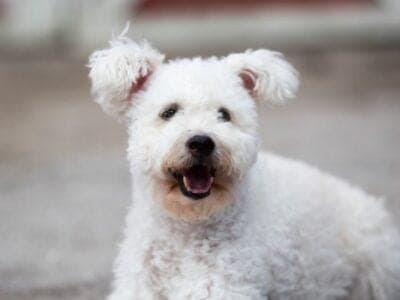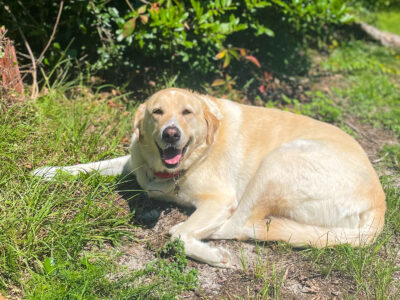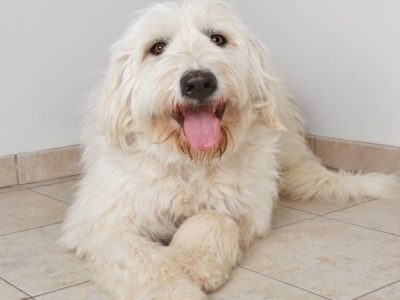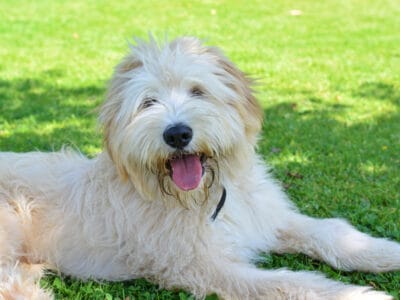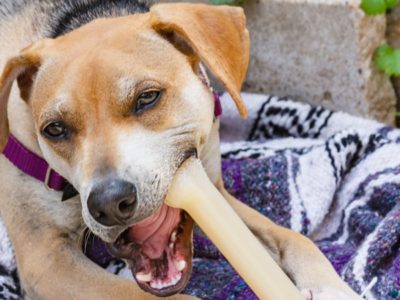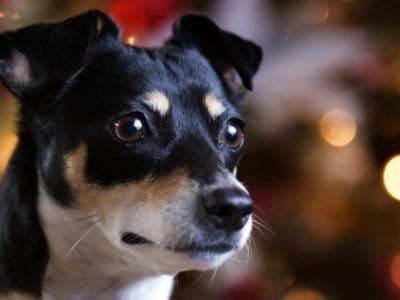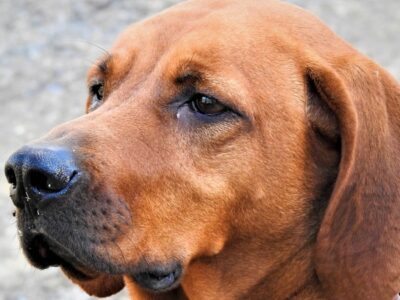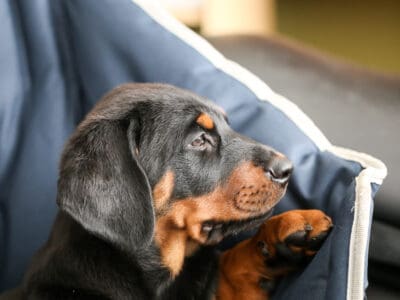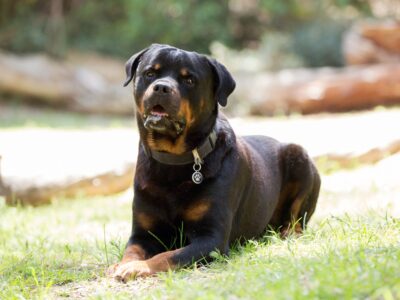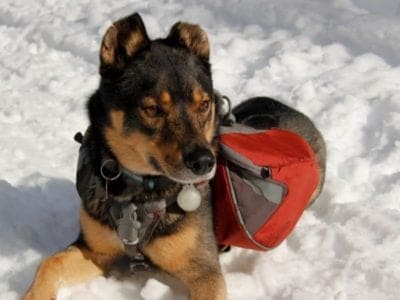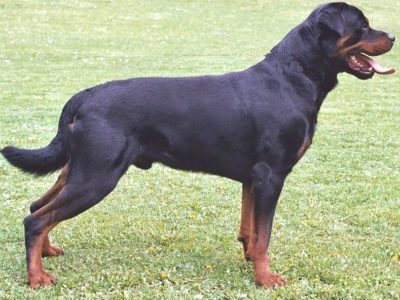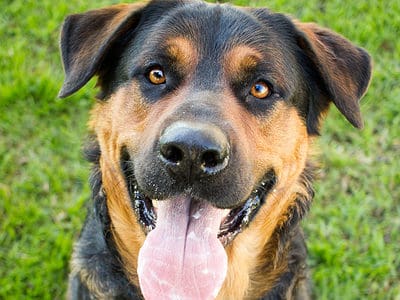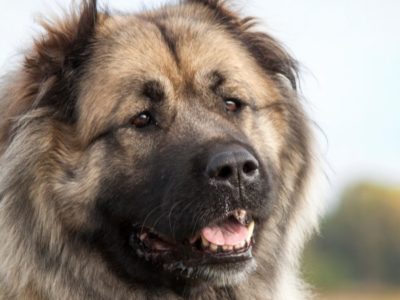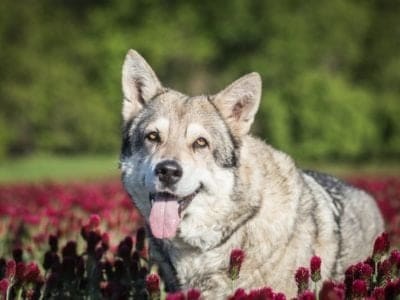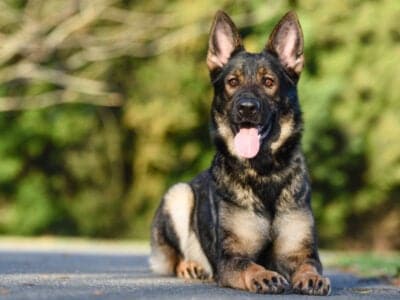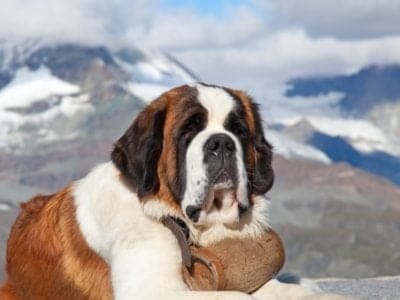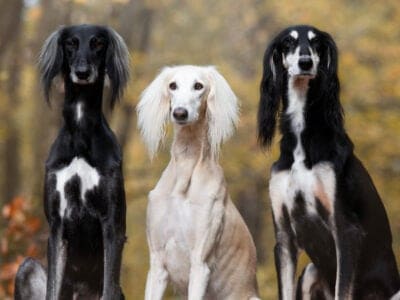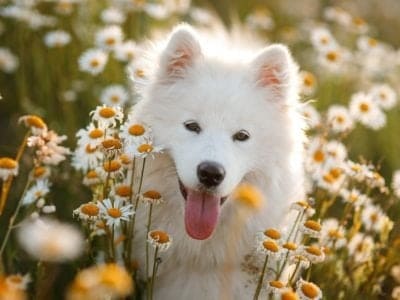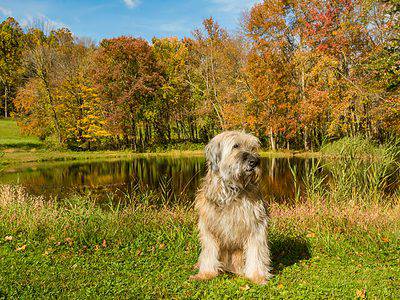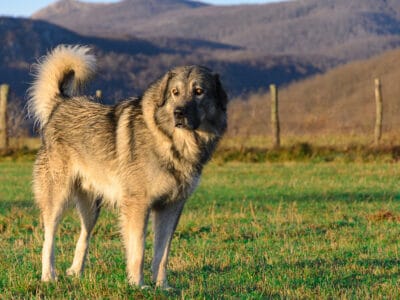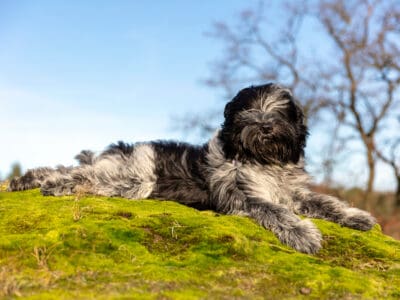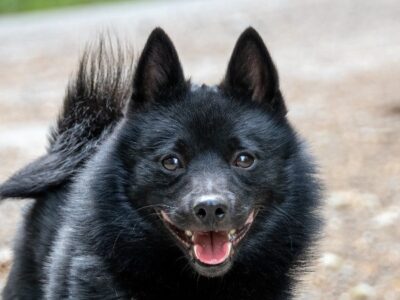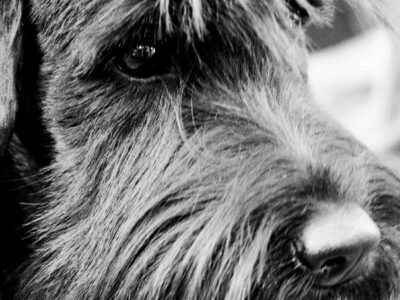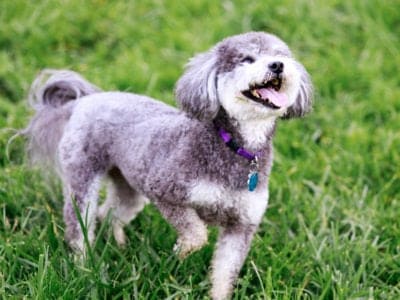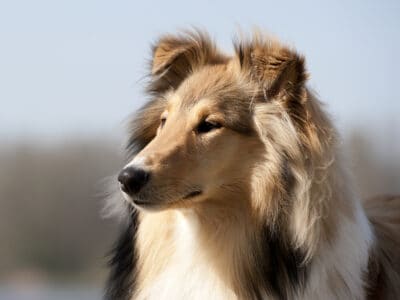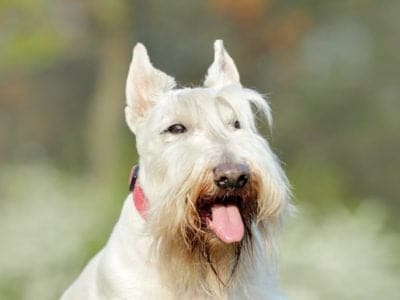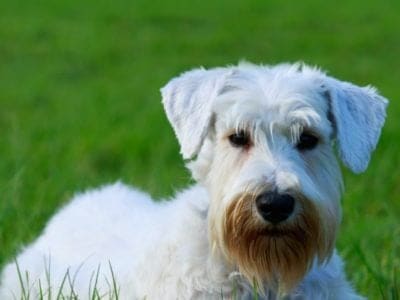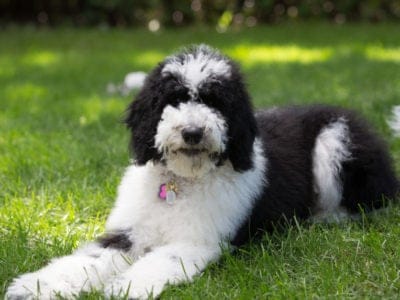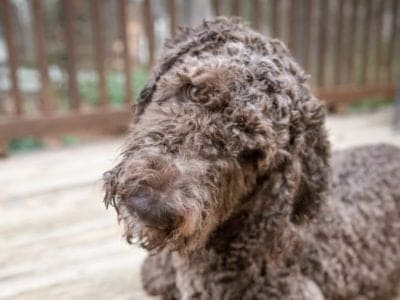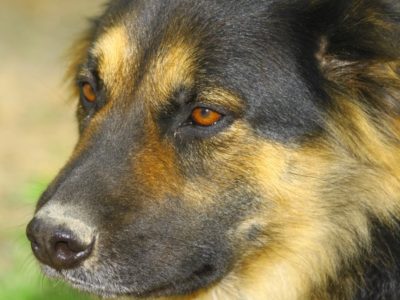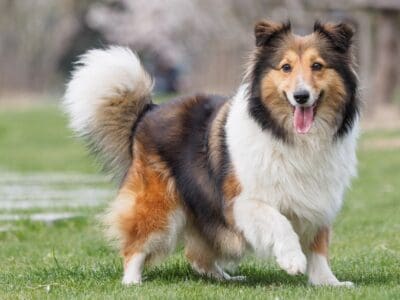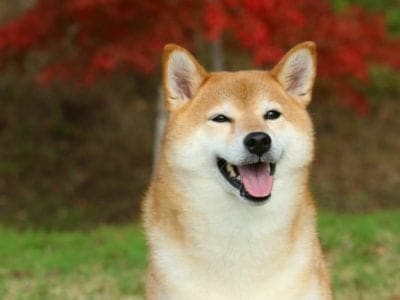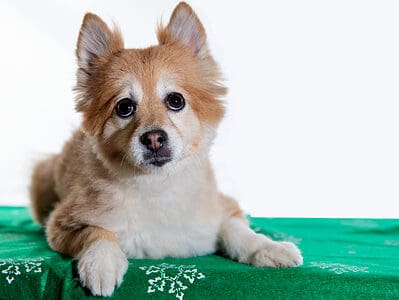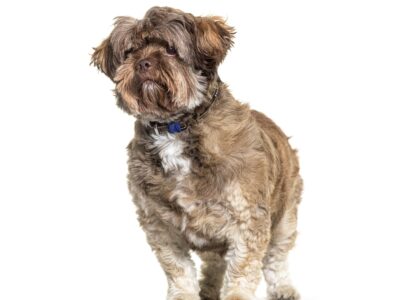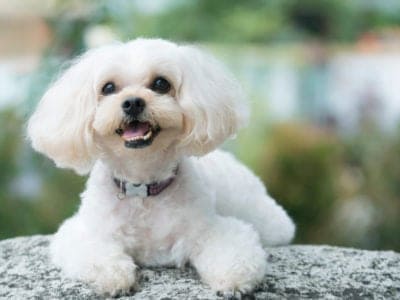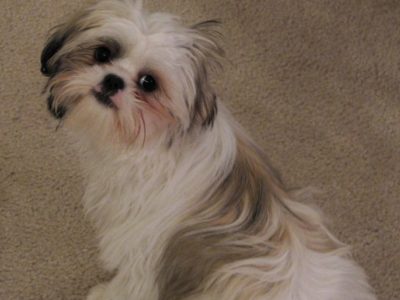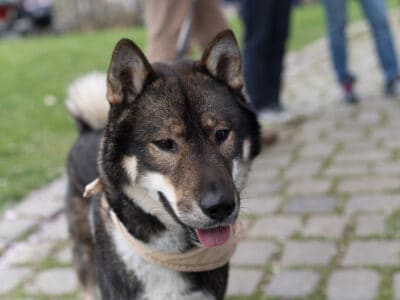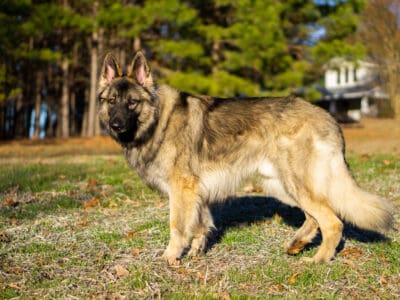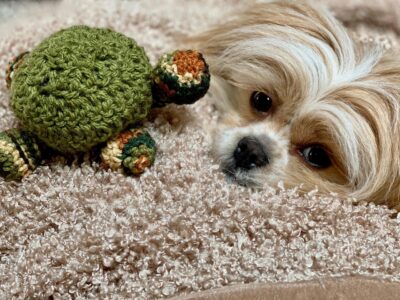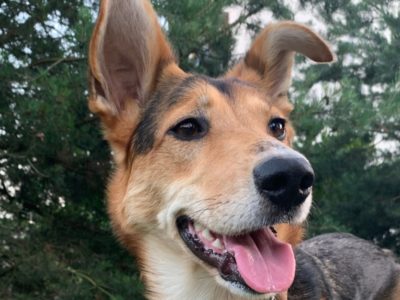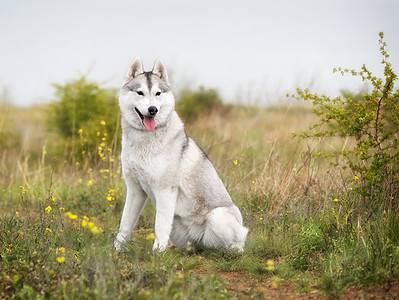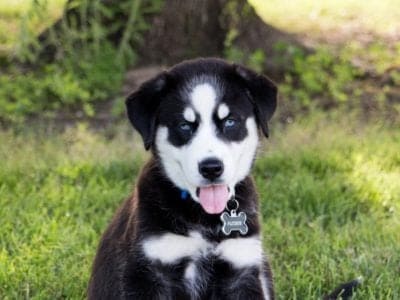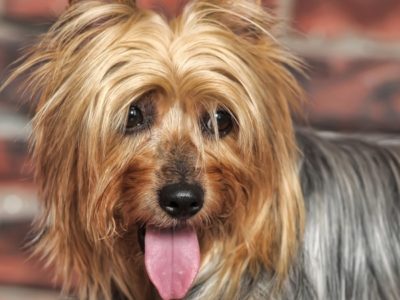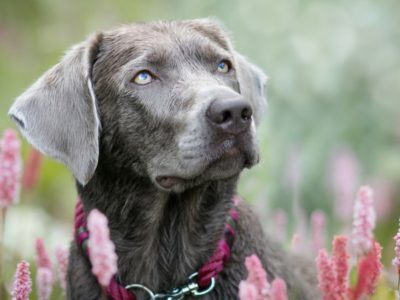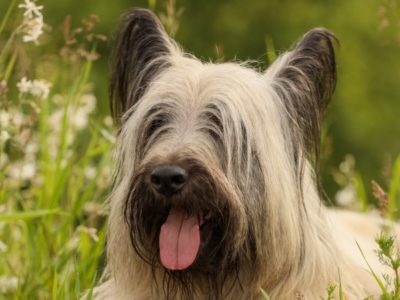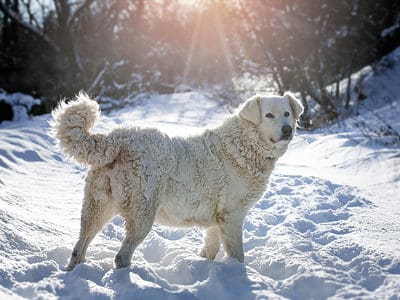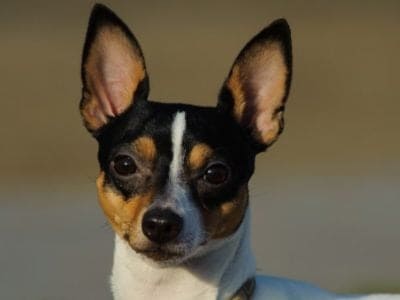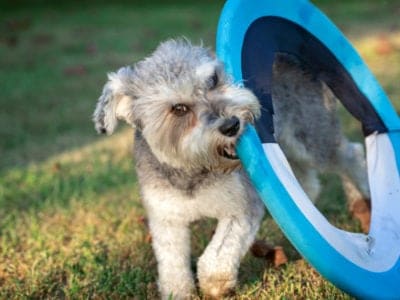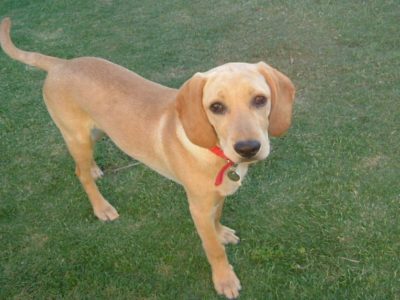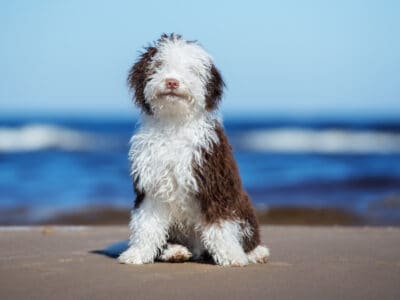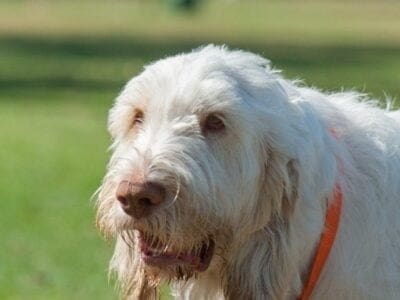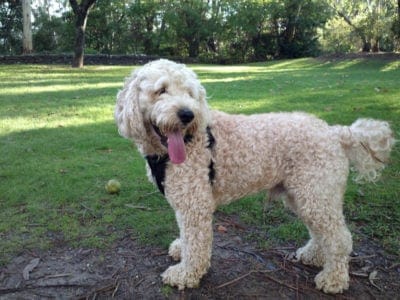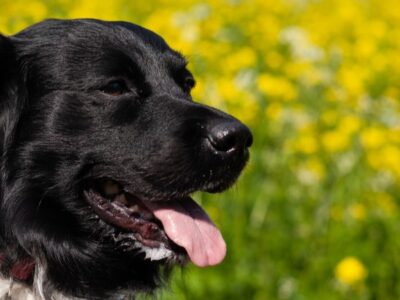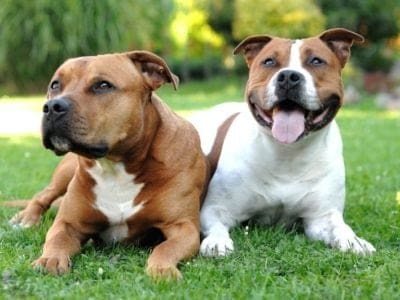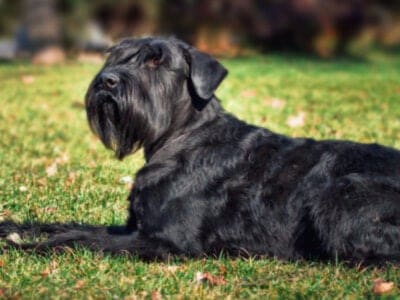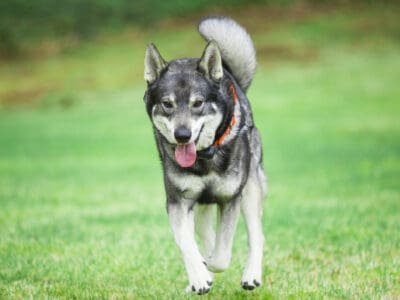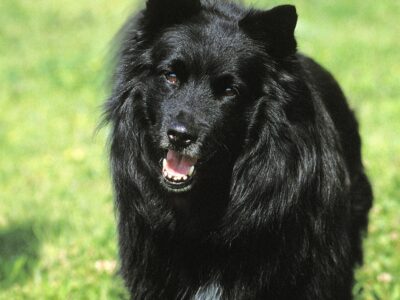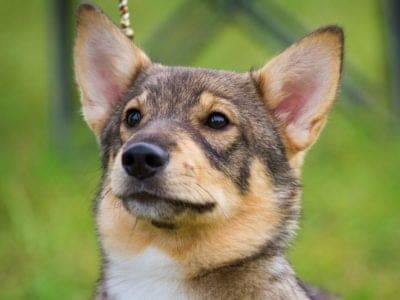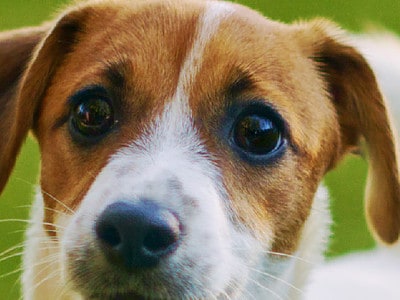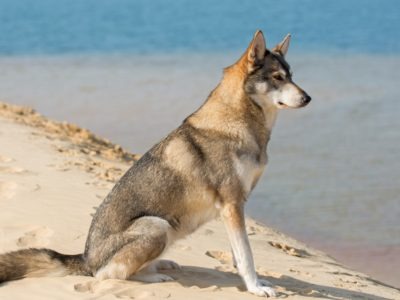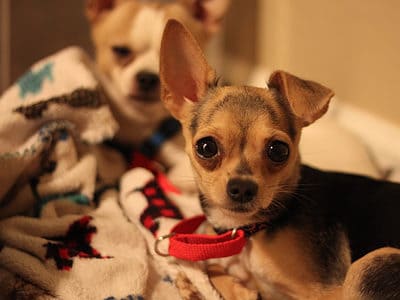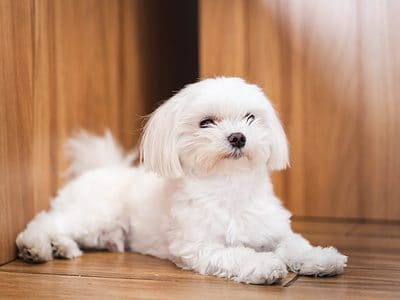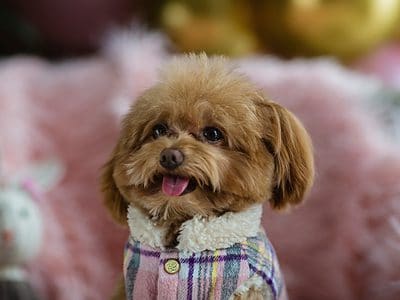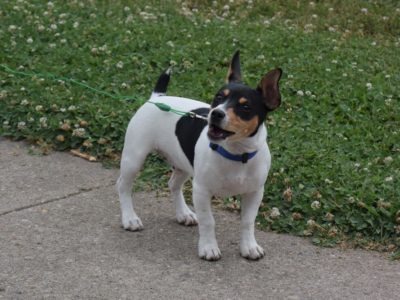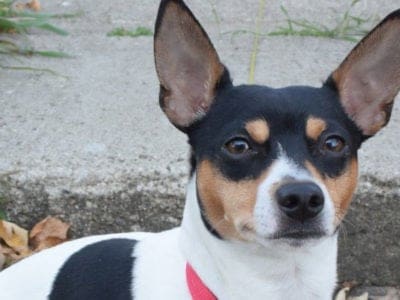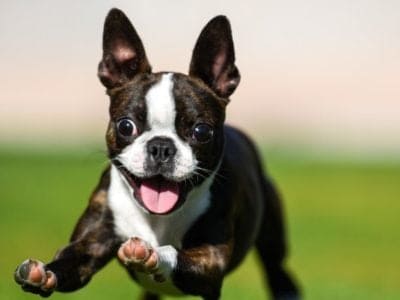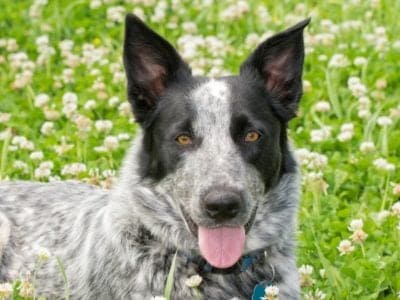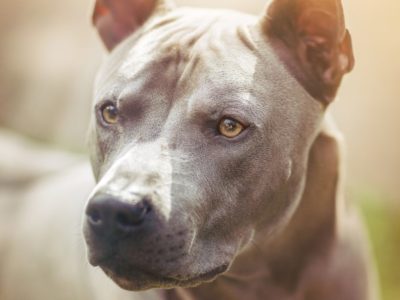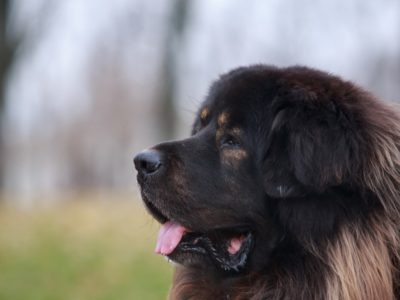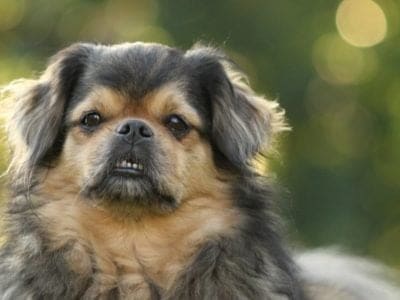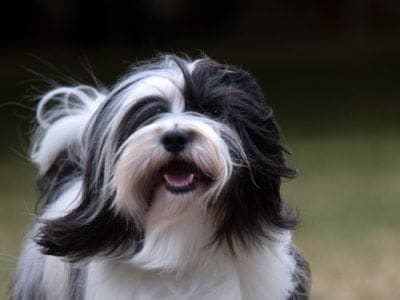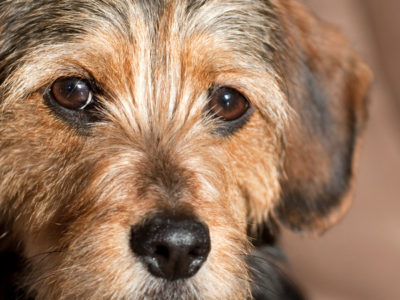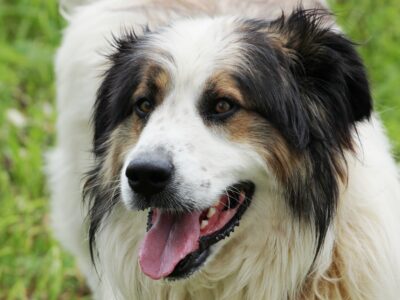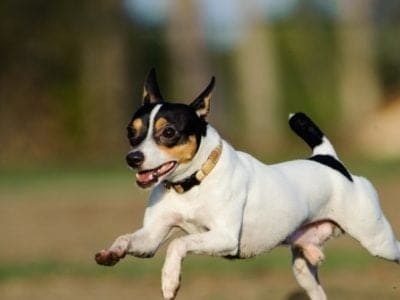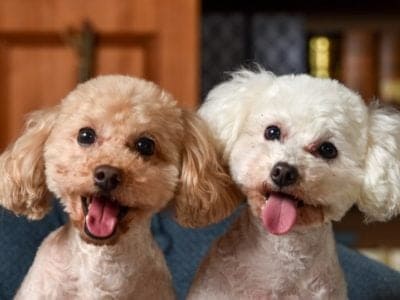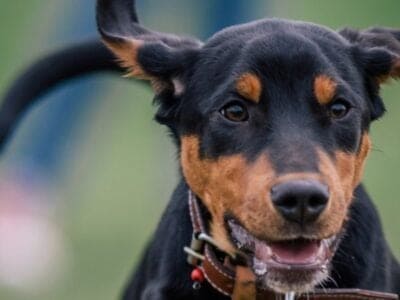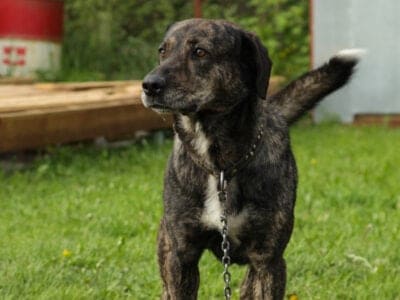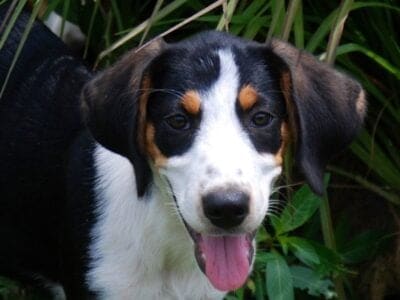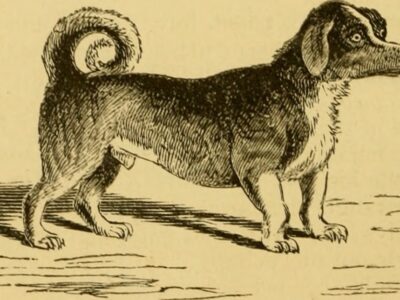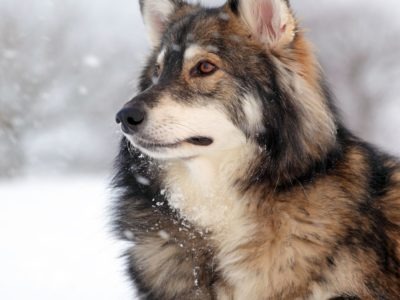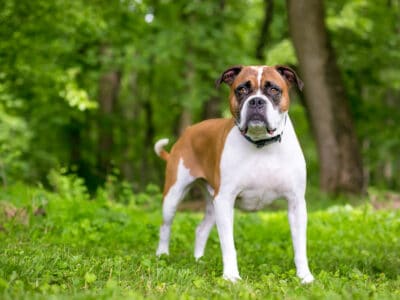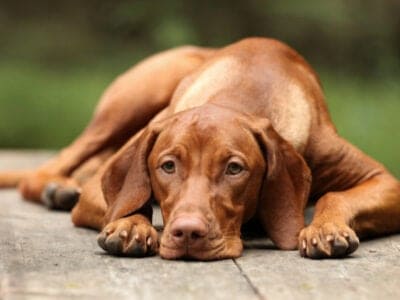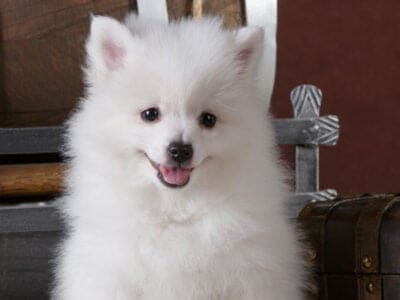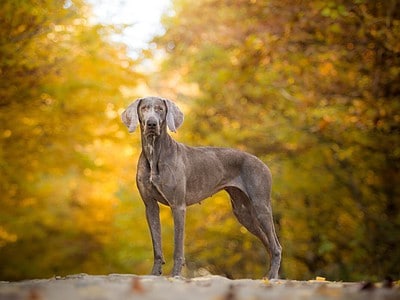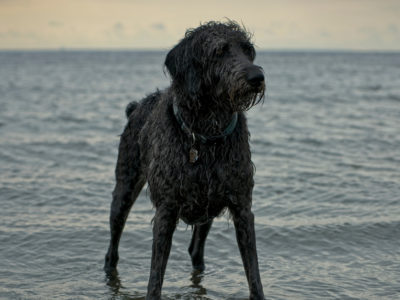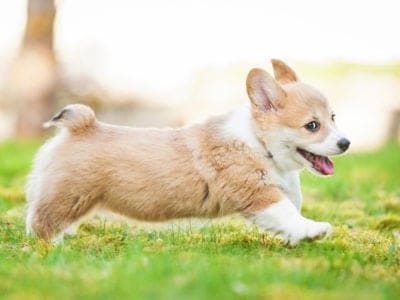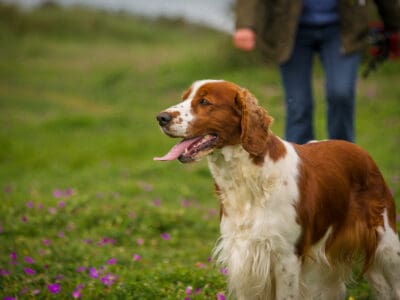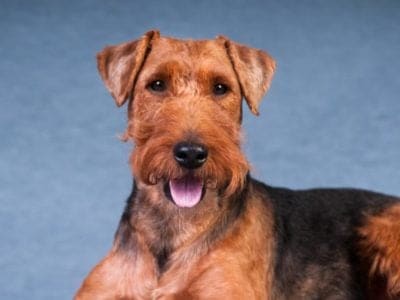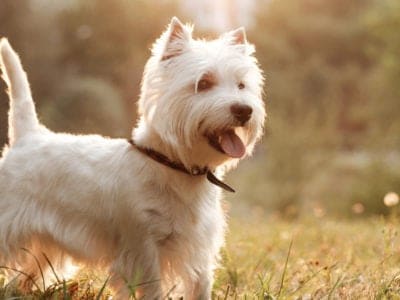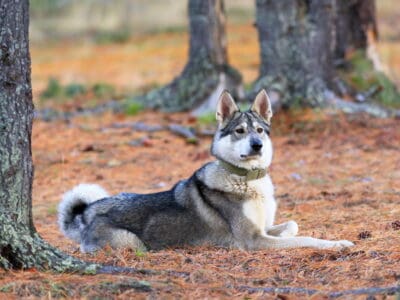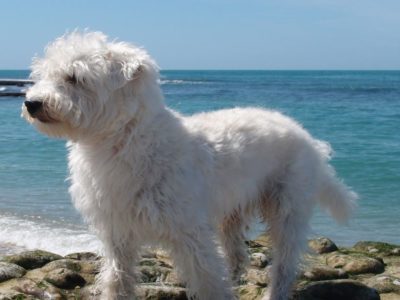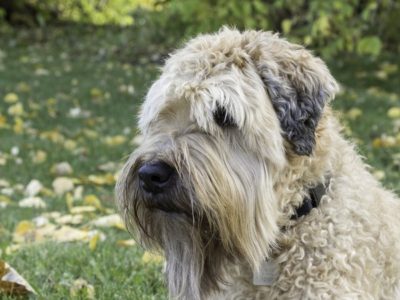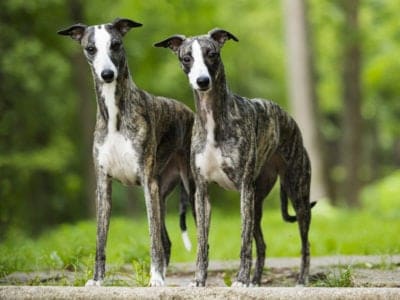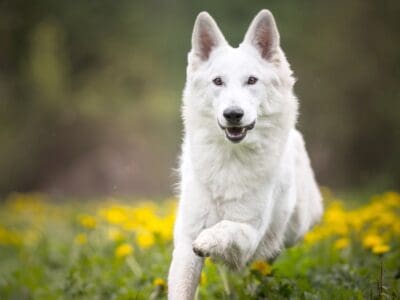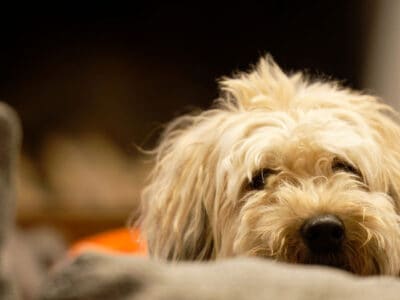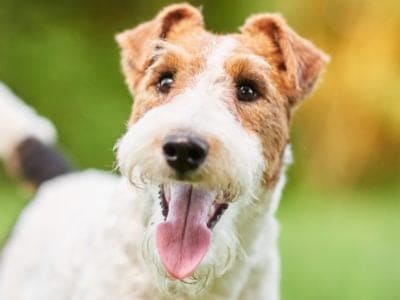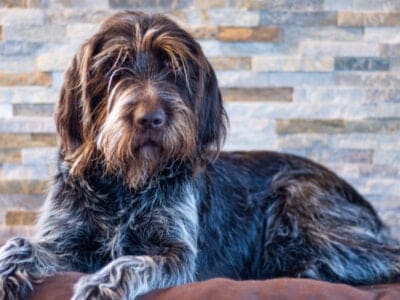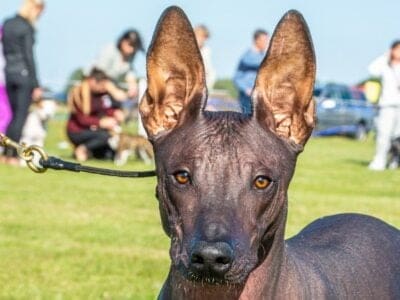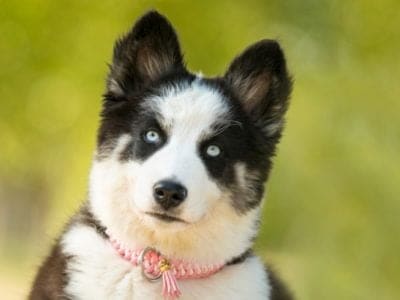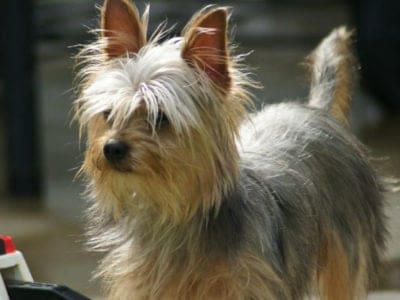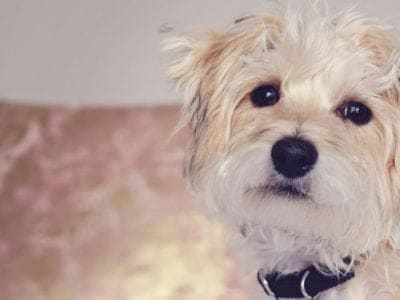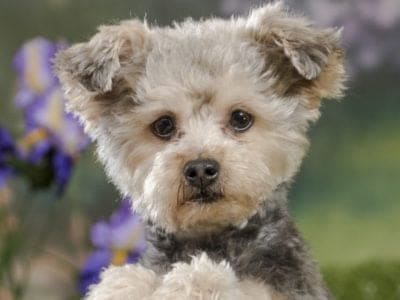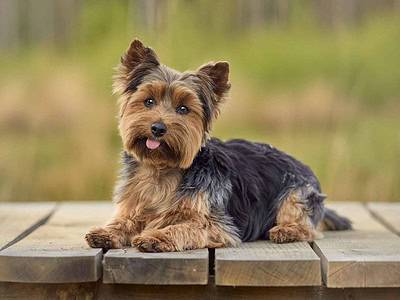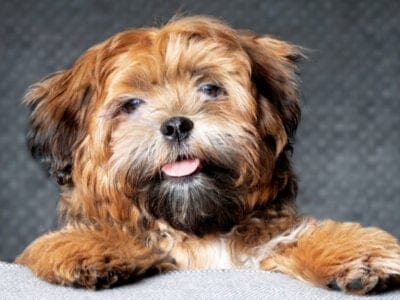Types of Dogs: All Breeds From A-Z (original) (raw)
Our Latest Facts About Dogs!
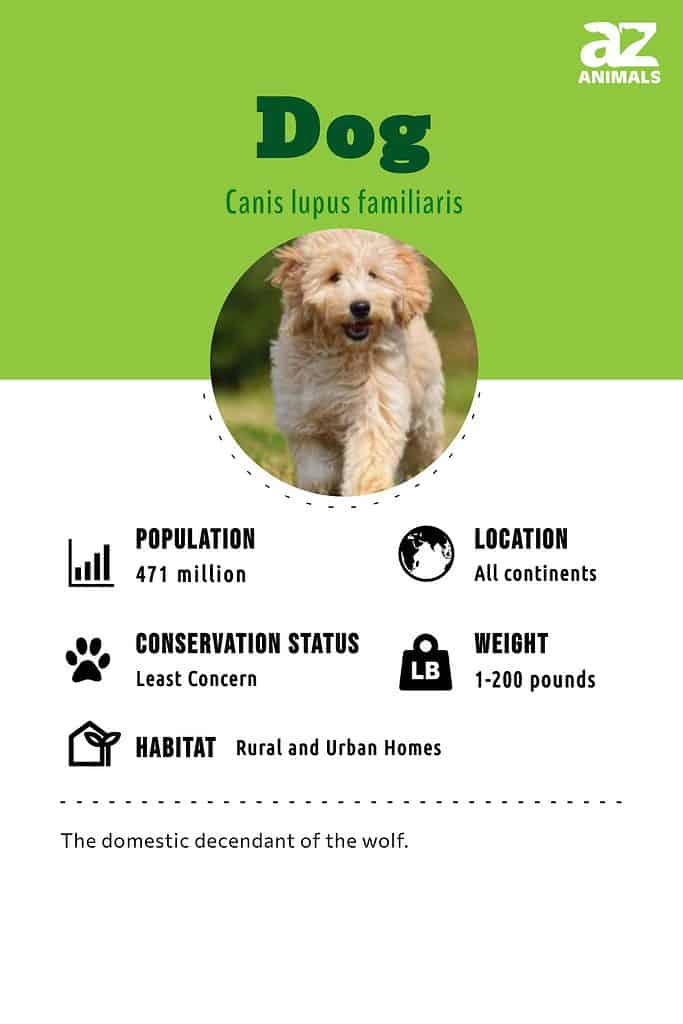
Scientific Name
Dogs are the domesticated descendants of the Wolf. There are many types of dogs, which we will list in detail below. Dogs have one of two scientific names depending on the species. The two scientific names for dogs are:
- Canis familiaris (domestic dog) — The most common and best fit for most types of pet dogs.
- Canis lupus familiaris (domestic wolf-dog) — A subspecies of the Wolf.
All types of dogs are in the family Canidae, the dog-like carnivorans or canids, while the genus Canis means “dog” and includes wolves, dogs, coyotes, and jackals. Their subfamily is Caninae, or canines, while their tribe is the dog-like or “true dog” tribe Canini and their sub-tribe is the wolf-like canids of Canina. Dogs are one of the first animals to be domesticated by prehistoric man.
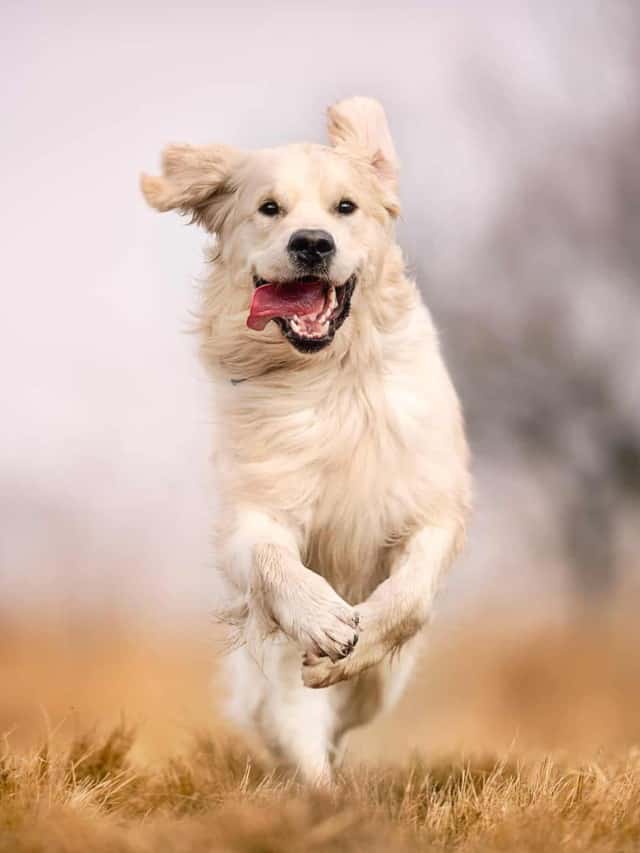
Human’s best friend is a domesticated descendant of the wolf.
History of Domestication
Humans and dogs have been in a long-standing partnership since ancient times. This partnership was likely formed out of the human need for help with herding, hunting, and alarm systems, as well as a source of food. In return, dogs were provided with protection, shelter, and companionship. The exact time that this relationship was forged is still being discussed.
Research conducted using mitochondrial DNA has revealed that wolves and dogs diverged into separate species about 100,000 years ago. While mtDNA research has provided some insight into the period of domestication that may have occurred between 40,000 and 20,000 years ago, scientists have not reached an accord on the exact findings. Some theories state that the animals were first domesticated in East Asia. Others suggest it was in the Middle East, while others propose that domestication took place in Europe at a later stage.
Experts now acknowledge that the range of different dog breeds we see today has only recently come about. Nevertheless, the remarkable variety of dogs is a reminder of their traditional and diverse domestication processes. Dog sizes range from tiny teacup poodles, which weigh as little as one pound, to enormous mastiffs tipping the scales at over 200 lbs. Furthermore, there are differences in the skull, body, and limb shapes of breeds, and they also have varying abilities, such as searching, retrieving, guiding, and herding.
Humans were originally hunter-gatherers, and as they moved around, so did their dogs. This meant that the two populations were geographically isolated for a while. As the human population increased and trade networks developed, people reconnected, and the dog population was genetically mixed. About 500 years ago, breeders created different types of dogs from a fairly homogenous gene pool of dogs with mixed genetic heritages that had originated from various places.
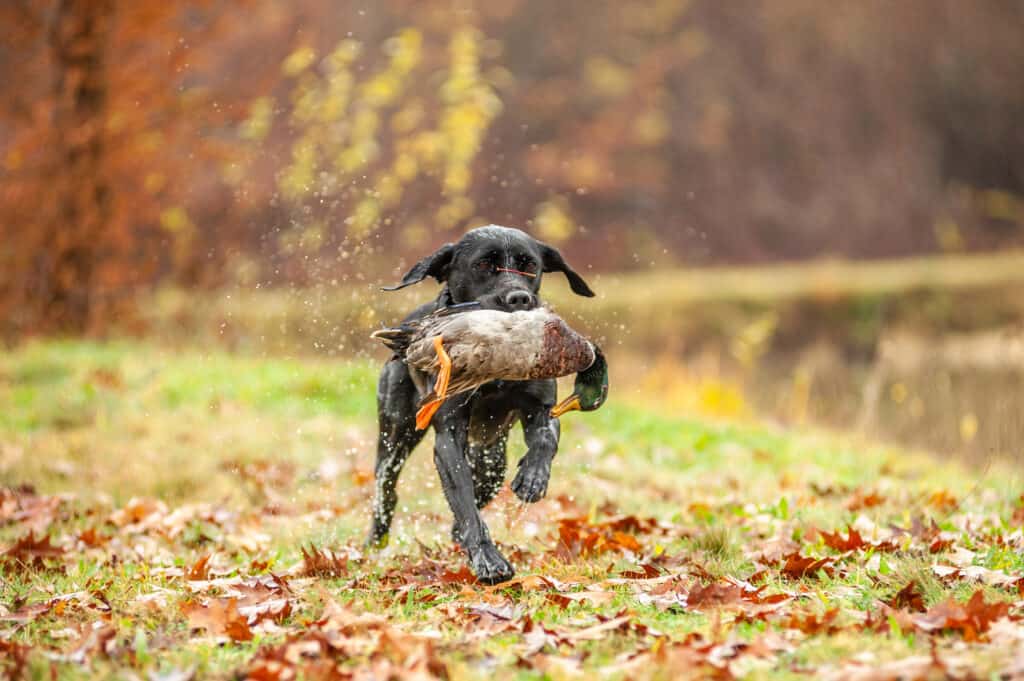
Humans and dogs have been in a long-standing partnership since ancient times, formed out of the human need for help with herding, hunting, and protection.
©Anna Pozzi – Zoophotos/Shutterstock.com
Characteristics
There are many types of dogs, but all members of the genus Canis have common physical characteristics. Bone structure, behavior, and reproduction are just a few markers that are unique to canids. Many types of dogs have unique characteristics that distinguish them from wolves. You can use some of these markers to determine whether a canid is a wolf or a dog.
Canine teeth
Dogs are decedents of wolves and have a dental pattern that reflects their carnivorous diet. Their teeth are sharp and designed to rip apart and chew meat. The four sharp, pointed teeth many humans have are called ‘canines’ for their resemblance. Teeth are one of the easiest ways to identify a canine. Most canids (of the family Canidae) have 42 teeth, with a dental formula of:
- 3.1.4.2
- 3.1.4.3.
Types of Dog Teeth And Their Function
| Tooth Type | Lower Teeth Count | Upper Teeth Count | Function |
|---|---|---|---|
| Molars | 6 | 4 | Shearing |
| Premolars | 8 | 8 | Shearing |
| Canines | 2 | 2 | Ripping |
| Incisors | 6 | 6 | Biting |
Learn everything you need to know about dog teeth here.
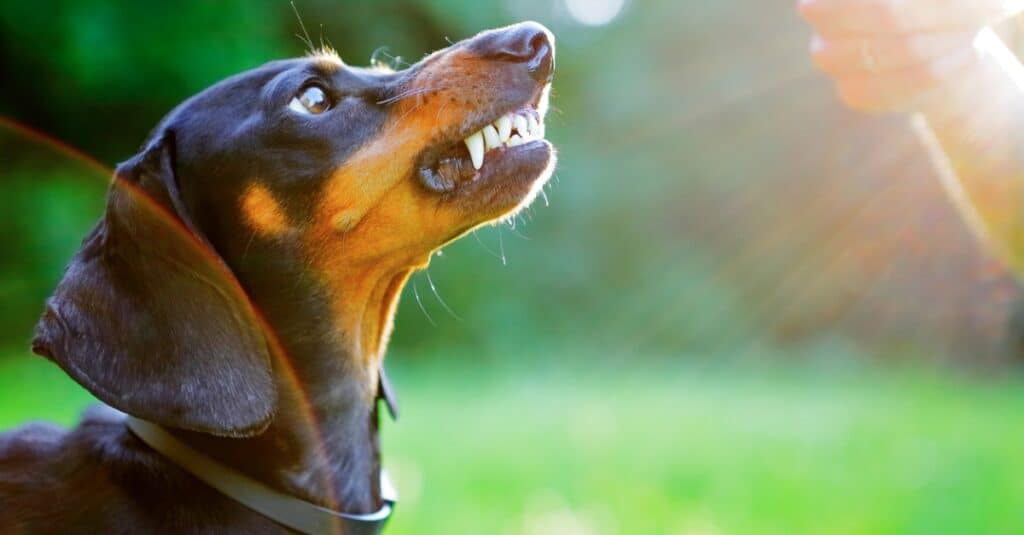
Modern dogs have a dental pattern that is the same as a wild wolf.
©iStock.com/alexandrshevchenko
Other canid features
Canids generally share similar skull features, basic body shape, monogamous and pack behavior, and retention of adult offspring.
Diet
Because dogs descended from wolves, they are carnivores with biology designed for a meat-based diet. However, very few pet dogs today eat strictly meat. Modern dog food is much more affordable than a pure meat diet and offers a wider range of nutrients.
Today dog food is often made by blending meat with grains and vegetables. Different meats like salmon, chicken, venison, beef, and pork are often used in dog food. These meats are commonly combined with potatoes, peas, carrots, and other vegetables.
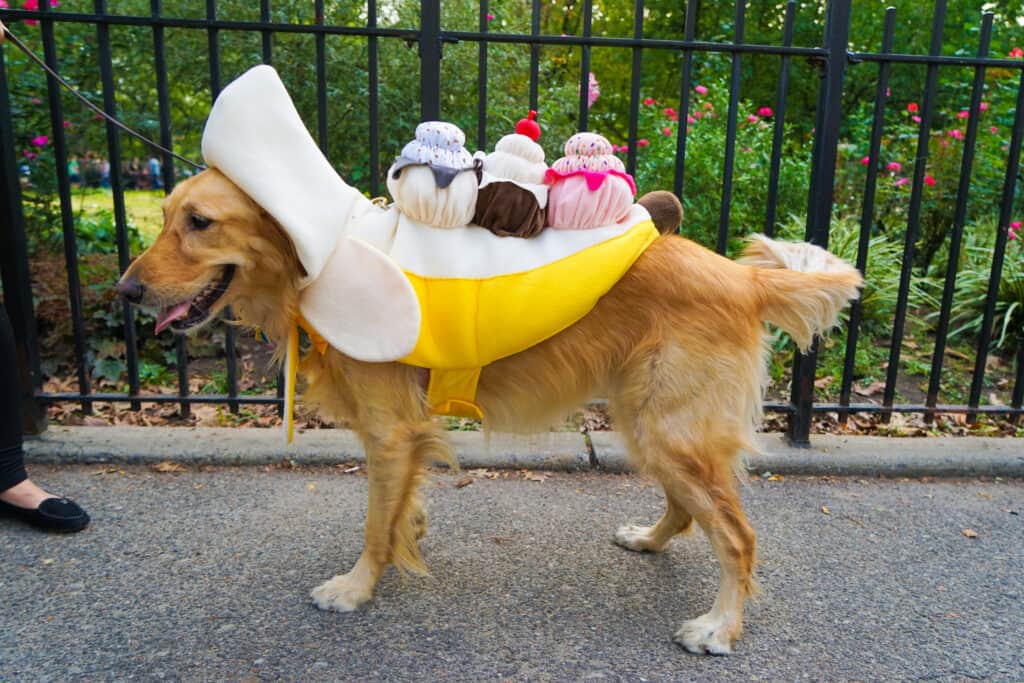
Dogs in Halloween costumes can make us smile, but their dietary needs are no laughing matter.
©Inspired By Maps/Shutterstock.com
Depending on your pet’s dietary needs, there are many dog foods to choose from. There are dog foods to help your pet gain weight and dog food to help them lose weight. There are even dog foods for allergies. Many owners start by first choosing wet vs. dry dog food and going from there. Some of the best dog food options are below:
- Best Overall Dog Food
- Best Organic Dog Food
- Best Dog Food For Allergies
- Best Wet Dog Food
- Best Dry Dog Food
- Best High-Calorie Dog Food
- Best Freeze-Dried Dog Food
Some house plants are poisonous to dogs, including Begonia, Poinsettia, and Aloe Vera. Many human food items are indigestible or toxic to dogs, such as chocolate, onion, garlic, macadamia nuts, xylitol, and nicotine. Diet-wise, dogs are omnivores and can handle a diet with more starch in it than a wolf, which is more strictly carnivorous.
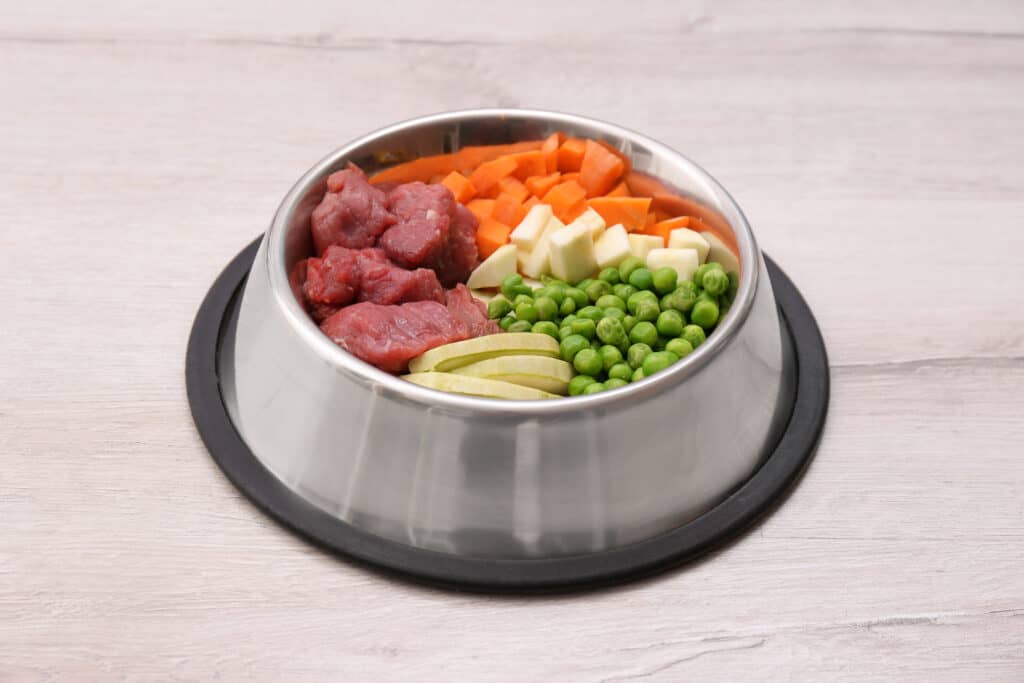
Dogs can eat meat, grains, fruit, and vegetables.
©New Africa/Shutterstock.com
Features
Dogs have a greater variance in behavioral and physical variation than any other land mammal, including wolves. Dogs have starch gel electrophoresis of red blood cell acid phosphatase. They also have smaller, compressed, and crumpled tympanic bullae. Physically, they have a more domed forehead and “stop” between the nose and forehead.
Wolves have a more prominent temporalis muscle (the muscle that closes the jaws) and do not have dew claws on their back legs. Dogs lack a pre-caudal gland and go into estrus twice instead of once a year. Whereas dogs usually have brown eyes, wolves have amber or pale-colored eyes. Their skin is thicker, and their paws are half the size of those of a wolf.
Dog Exceptions
There are several tribes of the subfamily Caninae. The dog-like tribe Canini is sister to the wolf-like tribe Vulpini. They are in the suborder Caniformia or Canoidea, the dog-like carnivorans. It stands in stark contrast to the cat-like carnivorans, the Feliformia or Feloidea suborder of Carnivora.
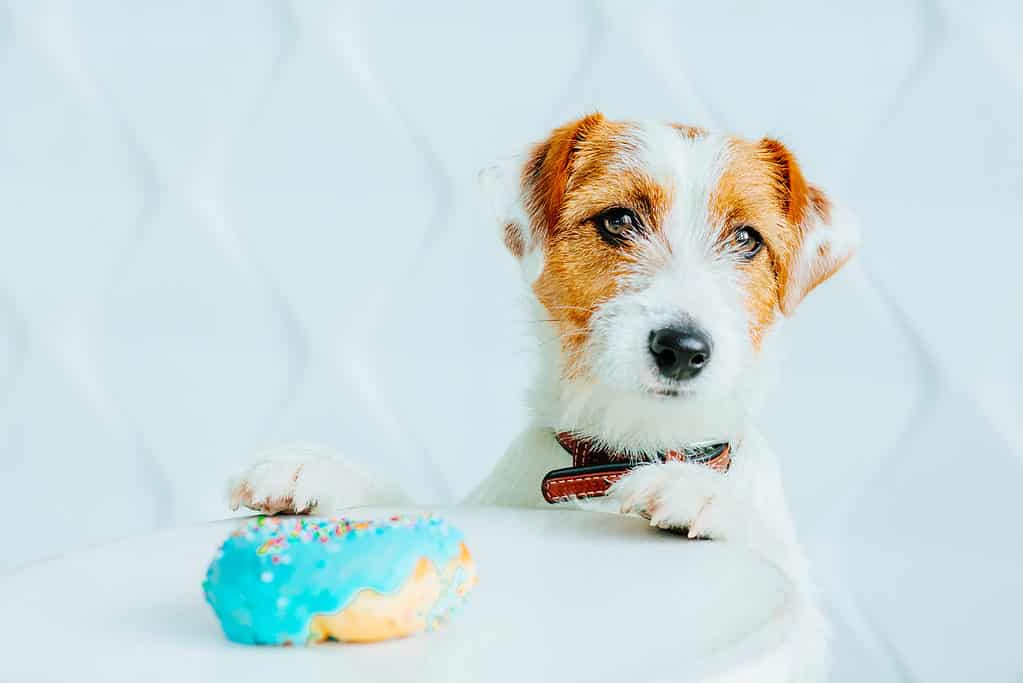
Dogs have brown eyes; wolves usually have amber-colored eyes.
©Iryna Inshyna/Shutterstock.com
Types of Dogs
Several types of dog groups are classified based on what they were bred to do:
Sporting dogs
Sporting dogs were bred to help their hunters capture and retrieve game birds. Retrievers swim and focus on waterfowl, while setters, spaniels, and pointers hunt game birds. Their coats are often thick and water-repellant to protect against the elements. Some examples of sporting dog breeds are Golden Retriever, Labrador Retriever, the Nova Scotia Duck Tolling Retriever, Cocker Spaniel, and German Shorthaired Pointer.
Hound dogs
Hound dogs were bred to chase after warm-blooded, terrestrial prey. They are generally divided into sighthounds, who use speed and vision to chase jackrabbits and antelopes, while scent hounds can use their noses to trail raccoons and people. All have strong prey drives. Some examples of hound dog breeds are Bloodhound, Greyhound, and Dachshund.
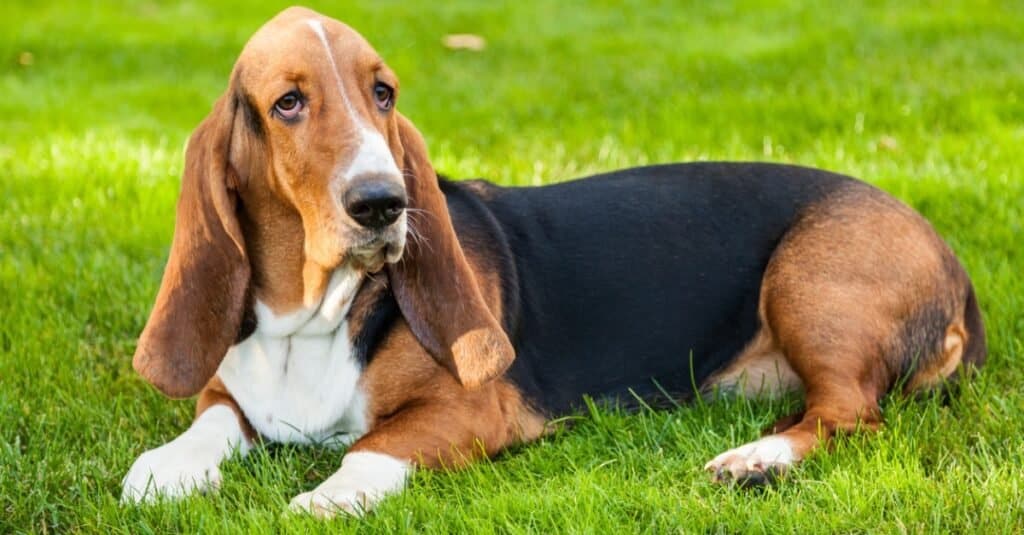
Hound dogs can follow a scent that is over 48 hours old.
©iStock.com/artisteer
Working dogs
Working dogs were bred to perform tasks such as guarding families or pulling sleds and carts. The Boxer, Great Dane, and Rottweiler and a few examples of working dog breeds.
Herding dogs
Herding dogs are a type of working dog, along with service dogs. While herding dogs help herd livestock, service dogs help people with disabilities. However, they differ in that they were bred specifically to herd livestock, such as sheep, cattle, and reindeer. Some are excellent for police and military work. A few examples of herding dog breeds are Border Collie, German Shepherd, and Icelandic Sheepdog.
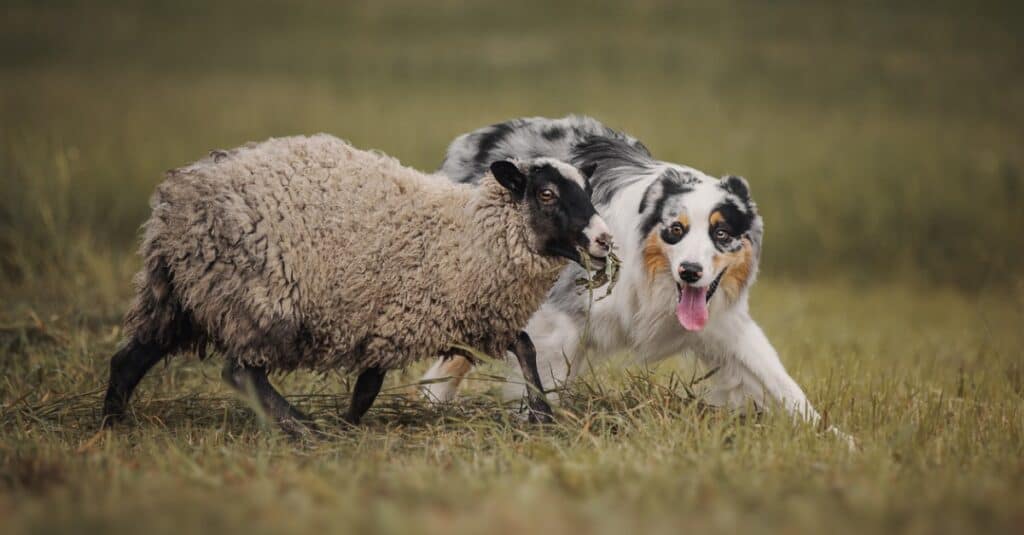
Herding dogs must have a sharp attention span.
©iStock.com/Julia_Siomuha
Terrier dogs
Terrier dogs were bred to be small in order to go after vermin hiding in the ground. They include terrier breeds, which have long legs to dig out rodents, and “bully” breeds, which were used for bull-baiting and now make companion dogs. Bull Terrier, Scottish Terrier, and Welsh Terrier are examples of terrier dog breeds. Some terrier breeds, like the Airedale Terrier, Kerry Blue Terrier, and the Irish Terrier, have curly fur.
Toy dogs
Toy dogs were bred for their small size to be companion dogs. They are perfect for city dwellers or anyone living in a small house. A few examples of toy dog breeds are Chihuahua, Pug, and Shih Tzu.
Non-sporting dogs
Non-sporting dogs do not fit into any of the other group types and were bred to be companion animals. The Bulldog, Dalmatian, and toy Poodle are a few examples of non-sporting dogs.
You can check out dogs that can protect you from dangerous animals, like mountain lions, while hiking.
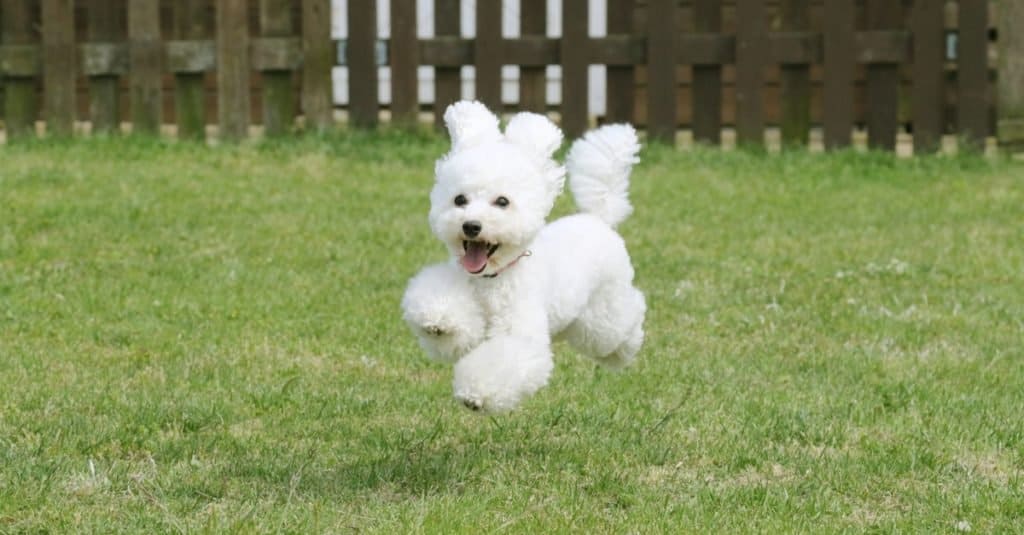
Toy poodles were bred for companionship.
©Rin Seiko/Shutterstock.com
Dog-wolf hybrids
Dogs share a common ancestor with modern wolves. Many large dog breeds have been bred with wolves, such as malamutes and huskies. Some are sought by private citizens, while others have been used for security work. For example, the Russians in the late 1990s created a breeding program for wolf-dog hybrids called Volkosoby or Volkosob, which are used for border control. See a list of 8 dogs that look like wolves here.
Types of Dogs
Aidi
The Aidi's cheerful personality and relaxed temperament are just two reasons why this dog is a good choice for families with kids.
Ainu
An innate sense of direction!
Airedoodle
This is a great pooch for rough-housing and one-to-one.
Akbash
Often used as a guard dog!
Akita
Very clean, intelligent and loyal!
Akita Shepherd
The Akita Shepherd descends from a lineage of working dogs.
Alaskan Husky
The Alaskan Husky is one of the most common sled dogs in the world
Alaskan Klee Kai
Alaskan Klee Kais love to communicate with their families. In addition to barking, they make other vocalizations, such as yodeling and howling.
Alaskan Shepherd
This dog’s Malamute ancestors once came to America across the Bering Strait.
Alusky
An Alusky loves to dig, so make sure your fence is planted deep in the ground to prevent any escapes!
American Bully
Though the American bully was bred to look intimidating, it makes an extremely friendly family pet!
American Leopard Hound
This breed is also known as the American Leopard Cur. The name was formally changed to American Leopard Hound in 2008.
American Pugabull
American Pugabulls are medium-sized dogs that weigh between 25 to 70 pounds, and their height measures 12 to 20 inches at the shoulder.
Apple Head Chihuahua
Apple Head Chihuahuas are toy breed dogs with a history dating back to ancient Mexico. They are lovable, loyal, smart and courageous with a lengthy lifespan despite being the world's smallest canines.
Armenian Gampr
Old school owners brush their coats with a rake once or twice a week, preventing major matting.
Aussiedoodle
The breed has its own popular Instagram page (Aussiedoodles Daily)!
Aussiedor
Aussiedors come in black, brown, cream, yellow, and almost every imaginable color due to their parentage!
Australian Shepherd Mix
This hybrid has powerful herding skills, which come with guarding instincts, so some Aussiedors may be protective of their loved ones.
Barbet
This dog has the nickname ‘Mud dog’ because it likes to play in muddy, swamp-like areas.
Bassador
This dog is also known as a Bassetdor or a Basset Lab.
Basset Fauve de Bretagne
A friendly and intelligent hunting dog that loves nothing more than to spend time with its owner.
Bassetoodle
Basset hounds have been around since the 7th century, but the bassetoodle made its first appearance in the 2000s.
Bea-Tzu
The Bea-Tzu has a fast-growing coat
Beabull
An excellent companion for cats!
Beagador
Beagadors like to dig, so make sure your garden has a good fence around it!
Beagle
Have become popular family pets!
Beagle Mix
Reagles are the best students as they love to learn new tricks, so training them is a breeze.
Beagle Shepherd
This dog can perform a wide range of exotic and acrobatic tricks that are not expected of a dog this size.
Beaglier
These dogs have great sniffer abilities
Beago
Beagos are good swimmers like their Golden Retriever parent.
Beaski
Beaskis love to play, so get ready to go on plenty of long walks.
Beauceron
The Beauceron is named after the place of its origin (Beauce) in France
Belgian Malinois Mix
These Belgian Malinois mixes can be scary when they are threatened. But it's important to note that they know when aggression is necessary. In other words, they will not attack unless they sense danger.
Belgian Shepherd
The sheepdog is also known as the Groenendael. All four Belgian varieties have nicknames for Belgian villages.
Bergamasco
Bergamascos are excellent problem solvers; they were bred to be independent as they work alongside their nomadic shepherd owners.
Bernedoodle
The Bernedoodle was first bred in 2003 to create a dog with a similar temperament to the Bernese Mountain Dog that would have a longer lifespan.
Bernese Mountain Dog Mix
This Bernese mountain dog mix gets very attached to its loved ones and demands plenty of attention.
Bichpoo
Despite its small size, the alert nature and sharp bark of this canine make it a good watch dog.
Black Mouth Cur
From the dog's description in the book, it is believed that Old Yeller was actually a Black Mouth Cur.
Boggle
Boggles at animal rescues are often mistaken for pitbulls because they have a similar facial structure.
Borador
Boradors make excellent police dogs and are used often on search and rescue missions.
Border Collie Mix
Because the border collsky's parent breeds were hardworking dogs, mainly used to herd animals and pull sleds, they will need proper socialization to cope with new people.
Bordoodle
Bordoodles are much quieter than other Doodles and require far less exercise.
Borkie
Most Borkies inherit the signature howl of their Beagle parent.
Bouvier Des Flandres
A Bouvier cannot achieve a champion title in Belgium unless it has already won a prize as a working police or military dog.
Boxachi
A Boxachi’s size can vary, so you won’t know how big they will get unless you adopt an adult. However, 40 pounds is the maximum weight they can reach.
Boxador
Boxadors are extremely smart and catch onto backyard games very quickly!
Boxer Mix
If cared for properly, boxadors can live for 10 to 15 years.
Boxerdoodle
The Boxerdoodle has a strong hunting dog lineage.
Boxsky
Boxers were bred to be working war dogs, and their boxsky descendants still love to help out on ranches and other outdoor jobs.
Boxweiler
Boxweilers come in a variety of colors, but they usually feature the subtle brindle pattern that their boxer parents are so famous for.
Braque Francais
The Braque Francais will not warn you of any potential threats but, instead, will try to befriend the stranger.
Brittany
The breed was formerly known as the Brittany spaniel
Brug
These small, confident dogs have no fear of approaching much larger dogs.
Brussels Griffon
The Brussels Griffon prefers to live with another dog so they have a companion to play with.
Bull and Terrier
Bull and Terriers were explicitly bred for bull-baiting, a savage blood sport where certain dog breeds would attack an angered bull tied to a pole.
Bullboxer
Bullboxers have several different breed nicknames, including the pitoxer, bullboxer pit, and the American bull boxer.
Bulldog
Friendly, loving and docile!
Bulldog Mix
Bulladors are notorious for having the best traits and mannerisms from both parents, as they are usually friendly, playful, and sociable.
Cane Corso
Cane Corsos nearly became extinct in the mid 1900’s, but the breed was revived by a group of Italians. Even so, they still didn’t become known in many other parts of the world until after 1988.
Catahoula Bulldog
Catahoula bulldogs are a medium to large-sized breed and weighs between 75 to 100 pounds!
Catalan Sheepdog
This breed is called the Gos d’Atura Catala in native Catalan and Pastor Catalan in Spanish, both of which roughly translate to mean Catalan Sheepdog
Caucasian Shepherd
These former bear-hunting dogs are used today as prison guard dogs in Russia.
Cava Tzu
Females are more territorial than males, but you can train this behavior out of them.
Cavador
A great companion for the whole family!
Cavapoo
The temperament of a Cavapoo allows this breed to make an excellent family dog as well as a great therapy dog.
Cesky Terrier
This breed is also known as the Bohemian Terrier (Bohemia was an historical Medieval kingdom and a region of the modern Czech Republic)
Cheagle
Some Cheagles have an excellent sense of smell.
Chihuahua Mix
Chihuahua mixes are referred to as lap dogs because they enjoy affection.
Chipit
While good with older children, the chipit does not like other pets unless they were socialized from a young age.
Chipoo
The Chipoo was first bred in the 1970s
Chorkie
Chorkies are very fond of their owners and will love to sit in their laps for long amounts of time!
Chow Chow
Loyal and affectionate to it's family!
Chusky
While Chuskies tend to gravitate towards one person in the household, one of their best qualities is their ability to get along with children of all ages.
Cockalier
The Cockalier has very strong hunting ancestry.
Cockapoo
Cockapoos became popular in the 1960s as a sweet, family dog.
Comfort Retriever
Comfort Retrievers can carry an egg in their mouths without breaking the shell because they have very soft mouths.
Corgidor
Corgidors are herding dogs that typically help out on cattle farms.
Corgipoo
These dogs are highly intelligent and are easy to train.
Corkie
One of the Corkie’s parent breeds, the Cocker Spaniel, was thought to have come over on the Mayflower.
Corman Shepherd
Corman Shepherds can be great watchdogs and are often very protective of their owners.
Coton de Tulear
The soft coat of the Coton de Tulear is the result of a singular genetic mutation early in the breed's development.
Croatian Sheepdog
They are an ancient breed dating back to the 7th century and made their way to Croatian lands giving them the name Croatian Sheep Dog.
Dachsador
This hybrid dog is also known as a Doxador or a Weinerdor.
Dachshund Mix
This Dachshund mix is generally not suited for multi-pet homes because of their high prey drive.
Dalmadoodle
Dalmatians were originally bred to run alongside carriages, and their dalmadoodle descendents have the same long legs and high energy.
Dalmador
Dalmador breeding skyrocketed after the 16 release of the live-action 101 Dalmatians movie.
Dalmatian
Have an energetic and playful nature!
Dandie Dinmont Terrier
The Dandie Dinmont Terrier is the only breed recognized by the AKC that is named after a literary character.
Dapple Dachshund
A Dapple Dachshund’s dappling pattern may be just one spot, or it may be numerous spots and splashes on their coat.
Daug
Because the Daug is so rare, they fetch a pretty penny. Dog lovers can pay up to $3,000 for one of these pups!
Dog
First domesticated in South-East Asia!
Dorgi
The Dorgi is one of the more popular mixed breed dogs.
Dorkie
Dorkies are so laid-back they sometimes need extra incentive to exercise each day.
Doxiepoo
Doxiepoos are an unpredictable breed that can come in a variety of appearances and sizes.
Doxle
Doxles have long floppy ears
Drever
Uncommon outside of Europe!
Dunker
A friendly and relaxed dog!
English Foxhound
English Foxhounds were bred to work and live in a pack. Because of this, this breed is happiest when they are around other dogs.
English Setter
English Setters were first bred between 400 and 500 years ago.
Eskipoo
Eskipoos are called pookimos by the American Canine Hybrid Club, Designer Dogs Kennel Club, and Designer Breed Registry.
Feist
The word feisty derived from this type of dog.
Fila Brasileiro
The breed has a unique, cat-like gait, while females have a finer gait than males.
French Bulldog
French bulldogs are known to be very sensitive, harboring emotions that they love to express
French Bulldog Mix
If successfully socialized and trained from a young age, these pups grow into well-mannered and friendly dogs that get along with children of all ages and other pets.
Frenchton
Loyal small dogs, the Frenchton will keep you warm at night with loving cuddles, but also awake with their funny loud snoring!
Frengle
Frengles have a haunting howl very similar to their Beagle parent.
German Longhaired Pointer
German Longhaired Pointers are excellent hunters-tracking, pointing, and retrieving game over land and water. They can jump up six feet high and make wonderful emotional support dogs!
German Shepherd Mix
These German shepherd mixes require a lot of mental stimulation; if they don't get it, they can become destructive.
German Sheppit
The German Sheppit is well-suited for guarding and police work.
German Sheprador
There is a chance that the German Sheprador may inherit a love for water from its parent.
German Shorthaired Pointer
German Shorthaired Pointers are used by the Air Force, TSA, and other organizations to sniff out explosives.
German Spitz
There are five different sub-breeds of the German Spitz.
Giant Schnoodle
Both parents of the Giant Schnoodle are hypoallergenic, making this one of the Doodle breeds that's safest for dander-sensitive owners.
Glechon
Glechons are talented in the area of search and rescue, as their sense of smell makes them great at tracking.
Goberian
These dogs are great around children and are very playful around them.
Goldador
Goldadors were not intentionally bred until the early 2000s!
Golden Dox
Golden doxes don't have to be tiny. This breed looks different depending on whether the mix includes a regular dachshund or the mini version of the species.
Golden Irish
They can be known as Velcro dogs because they like sticking around and are always near their owners.
Golden Newfie
These dogs love to swim and instinctively know how to swim.
Golden Pyrenees
Golden Pyrenees make great therapy dogs due to their intelligence and gentle nature.
Golden Retriever Mix
While gollies make good watchdogs since they generally bark when there is a newcomer at the door, they are not the best guard dogs. Instead of intimidating the stranger, they typically run up to the intruder and greet them with a waggy tail.
Golden Saint
Golden saints come in all kinds of colors. You can find them in tan, chocolate, yellow, brindled, spotted, and almost any other pattern you can think of.
Golden Shepherd
The Golden Shepherds were first recognized by the International Designer Canine Registry in 2009.
Goldendoodle
Due to their breeding, no two Goldendoodles are alike.
Gollie
They bark at strangers, cars, and loud noises like airplanes.
Great Dane Mix
Great Dane mixed breed dogs tend to have a longer lifespan than Great Dane purebreds.
Great Danoodle
Both Great Danes and Poodles are in the top 15 most popular AKC breeds - which makes Great Danoodles a shoo-in for popularity.
Great Pyrenees Mix
The collie Pyrenees is quite expensive, with puppies from reputable breeders starting at $1000. However, depending on the pedigree, and breeder, they can fetch twice that price.
Griffonshire
Griffonshires are so little they are easily mistaken for puppies throughout their lives.
Groenendael
These dogs are highly trainable and can learn excellent manners!
Harrier
Cheerful, tolerant and sweet-tempered!
Havamalt
These pups need natural oils to keep their skin healthy; bathing them often will dry out their skin, so only wash them when necessary.
Havanese
These are the only dogs that are native to Cuba
Havapoo
The exact appearance of a Havapoo can vary based on whether the genes of its Poodle or Havanese parent are more dominant.
Havashire
Both of the Havashire’s parent breeds were very popular among the upper classes.
Havashu
Their front legs are shorter than their back legs, giving them a unique, tilted physique.
Hokkaido
Known for its bravery and ability to withstand the cold.
Horgi
Horgis have a silly side and love to be the center of attention.
Huntaway
Huntaways have a strong instinct for herding.
Huskador
Huskadors are gaining in popularity as service dogs.
Huskita
Huskitas prefer a consistent daily routine with lots of activity.
Husky
To communicate, Siberian Huskies rarely bark but instead create their own music and howl.
Husky Jack
Due to the mix of genes, a Husky Jack’s coat may be a variety of colors including black, gray, white, red, sable, or mixed colors.
Huskydoodle
Huskydoodles are known for their jumping abilities!
Icelandic Sheepdog
The Icelandic Sheepdog is the only dog breed entirely native to Iceland.
Irish Doodle
Irish Doodles can be very active dogs, but they also love just hanging out with their family members in the house.
Irish Setter
Has a beautiful coat that's flowing and feathered!
Irish Terrier
An average 300 Irish Terrier puppies are born each year in the United States.
Italian Greyhound
The Italian Greyhound is a miniature dog with a big motor and personality!
Jack-Chi
The Jack-Chi dog is known as the yapping dog because of its insistent bark.
Jackabee
A good choice for owners who want an exercise companion!
Japanese Spitz
The Japanese Spitz is sometimes referred to as a cloud dog.
Kai Ken
Kai Ken are a very rare breed of dog from Japan, though pure breeds are even harder to come by.
Keagle
These adorable dogs are known for their love of children, strangers, and other animals because of their docile demeanor.
Keeshond
Friendly, alert dogs that are loyal to their owners
King Shepherd
This hybrid breed is the largest among the shepherd class.
Kishu
Once raised to hunt dangerous game like boar, today's kishu ken are more likely to be used as guard dogs.
Kooikerhondje
If Kooikerhondjes look familiar, it’s because old Dutch masters like Rembrandt and Jan Steen liked to paint them.
Koolie
The name "koolie" comes from the German mispronunciation of "collie."
Korean Jindo
At the 1988 Olympics in Seoul, Jindos marched in the opening ceremonies.
Kuvasz
Ownership of this dog was once restricted to the Hungarian nobility
Labahoula
The AKC does not recognize this breed or the parent breed Catahoula
Labrabull
Labrabulls are incredibly clever, and training them is easy because they love to please and don't have a stubborn bone in their body.
Labradane
Labradanes can come with both sold-color coats and the more exciting patterns that you typically see on Great Danes.
Labraheeler
A Labraheeler is a good choice for a watchdog as it do whatever it can to keep its family safe!
Labrottie
Labrotties will goof around clownishly to get laughs and attention.
Lagotto Romagnolo
The Lagotto Romagnolo is the only internationally recognized purebred truffle-hunting dog.
Lakeland Terrier
These dogs were once used by farmers to keep foxes away from herds of sheep.
Lancashire Heeler
The name “heeler” comes from the fact that it nips at the heels of cattle to herd them.
Landseer Newfoundland
While Landseer's are very gentle and calm, they can sense a dangerous situation and will protect their loved ones.
Lapponian Herder
This breed is also known as the Lapp Reindeer Dog and the Lapsk Vallhund.
Large Munsterlander
Some people might find the Large Munsterlander too lively for their family, but they are actually very gentle with children and make fantastic family pets.
Leonberger
This dog has been used for pulling carts full of goods.
Lhasa Apso
The Lhasa Apso was often given as a gift in Tibetan culture
Lhasapoo
A Lhasapoo’s coat can be curly like a poodle’s or long and silky like a Lhasa Apso’s.
Lowchen
This breed is also known as the "Little Lion Dog" for their bravery and manes.
Mal Shi
They are very needy dogs and can suffer from separation anxiety.
Malchi
The Malchi is not a purebred but a crossbreed and relatively new on the scene. That’s why they are not recognized by the American Kennel Club (AKC) or any other canine organization.
Malteagle
Malteagles are one of the smallest beagle hybrids and love to follow their owners everywhere.
Maltese Shih Tzu
Both parent breeds, the Maltese and Shih Tzu, once entertained royalty!
Maltipom
Maltipoms from the same litter may not look alike, favoring one parent over the other (Pomeranian or Maltese).
Maltipoo
Maltipoos may have one of three different coat types depending on the specific genes they inherit from their parents. These include silky, curly, or wavy.
Manchester Terrier
Fences are no match for Manchester terriers. They’re great escape artists!
Mastador
The Mastador gets its enormous size from its Mastiff parent.
Mastiff
Courageous, calm and affectionate!
Mastiff Mix
Don't let the boxmas's intimidating appearance and size fool you; they are actually gentle giants with even temperaments.
Mauzer
Mauzers tend to bond with a specific person in the home and will follow them like a shadow.
Meagle
The Meagle has an incredible sense of smell.
Miki
They can be trained to use the litter box like a cat!
Mini Labradoodle
The first mini labradoodle was bred in the early 1990s - almost immediately after standard labradoodles became popular.
Miniature Husky
The Miniature Husky has a double coat that it sheds twice annually. Also, some people confuse them with Alaskan Klee Kai, which have similar blue eyes.
Mongrel
Has characteristics of two or more breeds!
Morkie
A Morkie puppy can weigh as little as 4 ounces.
Moscow Watchdog
This Molosser-type dog is the Russian cousin of St. Bernard.
Mountain Feist
Mountain Feists were bred in the southern United States as a dog that could help with hunting small game.
Mudi
Mudi dogs have a reputation for being able to control a herd of 500 sheep.
Newfoundland
Introduced by Vikings more than 1,000 years ago!
Newfypoo
Newfypoos have a thick oily coat that can be hard to groom.
Norrbottenspets
Getting your hands on one of these pups might be a challenging task. At one point, the breed was on the brink of extinction.
Norwich Terrier
Though Norwich terriers are small, they have a reputation for being feisty.
Ori-Pei
Ori-Pei's are born with short noses, which causes them to grunt and make a lot of noise when they breathe.
Otterhound
Otterhounds have webbed feet making them great swimmers!
Papillon
Originally called the Toy Spaniel, the Papillon is one of the oldest breeds in the toy group. They can be found in artwork dating back to the 16th century.
Parti Schnauzer
Parti Schnauzers are great pest controllers. They were bred to catch rodents, so if you have a rat problem, they might be the pet for you.
Patterdale Terrier
A Patterdale Terrier’s small body structure allows it to squeeze into fox burrows.
Peagle
Most Peagles love playing with children and can be very gentle and affectionate!
Perro De Presa Canario
The breed has feet like a cat, with rounded toes that are not too close together. His unique feet give him a distinctive, long, elastic stride.
Picardy Spaniel
Picardy spaniels are one of the few working dogs that do well in apartments as long as they get their long walks every day.
Piebald Dachshund
Hotdogs were originally called "Dachshund sausages" because they resembled the dachshund's wiener-like body!
Pit Bull
It is a myth that pit bulls have locking jaws.
Pitador
There are several names for this breed, including the Labrabull or the Pitador Retriever.
Pitsky
Most Pitskies will do best as the only pet in a home. They may become aggressive with other dogs (especially two unneutered male dogs) and could try to chase or catch small pets due to their higher prey drive.
Plott Hound Mix
While the Plott hound is the state dog of North Carolina, it is a very rare breed and not well-known in other states.
Pocket Beagle
Queen Elizabeth I of England once owned several Pocket Beagles!
Pocket Pitbull
The smaller size of the Pocket Pitbull made it better suited for fleeing game as compared to larger Foxhounds.
Podenco Canario
It has a peculiar bark that locals refer to as "the song of the rabbit".
Pointer
An independent, loyal and high energy breed!
Pointer Mix
One of the best things about owning a pointer pit is its low-maintenance requirements.
Polish Lowland Sheepdog
Despite having shaggy hair that covers its eyes, this dog is known for its watchful gaze when guarding a herd.
Polish Tatra Sheepdog
This gigantic breed is known for its guardian skills, but they are non-aggressive and always manage to stay calm towards people and animals.
Pomapoo
Pomapoos like companionship and do not like being alone. They may do better in a home with other dogs.
Pomchi
A deliberate cross like the Pomchi is commonly referred to as a designer dog
Pomeagle
Pomeagles are sweet and fun dogs that like to spend time exploring their environment.
Pomeranian
The ancestors of the Pomeranian were sled dogs.
Pomsky
The howls and barks of a Pomsky can sound like singing
Poochon
The Poochon was first bred in Australia.
Poodle
Intelligent, alert and active!
Poogle
The Poogle is one of 40 different doodle dog breeds (poodle mixes).
Pudelpointer
Like their poodle parent, Pudelpointers love to swim in pools!
Pug
Fun and sociable, yet stubborn!
Pug Mix
The puggle is a heavy shedder, so to control any unwanted hair, owners must brush their pug mix at least twice a week.
Pugapoo
The pugapoo is the fusion of a pug and a poodle.
Puggle
These dogs are active and are often patient around children.
Pugshire
With their incredible desire to show affection, Pugshire make great lap dogs.
Pumi
Pumik developed their loud bark to communicate with shepherds at long distances.
Pyrador
Most popular as a companion pet!
Pyredoodle
Pyredoodles can have a thick double coat or a thinner single coat.
Raggle
Raggles are known for their energy and curiosity.
Rat Terrier
Rat terriers were popular with farmers before 1930 because of their ability to kill rodents.
Rotterman
Rottermans are the perfect breed for search and rescue training, and they make excellent guard dogs.
Rottsky
Many Rottskies have one brown eye and one blue eye.
Rottweiler Mix
This Rottweiler mix is devoted to its loved ones and usually forms a strong bond with its primary caregiver
Russell Terrier
The Russell Terrier was bred to be a good fox hunter with a keen sense of smell
Sable Black German Shepherd
According to the American Kennel Club, the German Shepherd is the second most popular breed in the United States
Saint Shepherd
These dogs have an eager-to-please attitude, making them sweet and happy pets.
Saluki
The Saluki is one of the fastest dog breeds in the world.
Sapsali
Natives know this breed as the "ghost hunter" because they believe these dogs can ward off evil spirits.
Schapendoes
The Schapendoes numbers decreased significantly during the Second World War, along with many other European Sheepdog breeds.
Schipperke
Schipperkes were used to hunt and kill rodents on Belgian ships.
Schneagle
This hybrid dog is a great companion and doesn’t do well being left alone but is suitable for apartments or houses with backyards!
Scotch Collie
Scotch collies are one of the oldest collie breeds and were eventually bred to create the more popular border collie!
Scottish Terrier
This breed is nicknamed the “Diehard” because of its iron will and steely determination.
Sealyham Terrier
Very endangered breed that is scion of several breeds that include one that is already extinct
Sheepadoodle
Sheepadoodles were first bred as an experiment for use as a military dog in the Army in the 1960s, however they didn’t really gain popularity until 2007.
Shepadoodle
Some police officers with allergies use Shepadoodles as their K-9 partner
Shepkita
These dogs can sometimes be overly aggressive.
Shepweiler
The Shepweiler is an excellent guard dog.
Shetland Sheepdog
Shetland Sheepdogs are one of the most successful breeds at obedience trials.
Shiba Inu
Shiba Inus are one of six native dog breeds from Japan.
Shichi
Shichi barely reach 10 inches tall and weigh around 9 to 16 pounds.
Shih Tzu Mix
Despite having long, flowing hair, Shih Tzus and many of their hybrids are hypoallergenic.
Shikoku
This dog was declared a Japanese Natural Monument in 1937.
Shiranian
The Shiranian is an affectionate, loving, and social dog but requires continuous human companionship to stay well-adjusted and happy.
Shollie
Shollies are a fairly new type of crossbreed!
Siberian Husky
Siberian Huskies stay adequately warm in sub-zero temperatures.
Siberpoo
Although a lack of documentation makes it unclear, the first Siberpoo was probably bred in either the 1970s or 1980s.
Silky Terrier
Silky terriers can be trained to participate in many events, including herding, agility, rally, tracking and fly ball.
Silver Labrador
The Labrador is the most popular breed in the United States and most of these dogs have blue eyes at a young age, before they turn another color.
Skye Terrier
Skye terriers are the oldest terrier breed, dating back at least 400 years.
Snorkie
Snorkies are known for their funny, attention-getting antics.
Spanish Mastiff
Diego Velázquez’s famous 17th century painting of the Infanta and her dwarves includes a portrait of a Spanish Mastiff.
Spanish Water Dog
Spanish water dogs are popular with fishermen and hunters to retrieve game from the water.
Springerdoodle
Easygoing, intelligent, and active, the springerdoodle just loves being around people!
Stabyhoun
It is a versatile, all-around working breed and pet.
Taco Terrier
Taco terriers are known by a variety of names, including the Chitoxy Toy and the Chiwoxy.
Teacup Chihuahua
Teacup Chihuahuas are not a separate breed but result from breeding the smallest pups from litters.
Teddy Roosevelt Terrier
The breed was named in President Theodore Roosevelt's honor when it was officially recognized in 1999.
Tenterfield Terrier
These terriers have quick minds and fast feet making them excellent for agility competitions.
Terrier
Terriers were once the greatest dogs in the world.
Texas Heeler
Though they are loyal to their family, these dogs can be shy around strangers.
Thai Ridgeback
In their native Thailand, Thai Ridgebacks were used to hunt cobras.
Tibetan Spaniel
Originally bred to be a companion dog in Tibetan Buddhist lamaseries.
Tibetan Terrier
Tibetan terriers have round, flat, “snow shoe” feet that evolved to give them traction on snowy Himalayan paths
Torkie
The Torkie is alert and very vocal so it makes a great watchdog.
Tornjak
Tornjaks are very adaptable and can live harmoniously in packs as they get along well with other dogs.
Toy Fox Terrier
Hunters use the toy fox terrier to go into a fox's den and flush the animal out.
Toy Poodle
The word poodle is derived from German, and it means "to splash" or "puddle."
Turnspit
The turnspit was a small breed, weighing between 15 to 25 pounds and measuring 8 to 12 inches tall.
Valley Bulldog
These dogs cannot swim well because of their stocky build and short legs.
Vizsla
Vizsla means searcher or tracker in Hungarian
Volpino Italiano
Almost went extinct before American Eskimo Dog breeders showed interest.
Weimaraner
The Weimaraner is nicknamed the gray ghost.
Weimardoodle
This dog is also known as the Weimarpoo, the Weimaranerpoo, and the Weimaranerdoodle.
Welsh Springer Spaniel
Due to being so attached to their owners, the Welsh Springer Spaniel does not do well with being left alone and can experience separation anxiety.
Welsh Terrier
The Welsh Terrier has the strength and tenacity to take on foxes and badgers.
Westiepoo
This dog is known for cocking its head in a curious manner when listening to its owner.
Wheaten Terrier
Originally bred as a farm dog, the Wheaten Terrier can be very protective of its domain.
Whippet
Quiet, gentle and restful dogs!
White German Shepherd
It was once thought that White German Shepherds were albinos, but that is not the case. Its white coat is part of the overall German Shepherd genetic composition.
Wire Fox Terrier
The Wire Fox Terrier was bred from the now extinct Rough Coated Black and Tan Terrier to hunt down foxes.
Yakutian Laika
The Yakute people were likely the first to use dogs to pull sleds, so the Yakutian Laika was probably among the first sled dogs.
Yoranian
These dogs are very intelligent and are great with children.
Yorkie Bichon
Yorkie Bichons can come in a wide range of colors including black, white, blonde, gray, golden, or dark brown.
Yorkiepoo
The Yorkie-Poo originated from the hybrid poodle phase of the late 20th century
Zuchon
The breed often changes colors throughout its life, with its puppy coat becoming lighter over the first few years of life, then darkening as he ages.
List of Dog Breeds
- Affenpinscher
- Afghan Hound
- Aidi
- Ainu
- Airedale Terrier
- Airedoodle
- Akbash
- Akita
- Akita Shepherd
- Alabai (Central Asian Shepherd)
- Alaskan Husky
- Alaskan Klee Kai
- Alaskan Malamute
- Alaskan Shepherd
- Alpine Dachsbracke
- Alusky
- American Alsatian
- American Bulldog
- American Bully
- American Cocker Spaniel
- American Coonhound
- American Eskimo Dog
- American Foxhound
- American Hairless Terrier
- American Leopard Hound
- American Pit Bull Terrier
- American Pugabull
- American Staffordshire Terrier
- American Water Spaniel
- Anatolian Shepherd Dog
- Appenzeller Dog
- Apple Head Chihuahua
- Armenian Gampr
- Aussiedoodle
- Aussiedor
- Aussiepom
- Australian Bulldog
- Australian Cattle Dog
- Australian Kelpie Dog
- Australian Labradoodle
- Australian Retriever
- Australian Shepherd
- Australian Shepherd Mix
- Australian Terrier
- Azawakh
- Barbet
- Basenji Dog
- Basenji Mix
- Bassador
- Basset Fauve de Bretagne
- Basset Hound
- Bassetoodle
- Bavarian Mountain Hound
- Bea-Tzu
- Beabull
- Beagador
- Beagle
- Beagle Mix
- Beagle Shepherd
- Beaglier
- Beago
- Bearded Collie
- Beaski
- Beauceron
- Bedlington Terrier
- Belgian Laekenois
- Belgian Malinois
- Belgian Malinois Mix
- Belgian Sheepdog
- Belgian Shepherd
- Belgian Tervuren
- Bergamasco
- Berger Blanc Suisse
- Berger Picard
- Bernedoodle
- Bernese Mountain Dog
- Bernese Mountain Dog Mix
- Bernese Shepherd
- Bichon Frise
- Bichpoo
- Biewer Terrier
- Black And Tan Coonhound
- Black Mouth Cur
- Black Russian Terrier
- Bloodhound
- Blue Lacy Dog
- Blue Picardy Spaniel
- Bluetick Coonhound
- Boerboel
- Boggle
- Boglen Terrier
- Bolognese Dog
- Borador
- Border Collie
- Border Collie Mix
- Border Terrier
- Bordoodle
- Borkie
- Boston Terrier
- Bouvier Des Flandres
- Boxachi
- Boxador
- Boxer Dog
- Boxer Mix
- Boxerdoodle
- Boxsky
- Boxweiler
- Braque du Bourbonnais
- Braque Francais
- Brazilian Terrier
- Briard
- British Timber
- Brittany
- Brug
- Brussels Griffon
- Bull and Terrier
- Bull Terrier
- Bullboxer
- Bulldog
- Bulldog Mix
- Bullmastiff
- Cairn Terrier
- Canaan Dog
- Canadian Eskimo Dog
- Cane Corso
- Carolina Dog
- Catahoula Bulldog
- Catahoula Leopard
- Catalan Sheepdog
- Caucasian Mountain Dog (Shepherd)
- Caucasian Shepherd
- Cava Tzu
- Cavador
- Cavalier King Charles Spaniel
- Cavapoo
- Cesky Fousek
- Cesky Terrier
- Cheagle
- Chesapeake Bay Retriever
- Chi Chi
- Chihuahua
- Chihuahua Mix
- Chinese Crested Dog
- Chinese Shar-Pei
- Chinook
- Chipit
- Chipoo
- Chiweenie
- Chorkie
- Chow Chow
- Chow Shepherd
- Chusky
- Clumber Spaniel
- Cockalier
- Cockapoo
- Cocker Spaniel
- Collie
- Comfort Retriever
- Corgidor
- Corgipoo
- Corkie
- Corman Shepherd
- Coton de Tulear
- Croatian Sheepdog
- Curly Coated Retriever
- Czechoslovakian Wolfdog
- Dachsador
- Dachshund
- Dachshund Mix
- Dalmadoodle
- Dalmador
- Dalmatian
- Dandie Dinmont Terrier
- Daniff
- Danish Swedish Farmdog
- Dapple Dachshund
- Daug
- Deer Head Chihuahua
- Deutsche Bracke
- Doberman Pinscher
- Dog
- Dogo Argentino
- Dogue De Bordeaux
- Dorgi
- Dorkie
- Double Doodle
- Doxiepoo
- Doxle
- Drever
- Dunker
- Dutch Shepherd
- English Bulldog
- English Cocker Spaniel
- English Cream Golden Retriever
- English Foxhound
- English Pointer
- English Setter
- English Shepherd
- English Springer Spaniel
- English Toy Terrier
- Entlebucher Mountain Dog
- Epagneul Pont Audemer
- Eskimo Dog
- Eskipoo
- Estrela Mountain Dog
- Feist
- Field Spaniel
- Fila Brasileiro
- Finnish Lapphund
- Finnish Spitz
- Flat-Coated Retriever
- Formosan Mountain Dog
- Fox Terrier
- French Bulldog
- French Bulldog Mix
- Frenchton
- Frengle
- Gerberian Shepsky
- German Longhaired Pointer
- German Pinscher
- German Shepherd Guide
- German Shepherd Mix
- German Sheppit
- German Sheprador
- German Shorthaired Pointer
- German Spitz
- German Wirehaired Pointer
- Giant Schnauzer
- Giant Schnoodle
- Glechon
- Glen Of Imaal Terrier
- Goberian
- Goldador
- Golden Dox
- Golden Irish
- Golden Newfie
- Golden Pyrenees
- Golden Retriever
- Golden Retriever Mix
- Golden Saint
- Golden Shepherd
- Goldendoodle
- Gollie
- Gordon Setter
- Great Dane
- Great Dane Mix
- Great Danoodle
- Great Pyrenees
- Great Pyrenees Mix
- Greater Swiss Mountain Dog
- Greenland Dog
- Greyhound
- Griffonshire
- Groenendael
- Harrier
- Havamalt
- Havanese
- Havapoo
- Havashire
- Havashu
- Hokkaido
- Horgi
- Hovawart
- Huntaway
- Huskador
- Huskita
- Husky
- Husky Jack
- Huskydoodle
- Ibizan Hound
- Icelandic Sheepdog
- Irish Doodle
- Irish Setter
- Irish Terrier
- Irish Water Spaniel
- Irish WolfHound
- Italian Greyhound
- Jack Russells
- Jack-Chi
- Jackabee
- Japanese Chin
- Japanese Spitz
- Japanese Terrier
- Kai Ken
- Kangal Shepherd Dog
- Keagle
- Keeshond
- Kerry Blue Terrier
- King Shepherd
- Kishu
- Komondor
- Kooikerhondje
- Koolie
- Korean Jindo
- Kuvasz
- Labahoula
- Labmaraner
- Labrabull
- Labradane
- Labradoodle
- Labrador Retriever
- Labraheeler
- Labrottie
- Lagotto Romagnolo
- Lakeland Terrier
- Lancashire Heeler
- Landseer Newfoundland
- Lapponian Herder
- Large Munsterlander
- Leonberger
- Lhasa Apso
- Lhasapoo
- Long-Haired Rottweiler
- Lowchen
- Lurcher
- Mal Shi
- Malchi
- Malteagle
- Maltese
- Maltese Shih Tzu
- Maltipom
- Maltipoo
- Manchester Terrier
- Maremma Sheepdog
- Mastador
- Mastiff
- Mastiff Mix
- Mauzer
- Meagle
- Miki
- Mini Labradoodle
- Miniature Bull Terrier
- Miniature Husky
- Miniature Pinscher
- Mongrel
- Morkie
- Moscow Watchdog
- Mountain Cur
- Mountain Feist
- Mudi
- Neapolitan Mastiff
- Newfoundland
- Newfypoo
- Norfolk Terrier
- Norrbottenspets
- Northern Inuit Dog
- Norwegian Buhund
- Norwegian Elkhound
- Norwegian Lundehund
- Norwich Terrier
- Nova Scotia Duck Tolling Retriever
- Old English Sheepdog
- Ori-Pei
- Otterhound
- Papillon
- Parson Russell Terrier
- Parti Schnauzer
- Patterdale Terrier
- Peagle
- Pekingese
- Pembroke Welsh Corgi
- Perro De Presa Canario
- Peruvian Inca Orchid
- Petit Basset Griffon Vendéen
- Petite Goldendoodle
- Pharaoh Hound
- Picardy Spaniel
- Piebald Dachshund
- Pit Bull
- Pitador
- Pitsky
- Plott Hound Mix
- Plott Hounds
- Pocket Beagle
- Pocket Pitbull
- Podenco Canario
- Pointer
- Pointer Mix
- Polish Lowland Sheepdog
- Polish Tatra Sheepdog
- Pomapoo
- Pomchi
- Pomeagle
- Pomeranian
- Pomsky
- Poochon
- Poodle
- Poogle
- Pudelpointer
- Pug
- Pug Mix
- Pugapoo
- Puggle
- Pugshire
- Pumi
- Pyrador
- Pyredoodle
- Pyrenean Shepherd
- Raggle
- Rat Terrier
- Redbone Coonhound
- Rotterman
- Rottle
- Rottsky
- Rottweiler
- Rottweiler Mix
- Russell Terrier
- Russian Bear Dog
- Saarloos Wolfdog
- Sable Black German Shepherd
- Saint Bernard
- Saint Shepherd
- Saluki
- Samoyed
- Sapsali
- Sarplaninac
- Schapendoes
- Schipperke
- Schneagle
- Schnoodle
- Scotch Collie
- Scottish Terrier
- Sealyham Terrier
- Sheepadoodle
- Shepadoodle
- Shepkita
- Shepweiler
- Shetland Sheepdog
- Shiba Inu
- Shiba Inu Mix
- Shichi
- Shih Poo
- Shih Tzu
- Shih Tzu Mix
- Shikoku
- Shiloh Shepherd
- Shiranian
- Shollie
- Siberian Husky
- Siberian Retriever
- Siberpoo
- Silky Terrier
- Silver Labrador
- Skye Terrier
- Slovak Cuvac
- Smooth Fox Terrier
- Snorkie
- Spanador
- Spanish Mastiff
- Spanish Water Dog
- Spinone Italiano
- Springerdoodle
- Stabyhoun
- Staffordshire Bull Terrier
- Standard Schnauzer
- Swedish Elkhound
- Swedish Lapphund
- Swedish Vallhund
- Taco Terrier
- Tamaskan
- Teacup Chihuahua
- Teacup Maltese
- Teacup Poodle
- Teddy Roosevelt Terrier
- Tenterfield Terrier
- Terrier
- Texas Heeler
- Thai Ridgeback
- Tibetan Mastiff
- Tibetan Spaniel
- Tibetan Terrier
- Torkie
- Tornjak
- Toy Fox Terrier
- Toy Poodle
- Transylvanian Hound
- Treeing Tennessee Brindle
- Treeing Walker Coonhound
- Turnspit
- Utonagan
- Valley Bulldog
- Vizsla
- Volpino Italiano
- Weimaraner
- Weimardoodle
- Welsh Corgi
- Welsh Springer Spaniel
- Welsh Terrier
- West Highland Terrier
- West Siberian Laika
- Westiepoo
- Wheaten Terrier
- Whippet
- White German Shepherd
- Whoodle
- Wire Fox Terrier
- Wirehaired Pointing Griffon
- Xoloitzcuintli
- Yakutian Laika
- Yoranian
- Yorkie Bichon
- Yorkiepoo
- Yorkshire Terrier
- Zuchon
Dog Breeds by Letter Pages
- Dog Breeds that Start with A
- Dog Breeds that Start with B
- Dog Breeds that Start with C
- Dog Breeds that Start with D
- Dog Breeds that Start with E
- Dog Breeds that Start with F
- Dog Breeds that Start with G
- Dog Breeds that Start with H
- Dog Breeds that Start with I
- Dog Breeds that Start with J
- Dog Breeds that Start with K
- Dog Breeds that Start with L
- Dog Breeds that Start with M
- Dog Breeds that Start with N
- Dog Breeds that Start with O
- Dog Breeds that Start with P
- Dog Breeds that Start with Q
- Dog Breeds that Start with R
- Dog Breeds that Start with S
- Dog Breeds that Start with T
- Dog Breeds that Start with U
- Dog Breeds that Start with V
- Dog Breeds that Start with W
- Dog Breeds that Start with X
- Dog Breeds that Start with Y
- Dog Breeds that Start with Z
Even More Information on Dog Breeds
There are so many fascinating things to learn about dogs! Which breeds are the smartest or most expensive? Which dog breeds are the best choices for apartment living or emotional support? What are the best names for a yellow dog versus a white dog? Here are some additional articles to check out if you want to learn more:
- How Many Dogs Are In The World?
- Top 10 Wild Dog Breeds In the World
- The 10 Most Expensive Dog Breeds
- Can Dogs Eat Cicadas?
- The Top 9 Smallest Dogs in the World
- The Top 15 Biggest Dogs in the World
- The 10 Best Dog Names in the World
- Top 10 World’s Smartest Dog Breeds
- The 10 Best Dog Breeds: Ranked
- Best Big Dog Breeds
- Best Apartment Dogs: The Definitive 9 Picks
- Top 8 Dogs that Look Like Wolves
- The 10 Best Family Dog Breeds That Are Good with Kids
- Presidential Dogs: The Complete Guide to the First Dogs of The U.S.
- Best Dogs for City Living: The Definitive List
- The Top 8 Oldest Dogs Ever
- 25 Dog Facts for Kids
- How Old is My Dog in Human Years?
- Why Do Dogs Shed?
- Top 10 Ugliest Dog Breeds
- Top 9 Prettiest & Cutest Dog Breeds
- Top 10 Strongest Dogs
- Top 10 Cheapest Dogs
- Top 10 Most Popular Dogs
- The Top 8 Scariest Dog Breeds
- Top 10 Meanest Dogs
- Top 8 Strangest Dog Breeds
- Top 10 Softest Dog Breeds
- Top 10 Calmest Dogs
- Top 10 Toughest Dog Breeds in the World
- 11 White Dog Breeds & White Dog Names
- 6 Black Dog Breeds & Black Dog Names
- 10 Brown Dog Breeds & Brown Dog Names
- 8 Red Dog Breeds & Red Dog Names
- 8 Gray Dog Breeds & Gray Dog Names
- 6 Orange Dog Breeds & Orange Dog Names
- 8 Yellow Dog Breeds & Yellow Dog Names
- Dogs with the Highest Bite Force
- Are Dogs Mammals?
- What Are Wolfdogs and Do They Make Good Pets?
- White Fluffy Dog Breeds
- Cute and Unique Dog Names
- 8 Best Guard Dogs
- Strongest Dog Breed Bite
- The Top 10 Types of Terrier Dogs
- 9 Types of Service Dogs
- Types of Hound Dog Breeds
- Types of Herding Dogs
- Types of Aggressive Dogs
- Types of Husky Dogs
- Types of Hunting Dog Breeds
- Types of Seizures in Dogs
- Types of Pointer Dogs
- Types of Guard Dog Breeds
- Types of Big Dogs
- 10 Types of Wild Dogs
- Types of Retriever Dogs
- Types of Emotional Support Dogs
- Types of Boxer Dogs
- Types of Police Dogs
- Types of Working Dogs
- Coolest Dog Breeds
- Top 20 Tri-colored Breeds
Share on:
About the Author
Heather Hall
Heather Hall is a writer at A-Z Animals, where her primary focus is on plants and animals. Heather has been writing and editing since 2012 and holds a Bachelor of Science in Horticulture. As a resident of the Pacific Northwest, Heather enjoys hiking, gardening, and trail running through the mountains with her dogs.
FAQs (Frequently Asked Questions)
What is a dog?
Any canine descended from the domesticated common ancestor of dogs and wolves, in the family Canidae, genus Canis.
What is the largest dog?
The largest dog ever depends if you’re looking at the tallest, longest or heaviest. Freddy the Great Dane in England measured 40.75 inches tall, while the Old English Mastiff Aicama Zorba in England measured 8 feet, 3 inches from nose to tail and was also the heaviest dog in the world at 343lbs. Great Danes are the tallest dog breed and English Mastiffs are the heaviest.
What is the smallest dog?
The smallest dog in terms of height is a Chihuahua in Puerto Rico named Milly, who measured 9.65 cm (3.8 in) tall. The smallest dog breed is the Chihuahua.
What did dogs evolve from?
Dogs evolved and genetically diverged from a common ancestor with wolves in the Late Pleistocene era about 11,700 years ago. The grey wolf is the closest living relative of the dog, with cross-breeding having occurred during the dog’s domestication. There is no agreement as to when dogs were domesticated, but the process occurred somewhere around 11,000 years ago when hunter-gatherers closely associated with live populations of aurochs, beer, sheep and goats after beginning an association with wolves.
What are the different types of dogs?
There are 7 types of dogs: Sporting, Hound, Herding, Working, Terrier, Toy and Non-sporting.
What is the scientific name for a dog?
Canis familiaris is the scientific name for a dog if it’s considered a distinct species from the wolf. It’s Canis lupus familiaris if considered a subspecies of the wolf.
What is the most dangerous dog breed?
Prey dogs are considered to be the most dangerous due to their strong bite and large muscle mass. The Pit Bull is currently said to be the most dangerous dog breed, although the Rottweiler and Inu also have a reputation for being dangerous at different times or in different areas of the world.
Are Dogs really color blind?
No, they do not see in black-and-white. However, they are red-green color-blind.
What are some examples of small dog breeds?
Chihuahua, Boston Terrier, Shih Tzu, Pug, and Dachshund are some small dog breeds.
Are bears related to dogs?
Both animals are not directly related. Dogs and bears are both within the suborder Caniformia but they belong to different families.
Are lilies poisonous to dogs and cats?
Lilies are poisonous to dogs and cats. Although lilies are only mildly toxic to most dogs, they can be a much more serious threat to your feline friend. When a dog eats a lily, it may experience stomach issues, but usually nothing life-threatening. When a cat ingests lilies, the symptoms can range from mild to life-threatening
Are orchids poisonous to cats or dogs?
Orchids, notably the Phalaenopsis Orchid (or Moth Orchid), are safe for dogs and cats to be around. These plants are one of the few ones that are considered non-toxic to both cats and dogs.
Are Onions Poisonous To Dogs Or Cats?
You may be surprised to learn that dogs and cats can become poisoned by all parts of the onion, including the leaves, flesh, skin, and juice, whether cooked or uncooked. And, cats and dogs are not just poisoned by the typical onion, but all vegetables in the onion family! That’s right; the entire onion family, whether they’re dehydrated or powdered, can deplete a pet’s red blood cells and lead to anemia.
Are Mums Poisonous To Dogs Or Cats?
There are several species of mums, all of which are deemed poisonous to dogs and cats. Even dried-up mums are harmful to pets**.** Scientists say mums are only “mildly toxic” to pets when compared to most toxic plants. Despite this, pet owners should still seek immediate medical attention if they notice any of the following toxic effects associated with mums:
Are Marigolds Poisonous To Dogs or Cats?
The ASCPA defines Marigolds as non-toxic to cats and dogs. But this is particularly peculiar to the Pot Marigold. Yet, if your dog or cat eats too many of these attractive flowers, they may experience negative effects like stomach upset. The side effect, however, is not caused by any toxicity from the flower but as a result of eating something unusual. On the other hand, the Tagetes species is known to create more issues for pets, particularly cats. This toxicity is usually relatively moderate, but it needs to
Are succulents poisonous to dog or cats?
Not all succulents are poisonous to dogs and cats. Succulents are great for pet owners, as most types are perfectly safe for pets. Sempervivum, Burros Tail, Christmas Cactus, Zebra Haworthia, e.t.c., are succulent species that are safe for pets. Other succulent species like the Jade plant, Aloe Vera, Fiddle leaf, e.t.c., are poisonous to dogs.
Are Begonias Poisonous To Dogs or Cats?
Despite being beautiful plants, begonias are poisonous to dogs and cats. So your pet shouldn’t eat any part of this houseplant. More than a thousand species of begonia exist and all are poisonous to animals. Although the roots contain most of the poison, all parts of begonias should be always kept out of the reach of your pets.
Are Petunias Poisonous To Dogs or Cats?
For pet-friendly gardeners, petunias are an excellent choice of flower. The petunia plant is not toxic to cats or dogs, making it a safe option for households with several pets. But this doesn’t make them a food option for your pets. Discourage your dogs and cat from eating houseplants whether they are toxic or not. So if your pet accidentally eats petunias, you have nothing to worry about. Non-toxic species of petunias include Grandiflora, Multiflora, Milli flora, and so on.
Are Frogs Poisonous To Dogs or Cats?
Although all frogs produce skin fluids, most of them are not poisonous to domestic pets. But this is not the case for pickerel and tree frogs. Both pickerel and tree frogs are commonly found in the United States. They release toxins in their skin as a defense whenever they are attacked by predators. And if your dog or cat bites these frogs, the toxins can make them sick.
Are acorns poisonous to dogs?
Acorns can be harmful to dogs if consumed in copious quantities.
Are azaleas poisonous to dogs?
Grayanotoxin, a neurotoxin found in azaleas, is the source of the plant’s danger to your dog. Azalea pollen, petals, and leaves all contain the poison.
Are poinsettias poisonous to dogs?
Poinsettias are not poisonous to dogs. However, they are mildly toxic when ingested.
Are hibiscus poisonous to dogs?
While most hibiscus species are safe for dogs, some hibiscus varieties can be potentially hazardous to your dog.
Are hostas poisonous to dogs?
It’s best to keep your dogs away from hosta leaves, stems, and blooms, which are toxic to dogs. They are toxic to dogs because of the poison’s glycoside saponins.
Can a fox outrun a dog?
The deciding factor comes down to strength and endurance versus agility and speed. If the fox has a good lead against a solitary dog, the fox will always escape. However, the dog has a natural advantage in a pack.
Who would win a fight: Dogs Vs Porcupines?
A porcupine would win a fight against a dog, but this would be a close one.
If we have a situation where the dog is the aggressor, and the porcupine is attacked, the dog gets too many quills in it to continue its assault. The dog is forced to leave the porcupine alone because it’s in so much pain or has too many quills to bite effectively. In this case, the porcupine wins.
Thank you for reading! Have some feedback for us?
Thank you for your feedback!
We appreciate your help in improving our content.
Our editorial team will review your suggestions and make any necessary updates.
There was an error submitting your feedback. Please try again.
